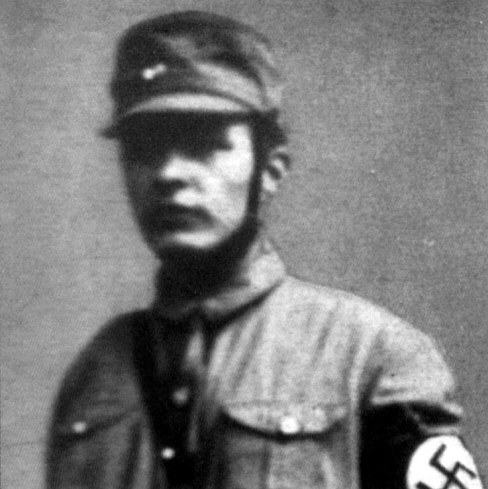
Blood Martyrs of the National Socialist Movement
The Year 1932
Kurt Wietfeld
(* 25 November 1908,† 1 January 1932 in Völpke)

Kurt [Curt] Wietfeld was a resistance fighter against the Weimar Republic and a Blood martyr to the National Socialist movement.
The SA man Kurt Wietfeld from Brandenburg, a painter by profession, guards as his precious possession a picture of the Führer which he had drawn himself in pencil in autumn 1931, signed „Mein Führer!“ On his way home from the New Year’s Eve party in 1931 at the „Glückauf“ inn in Völpke, he was attacked by numerous communists. He and his comrades were shot over thirty times, one of which was fatal.
In Dessau-Waldersee (Naundorf), a street was named after him, the current Hagendorfstraße.
Franz Czernuch
(* 2 August 1898, † 9 January 1932 in Hindenburg in Upper Silesia)
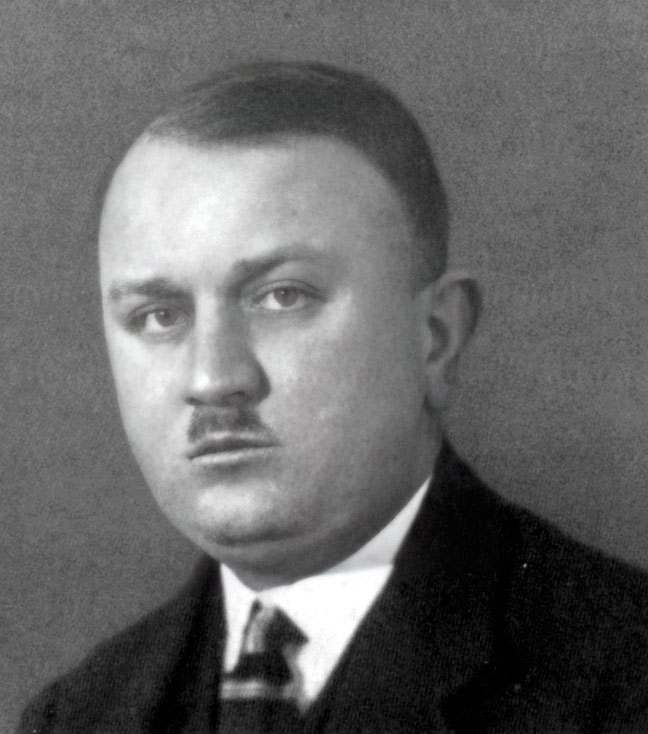
Franz Czernuch was a resistance fighter against the Weimar Republic and a Blood martyr of the National Socialist movement.
In the night of 23 December 1931, the National Socialist Franz Czernuch is seriously injured by a shot in the stomach by the Marxist official Smolin in Hindenburg in Upper Silesia. The two perpetrators were police officers of the Weimar system. They were in plain clothes and were not recognised as police officers by Franz Czernuch. As he left the „Hill“ restaurant they insulted him as a „cursed National Socialist“. During the ensuing exchange of words, the „policeman“ Smolin drew his gun and shot.
Franz Czernuch suffers from internal injuries for almost three weeks, and died on 9 January 1932.
Richard Menzel
(* 20 May 1910, † 10 January 1932 in Rendsburg)
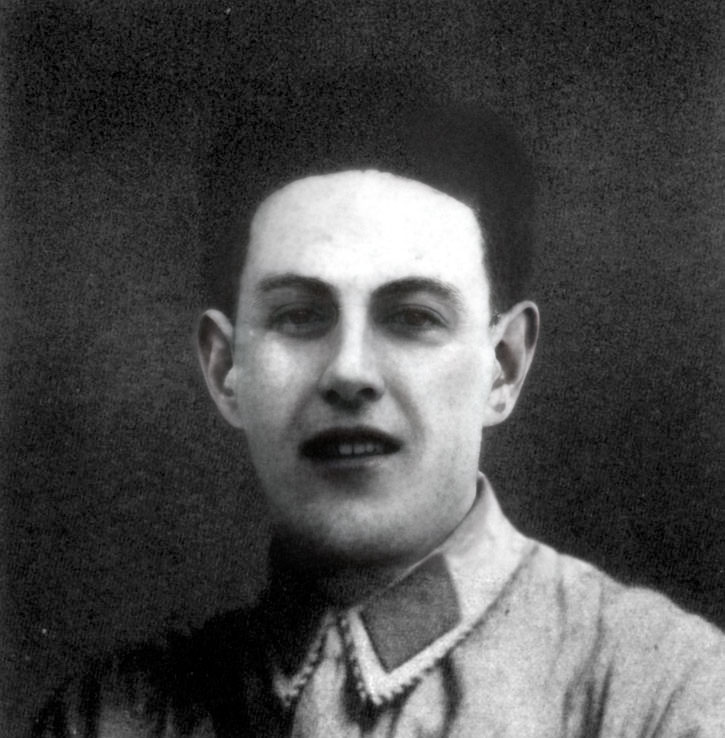
Richard Menzel was a resistance fighter against the Weimar Republic and a Blood martyr to the National Socialist movement.
The painter Richard Menzel joined the NSDAP and SA in 1931.
On 10 January 1932 there is a storm meeting at the „Schützenhof“ in Rendsburg. The SA storms from out of town arrive on bicycles, the Rendsburg storms in small squads but individually, as marching in closed formations and wearing the brown shirt was forbidden. The commune loiters in the streets, as there has been a strange unrest in the streets of Rendsburg since early morning. At 3 p.m. the roll call begins. Shortly after it began, the police appeared and gave the then Sturmbannführer Erich Boetel the march route for the way home. A route through the middle of the reddest quarter of Rendsburg, allegedly all the main streets were to be besieged by the commune. After the end of the roll call, the ordered route is taken with the prescribed „Ohne Tritt“ (without treading). As they approach the barracks area, loud shouts of „Red Front“ can already be heard from the SA.
When the people are sighted, there is no stopping the crowd: the women first, so they push towards the men. Other women carry stones in prams to ensure the bombardment of their men against these cursed „National Socialists“. The first man was already hit in the knee with a paving stone by the SA, collapsed, was pulled up and continued to limp along until the hail of stones got out of hand and the Sturmabteilung shouted: „Auf-marsch! March!“ is heard from the storm troopers. A street battle, the so-called Menzel battle, had begun, the consequences of which were incalculable. In a few minutes eighteen SA men were lying on the street, injured by stones thrown at them. Among them was Richard Menzel, whose skull had been crushed by a stone. He died in the evening at 11.30 p.m. after being admitted to hospital at the age of 21.
Pastor Roager spoke at the funeral service:
„Richard Menzel, this young German, remained loyal to the National Socialist movement in the simple fulfilment of his duty. His willingness to sacrifice drove him to the cause which he found good and which won his heart. If the blood spilled here cries out to heaven, the answer comes from there: Mine is the revenge!“
In Kiel, the current Hagebuttenstraße was called „Richard Menzel Straße“.
Arnold Guse
(* 14 June 1911, † 19 January 1932 in Essen)
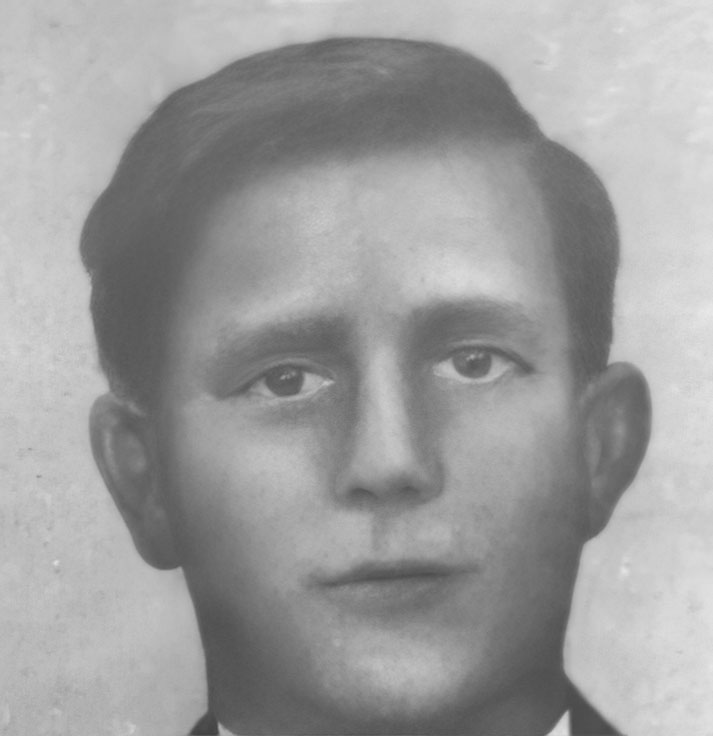
Arnold Guse was a resistance fighter against the Weimar Republic and a Blood martyr to the National Socialist movement.
The SS man Arnold Guse was an exemplary comrade and an ever-hopeful person. He spent most of his youth in Pomerania until he came to Essen at the age of nineteen, joined the SA there and lived in the SA home. After one year of SA service he joined the SS. His life was service and struggle for Germany. On 19 January 1932, the house at Mauerstraße 1 in Essen, where two National Socialist families lived, was besieged by communists. Help was summoned from the SA home, and twelve SA and SS men, among them Arnbold Guse, rushed over. On the forecourt of the Marienkirche they were met with shots from the communists. Arnold Guse was shot in the lung and heart. On the way to the hospital he died half an hour later with the last words to his comrades:
„Heil Hitler! Keep fighting for the Third Reich!
Ernst Schwartz (Schwarz)
(* 3 March 1883, † 19 January 1932 in Berlin)
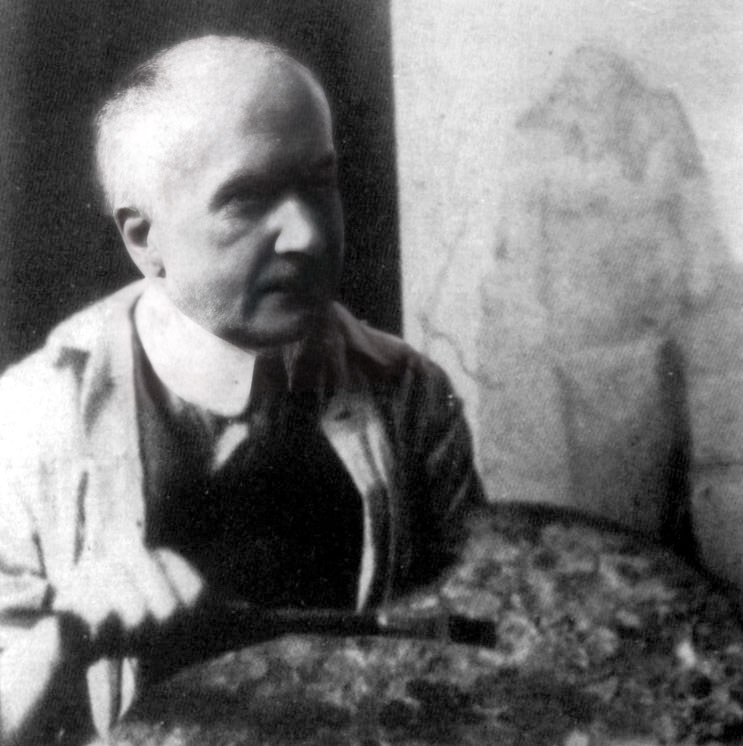
Ernst Schwartz (Schwarz) was a resistance fighter against the Weimar Republic and a Blood martyr of the National Socialist movement.
Ernst Schwartz was wounded several times in the First World War and was awarded both Iron Crosses. He participated as a Freikorps member in the Kapp Putsch and in the battles against the Polish invasion of Upper Silesia. In 1926 he joined the NSDAP. On 19 January 1932, the SA held a publicity evening in Berlin-Waidmannslust. Only six police officers accompanied the 200 SA men on their way home. The communists attacked in the Laubenkolonie Felseneck - the Berlin-Reinickendorf area. The first pistol shots rang out. The SA man Wittkowski and Ernst Schwartz are separated from the main group and brutally attacked with knives. The art professor Ernst Schwartz is murdered in the process.
One of his comrades wrote in the „Völkischer Beobachter“:
„We lined up in long rows in the Bergschloß Weidmannslust, and our Werner Schulze appointed Ernst Schwartz as squad leader that evening. I can still see Schwartz sitting at the table, smiling happily. Happy about the fact. That he, the old front-line fighter and officer, was accepted into the circle of the boys, into the active SA, because there was no place for him in the reserves. „But we were also proud of our professor, who had put everything aside to fight under Adolf Hitler’s storm flags.
He had to go through a lot because of it. Shunned by his colleagues, ostracised and hated by the Jewish art dealers, the boycott against him also spread to bourgeois circles, and in the so-called „critics“ he was condemned and slated. Embittered and gloomy, he sought his way in art, and through the movement he found his way back to the height of achievement.
He went through the material battles of the world war. Despite wounds and scars, he was always drawn back out into battle. He stood his ground in the Freikorps on Germany’s threatened border. With burning hearts, he could join the movement at an early age, and now his bitter fate had to befall him.
That we should come into contact with death so quickly on that Sturmbann evening and that Ernst Schwartz would become the victim was something none of us had suspected, even though we knew that we were entering a threatened area when we brought home the Reinickendorf comrades who were once again to be ‘whacked’ by the communists.
We walked in disbanded order, in accordance with Herr Brüning’s `emergency decree’. We did not make the diversions reproached to us by the Marxists in order to raid the `sleeping` leafy colony, but to deceive the enemy lying in wait, of whom even the police had warned us.
In Schönholzer Weg we suddenly heard the clang of iron against iron, and a comrade said, why is the Heidekrautbahn ringing, it’s not running any more - then we were fired upon, the lamps went out, and the bloodthirsty shouts of our enemies rang out.
On the corner of Wilkelstraße, we forty-eight men were pushed away by the police who accompanied us, while the others from Sturmbann 3/IV brought us through. We took cover in Wilhelmstraße. With difficulty and only under threat did the police officers gain entry to the inn there, while the Reds of Wilkelstraße insulted us from their safe windows. Again and again a shot rang through the night.
While the raiding party rolled up the leafy area, we were literally forgotten. Suddenly we were attacked by a heavily armed communist horde, Ernst Schwartz and Wittkowski were pushed away and cut down. As we were retreating, we suddenly came under fire from the front, and in front of us were two civilians pretending to be police officers. We realised that they were not our friends by their excited chatter, and they would have fared badly if uniformed police had not suddenly arrived. - We were herded off like cattle with ‘hands up’, and it was only after our imploring pleas that some officers were willing to fetch our two comrades from Wilkestraße. -
While Wittkowski was merely stunned and slightly injured, Ernst Schwartz had received a lung puncture and bled to death under the hands of his comrades.
But we went the way of all „National Socialists“, we were taken to the „Alex“ for further „care“. There we gathered for the first and common tribute to our dead comrade, and as we marched in defiant unison in the courtyard during the free period, a system policeman got upset that we were not in a barracks yard, but in a Prussian institution. What did this guy know about Prussianism!
After a week we were released, apart from a few comrades who were kept in prison for up to eleven months.
Our innocence was proven, but what was more important for the Marxists, we had lost our position and existence, and that was enough for our opponents for the time being. - We then sadly, but with unbroken courage, led our comrade Ernst Schwartz to his final resting place, while the communists tried to instigate riots in front of the cemetery.“
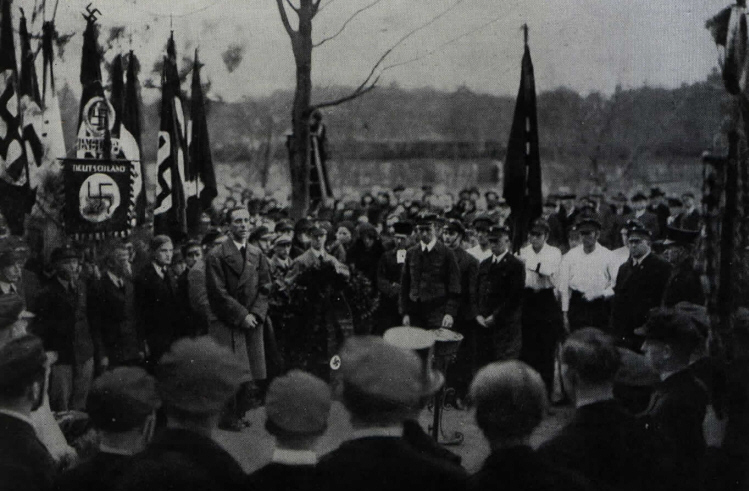
Memorial stone dedication on 19 January 1934 at the site where SA squad leader Professor Ernst Schwartz was murdered.
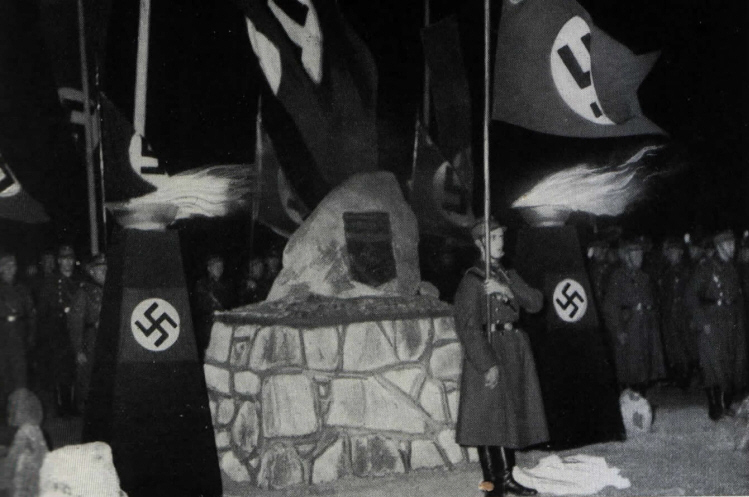
Memorial stone dedication on 19 January 1934 at the site where SA squad leader Professor Ernst Schwartz was murdered
A memorial stone stood on the spot where Professor Ernst Schwartz gave his life for Germany during the Third Reich.
Bruno Schramm
(* 11 May 1903, † 23 January 1932 in Zülz, Upper Silesia)

Bruno Schramm was a resistance fighter against the Weimar Republic and a Blood martyr to the National Socialist movement.
The SA man Bruno Schramm was a graduate engineer from Zülz in Upper Silesia. During the Polish attack on Germany after the First World War, he fought against the Polish invaders. In 1921, he took part in the fighting at Annaberg as a member of the Silesian Selbstschutz and the Freikorps Oberland.
He and was seriously wounded by communists on 22 January 1932 when he rushed to the SA home besieged by the red mob to help his threatened comrades. He died the following day of a fractured skull.
„I go to my death for all of you!“ were his last words to parents and siblings.
Fritz Beubler
(* 14 January 1911 in Merxleben, † 4 February 1932 in Nägelstedt)
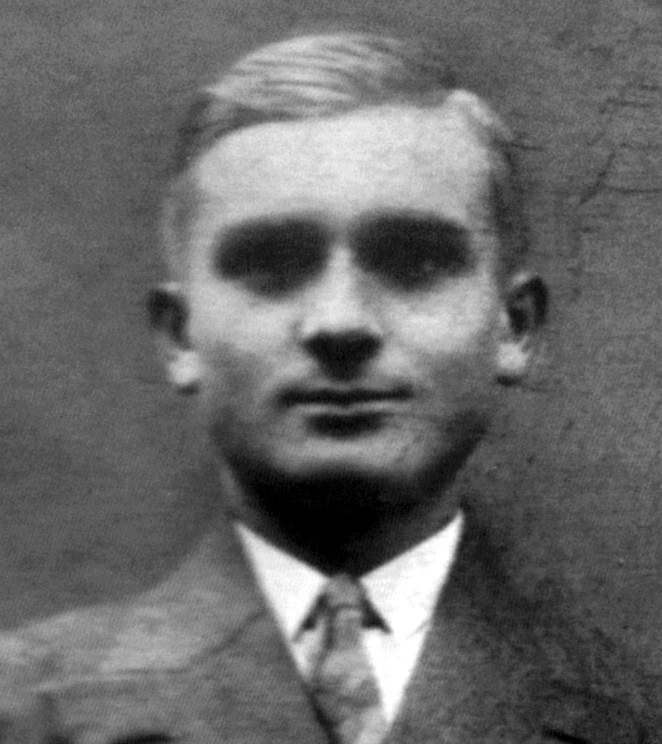
Fritz Beubler was a resistance fighter against the Weimar Republic and a Blood martyr of the National Socialist movement.
The carpenter Fritz Beubler is one of the first to join the newly established local group of the NSDAP in Merxleben. Shortly afterwards he also volunteers for the Schutzstaffel. On 29 January, he and his comrades are sitting at the squadron evening in Nägelstedt. Shots were fired outside. The men rush outside... Fritz Beubler collapses after being hit.
„The German people gave away honour and freedom and that is why our brother Beubler had to leave us“, said Thuringia’s Gauleiter Sauckel at the grave of the SS man Fritz Beubler, who was shot in the pelvis by communists on 29 January 1932 and died as a result on 4 February.
“He died because the German people were torn apart, because it was Germans, even if they were incited and blinded Germans, who murdered him. It was not at the hands of enemies, but at the hands of his own people that a German had to lose his life. We want the spirit of discord and hatred to disappear from our people and, if necessary, we will give our lives for this. You have given us a shining example.“
In the Third Reich, Bockgasse in Nägelstedt received his name. In Erfurt, the current Tiefthaler Weg bore his honorary name.
Georg Preiser
(21 March 1913, 7 February 1932 in Berlin)
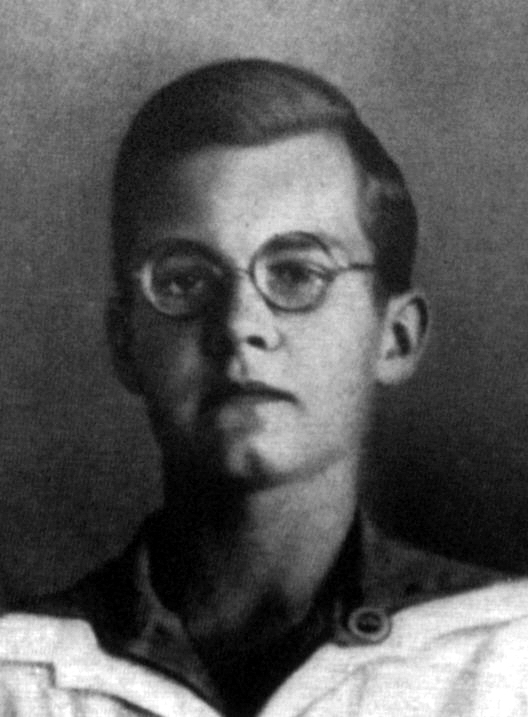
Georg Preiser (21 March 1913, 7 February 1932 in Berlin) was a resistance fighter against the Weimar Republic and a Blood martyr of the National Socialist movement.
The machine fitter apprentice Georg Preiser from Berlin-Weißensee in Berlin was a proud young man. While distributing leaflets for the Hitler Youth, Preiser was attacked by communists on the corner of Danziger and Weißenburger Straße on 7 February 1932, abused in the cruellest way, smashed with heels and house keys. The consequences of the severe injuries ended this young life that same evening at the age of eighteen.
His name was added to the list of the Immortal Allegiance of the Hitler Youth.
Arno Kalweit
(* 7 March 1911, † 8 February 1932 in Kraupischken, East Prussia)
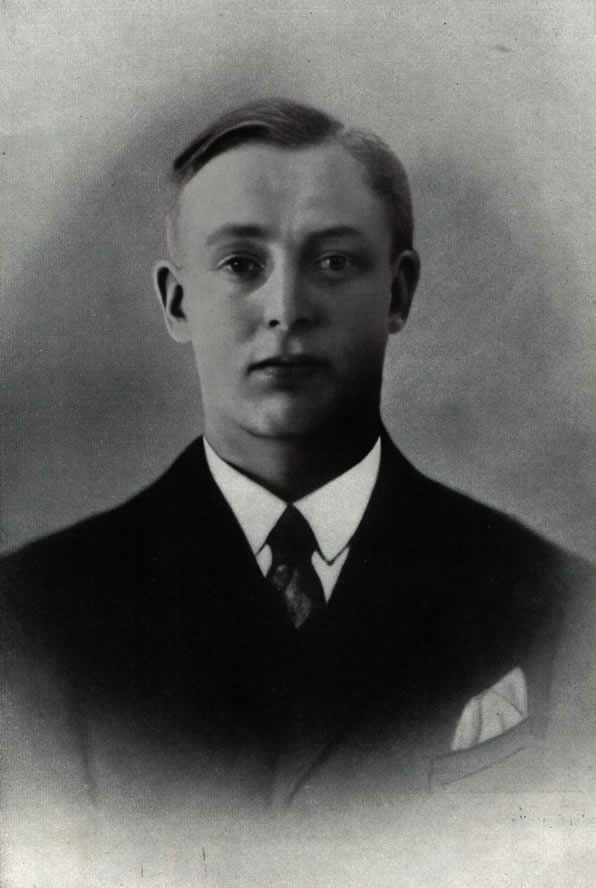
Arno Kalweit was a resistance fighter against the Weimar Republic and a Blood martyr of the National Socialist movement.
On 28 January 1932, Arno Kalweit was assigned to the hall guard in Kraupischken. On the way home, communists and members of the Iron Front attacked him in loyal association, smashed him, abused him, the twenty-one-year-old journeyman miller. He suffered in hospital for nine days, with a broken skull and a severely fractured upper jaw, until he died.
„I know what I’m dying for!“ These are the last words of Arno Kalweit.
In Elbing, the Arno-Kalweit-Weg was named after him.
Hans Karner
(date of birth unknown - † 8.2.1932)
SA Group Austria
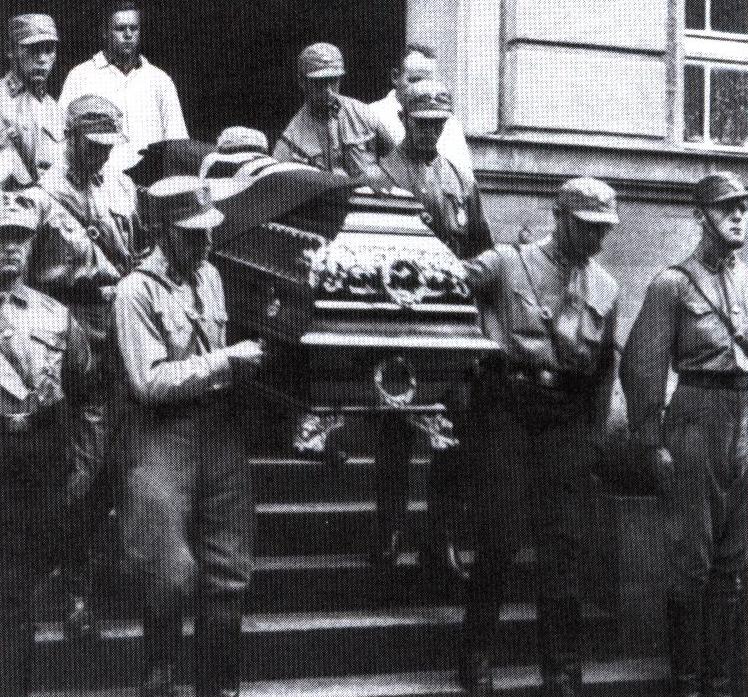
SA trägt einen Kameraden zu Grabe.
SA carries a comrade to the grave.
Hans Karner was an SA man of Sturm 3/76 in Donnerskirchen, Burgenland.
On 7 February 1932, the agricultural worker was at a dance in nearby Schützen am Gebirge. In the course of the evening an altercation occurred between Karner and the 25-year-old carpenter’s assistant Josef Turner. A knife stabbed the SA man in the leg, injuring him considerably. Allegedly, neither other guests nor a doctor who had been called in were prepared to help the wounded man. It was only hours later that Hans Karner was taken to hospital, where he died as a result of heavy blood loss.
Turner was a member of the „Katholischer Burschenverein“, Mjölnir-Grafik an organisation that was similarly hostile to the National Socialists as the Zenlrumspartei in the German Reich.
The Sturm 3/76 bore the honorary name „Sturm 3 Hans Karner“.
Heinrich Heißinger
(*27 August 1909, † 4 February 1932 in Hamburg)

Heinrich Heißinger was a resistance fighter against the Weimar Republic and a Blood martyr of the National Socialist movement.
Sunday on the Reeperbahn, there are thirty men marching from the naval tower, they come from the propaganda service. Blue boys in brown shirts, the colours are compatible. They saw the world, with open eyes and bright senses they looked. Among them was the cook’s mate Heinrich Heißinger. They marched briskly through the Gängeviertel, over the clumsy, bumpy pavement, along the old, crooked gabled houses that looked as if they were about to collapse at any moment. Gängeviertel - a strange, an eerie part of town. A labyrinth of corridors and alleyways, known in their context only to those who were born there. The flourishing arms trade between criminals and communists was well known.
The disciplined sound of steady footsteps does not quite fit into the style of this environment. Then suddenly it mixes with a wild stomping, from the dark corridors it rolls out, mud of the underworld, army pistols fire up, from the nooks and crannies there is a sharp and glaring bang, the bullets smash into the Marine SA squad. From the ranks they tumble to the ground, hit by the insidious lead. On the pavement, lifeless, with a hole in his forehead, lies Heinrich Heißinger. A few streets away, saxophones howl, the Reeperbahn hoots.
In 1934, a court found the communist Schlieper to be the murderer. However, shortly after the murder, he had absconded to Soviet-Bolshevik Russia.
An Elbe ferry was named in Heinrich Heißinger’s honour on 08.08.1933. In Hamburg-Horn, Posteltsweg was renamed Heinrich-Heißinger-Straße in March 1934. Since 25 October 1945, the street has temporarily been called Posteltsweg again.
Walter Gornatowski
(* 31 December 1907, † 17 February 1932 in Klein-Gaglow near Cottbus)
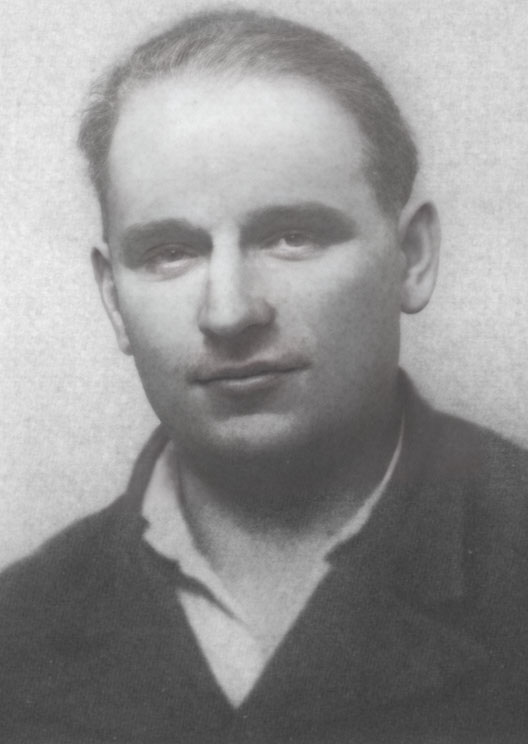
Walter Gornatowski was a resistance fighter against the Weimar Republic and a Blood martyr to the National Socialist movement.
After an election meeting in Klein-Gaglow near Cottbus on 17 February 1932, National Socialists were attacked by communists and the Reichsbanner. With knives, truncheons and stones, the communists had so brutalised him that his comrades no longer recognised him. The roll call revealed that it was the SA man Walter Gornatowski, a worker from Cottbus.
„Grow, you freedom of the German oaks, grow up over our corpses.“
Theodor Körner spoke this word in times of German distress.
This saying was found in the SA man’s wallet as he lay still and pale on the stretcher.
Franz Becker
(* 14 March 1911, † 19 February 1932 in Saarau (district of Schweidnitz))
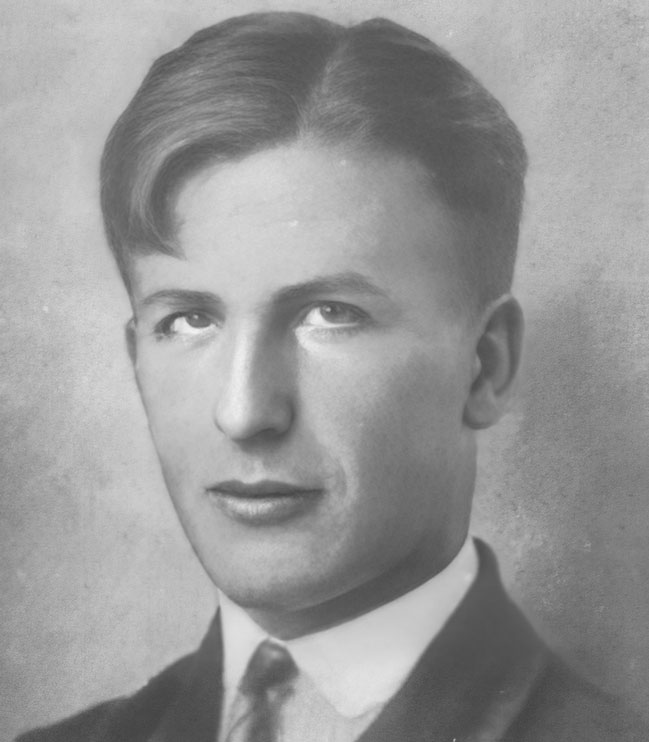
Franz Becker was a resistance fighter against the Weimar Republic and a Blood martyr of the National Socialist movement.
Franz Becker joins the NSDAP and the SA at the age of 18.
After a meeting in Saarau in Silesia, the SA, which was protecting the hall, was attacked by communists and Reichsbanner people on their return march in the night of 19 February to 20 February 1932. The SA squad leader Franz Becker of Sturm 1/10 in Schweidnitz is shot dead.
A comrade of his wrote in the „Schlesischer Beobachter“:
„A young leader has passed away, the most loyal one. One who never doubted the idea and believed with holy fire in the victory of Adolf Hitler. Comrade, you wanted to die in open combat, man against man, with equal weapons. Now you have been murdered (...). You fell on the same day that an Andreas Hofer died for his people’s freedom. You too died for your people’s freedom. On your bier, comrade, German men swore not to rest until your yearning had become the common property of the German people. But to a deeply bowed mother we call out: You gave your best for Germany, from now on see in all of us who wear the brown shirt your sons!“
Wilhelm Sengotta
(* 1 January 1911, † 20 February 1932 in Massen, Dortmund district)
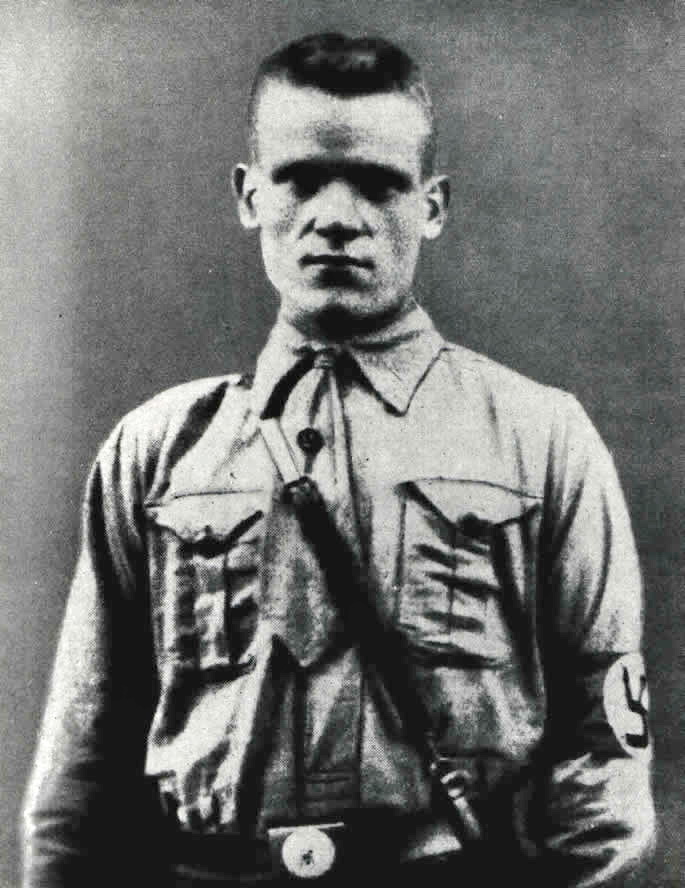
Wilhelm Sengotta was a resistance fighter against the Weimar Republic and a Blood martyr of the National Socialist movement.
In autumn 1931, Wilhelm Sengotta joined the NSDAP and the SA in Wickede near Dortmund.
Following a National Socialist meeting in Obermassen near Dortmund, there is a clash between National Socialists and Communists on 20 February 1932. About fifty SA men are ambushed by communists on their way home. Twenty-two-year-old SA man Wilhelm Sengotta from Wickede is killed by a shot in the heart, after which the murderers flee. His last words were „They shot him well“. At the graveside, the Gau leader Schepmann is deprived of his right to speak by the Weimar system police, whereupon he delivers the memorial speech on a neighbouring estate:
„Not mourning and humility is the meaning of life. With a new rhythm we will sweep away all that is cowardly and bad and carve out a new, beautiful, free fatherland.“
A memorial stone in Dortmund-Wickede commemorated Sengotta in the Third Reich. On 25 February, the Northwest Group received the following letter from Munich:
„The Sturm 7/1 98 Wickede is granted the right to use the name ‘Sturm 7 Wilhelm Sengotta’ in memory of Scharführer Wilhelm Sengotta, who was shot by communists on 20 February 1932. Sincerely yours. Adolf Hitler“
Artur Wiegels
(* 25 February 1891, † 22 February 1932 in Schwinde a. d. Luhe)

Artur Wiegels was a resistance fighter against the Weimar Republic and a Blood martyr of the National Socialist movement.
Artur Wiegels had spent four years fighting on the Western Front against the countries that had declared war on Germany in the First World War. The bullets spared him so that he could return to ploughing the German home soil. He became a follower of Adolf Hitler and joined the NSDAP and SA in 1931.
On 22 February 1932, one day before Dr. Goebbels passionately accused the Brüning government in the Reichstag of having caused a latent civil war through the emergency decree, the farmer Artur Wiegels from Rönne in Hanover went to a tax consultation session at the Gasthof Hams. The Social Democrat and trade union secretary of the Smallholders’ Federation, Gellert from Winsen, held it. Wiegels had some questions concerning farmland to be leased, but was not allowed in. Gellert does not want to talk to the „National Socialist“. When Gellert went out the back door to his car to leave, Wiegels followed him with perfectly peaceful intentions. Before he can speak, Gellert fires four shots at him from his pistol for no reason at all and flees in the car, later surrendering to the police. The police release him on the grounds of alleged self-defence. National Socialist speakers were forbidden by the Weimar system police to speak about the incident. Artur Wiegels left behind his grieving wife and three children.
His SA comrades wrote a little poem for him:
We bear your name.
In the reserve tower 4/9
Shall stand on our flags
Artur Wiegels only alone.
Founded this year,
And expensive blood was already flowing.
Germany is newly proclaimed.-
We are now on guard.
August Brackmann
(* 18 April 1907, † 29 February 1932 in Tessin (Mecklenburg-Western Pomerania))

August Brackmann was a resistance fighter against the Weimar Republic and a Blood martyr of the National Socialist movement.
August Brackmann joined the NSDAP and the SA in February 1932. On 29 February 1932 he was with comrades in the „German House“ in Tessin in Mecklenburg-Western Pomerania. There were exchanges of words with communists and Reichsbanner people and fisticuffs in which four SA men were seriously injured. Three were saved by emergency surgery. The fourth, the mechanical engineer August Brackmann, dies at the age of 24 from his injuries.
He worked tirelessly in the service of the movement until his death and was on the road day and night. One street each in Tessin and Rostock bore his name in the Third Reich.
Henry Kobert
(*7. 8. 1908 - † 29. 2. 1932)
District Hamburg
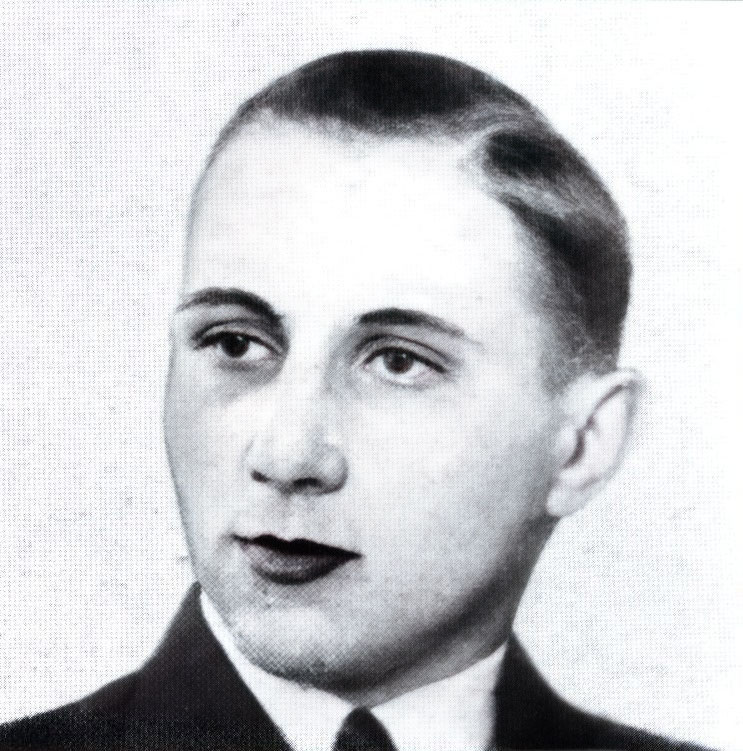
The police report describes the circumstances of the death of the Hamburg SS man:
„Last night, at around 1.00 a.m., cries for help rang out in Borgfelder Straße at the Gesundbrunnen level. When the police arrived, a man lying on the ground was being severely maltreated and kicked in the face by another man. The perpetrator attacked the police officer who had rushed to the scene and was assisted by other bystanders, some of whom wore NSDAP insignia. The officer was pulled to the ground, kicked and beaten. Although the police officer fired a shot in self-defence, the attacker did not let go of him. The police officer therefore had to fire another shot, which killed the attacker. The man in question was 24-year-old Henry Kobert, Ausschläger Weg No. 5.“
Shortly before his death, Kobert was still with some comrades in the storm restaurant Klaß in Anckelmannstraße.
The NSDAP wrote about this in the „Hamburger Tageblatt“:
„Henry Kobert was attacked and assaulted by four Reichsbanner men, who could be recognised by their badges, in the Borgfelder Straße nursing home, near the Gesundbrunnen. Comrades of the attacked man, who were also on their way home and were walking a few hundred metres ahead, noticed the attack and rushed to help. In the meantime, however, the police officer had appeared at the scene and arrested the assaulted Henry Kobert. Kobert then protested, but complied with the officer.
According to witnesses, the officer was drunk. Presumably, the officer fell, knocking Kobert to the ground, and the fatal shot was fired.
Kobert was a member of the Hamburg SS-Sturm 1/1/28, which later bore the honorary name of the deceased. The Hanseatic city named Bömelburgweg and Bömelburgstieg after the first fallen member of the Hamburg Schutzstaffel. In addition, Henry Kobert was honoured with a memorial stone on Borgfelder Straße near the scene of the crime.
Questions about the circumstances of the deaths also remained open in party circles. Unlike in the KPD, assaults on police officers were not tolerated in the NSDAP as a means of political struggle. This is probably the reason why the Schutzstaffelmann remained unnamed in some of the party publications.
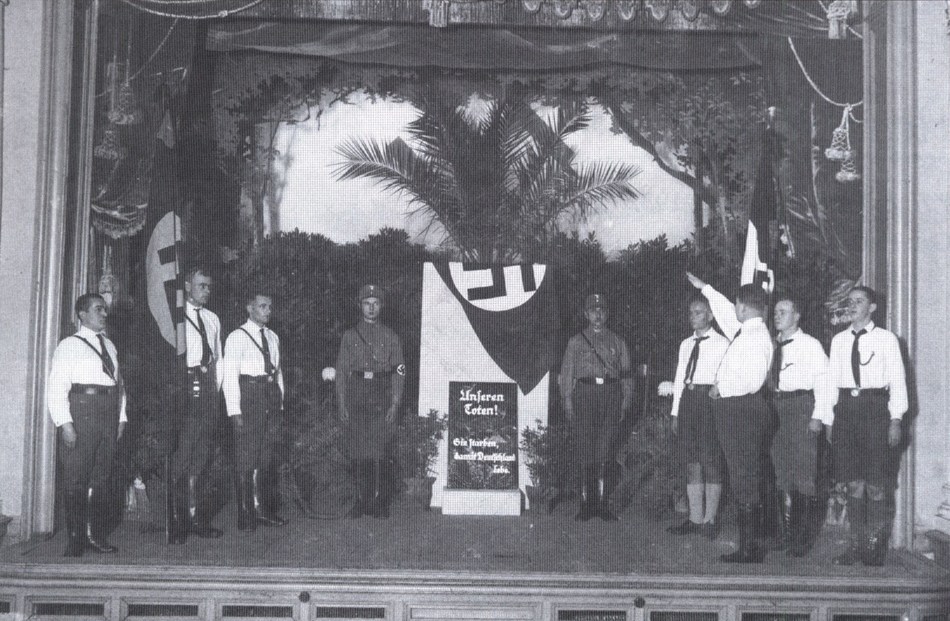
Funeral service for the SS man Henry Kobert
Otto Ludwig
(* 17 April 1886, † 6 March 1932 in Berlin)

Otto Ludwig was a resistance fighter against the Weimar Republic and a Blood martyr to the National Socialist movement.
A few years before the First World War, Otto Ludwig went to the South Sea island of Panape, which belonged to the German colonial possessions, where he served the fatherland as a police master. At the outbreak of the war, it was natural for his soldier nature to return home as a war volunteer to fight at the front against the states that had declared war on Germany. It was only with great difficulty and danger, disguised as a coal trimmer, that he managed to return to Germany. On an adventurous journey via Japan and the USA, using false Dutch papers to sign on to a Norwegian freighter, he first reached enemy England. When the freighter was taken up by a German torpedo boat in the North Sea a short time later, he was finally rescued.
After the war, he joined the telegraph service. Otto Ludwig became a political soldier for Adolf Hitler. In 1932 he joined the NSDAP.
Soon the Reds knew and hated the active canvasser and tireless drummer in Berlin. On 6 March 1932 he is shot in the back by communists while distributing election leaflets. At the age of forty-six, Otto Ludwig is laid to rest.
A commemorative plaque was placed on the house at Choriner Straße 8 in Berlin:
Here fell in battle
for Germany’s liberation
in faithful fulfilment
his duty
Party comrade Otto Ludwig
on 6 March 1932.
He was a bearer of this German deed,
which is greater than everything,
what was there.
In Berlin, a street bore the honorary name „Otto Ludwig“. Since 1949, the street has been temporarily named after the communist Hermann Tops; the commemorative plaque was destroyed by the „liberators“.
Wilhelm Thielsch
(*6.6.1912 - † 8.3.1932)
District Silesia
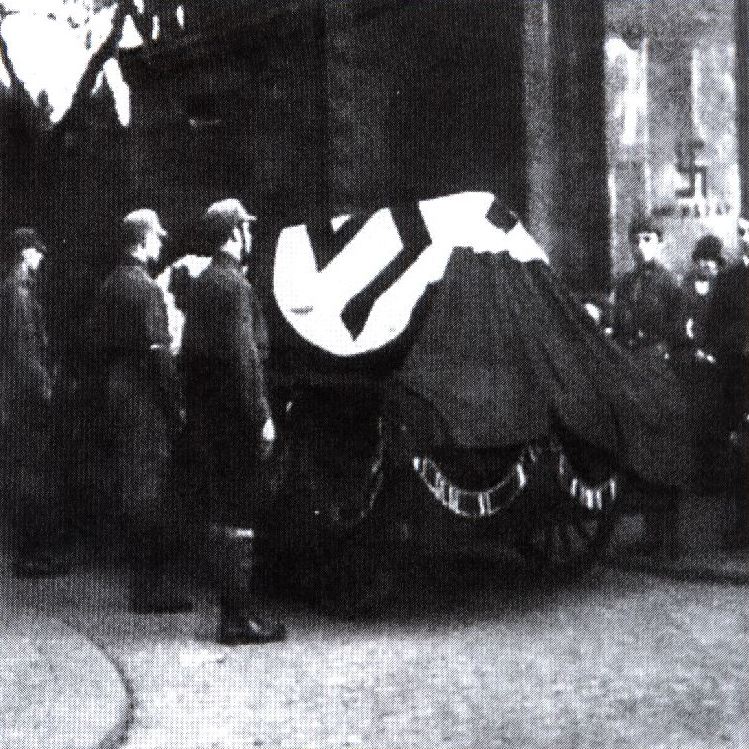
SA accompanies a comrade on his last journey.
Wilhelm Thielsch was unmarried. He lived in his parents’ flat in Breslau, Silesia, until his death.
The father of the nineteen-year-old plumber disapproved of his son’s membership in the NSDAP and Sturmabteilung. There were frequent quarrels in the small flat. One day the father came home drunk. During a short, heated exchange, the situation escalated and the father stabbed his own son to death. The extent to which a family tragedy was actually determined or triggered by political backgrounds here remains open. Thielsch is named as a Blood martyr in all lists and descriptions of the NSDAP.
Karl Panke
(* 6 April 1911, † 11 March 1932 in Bobersberg (Crossen district))
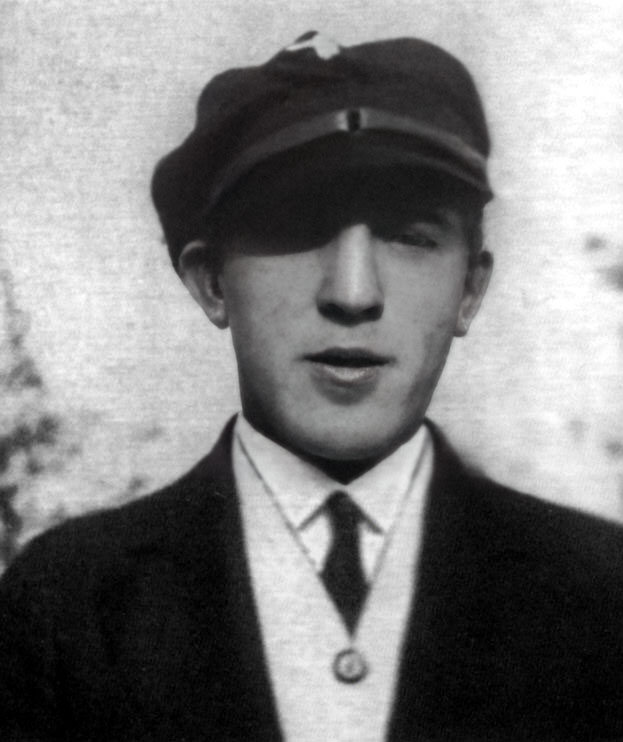
Karl Panke was a resistance fighter against the Weimar Republic and a Blood martyr to the National Socialist movement.
Karl Panke was a journeyman blacksmith, SA Scharführer and political leader in Bobersberg in the Crossen district of Brandenburg. Once he took the communist speaker off the stage at a meeting, another time he threw the communists out of the window during a hall fight.
While Karl Panke was active in the SA and the NSDAP, his brother was a member of the KPD.
On 6 March 1932, his own brother stabbed him with eleven stitches in blind hatred. Karl Panke succumbed to his injuries on 11 March 1932. Of five years in prison, the fratricide served only one and a half years, the rest being pardoned by the Weimar system.
Erich Jaenecke
(* 12 December 1904, † 14 March 1932 in Gardelegen)

Erich Jaenecke was a resistance fighter against the Weimar Republic and a Blood martyr to the National Socialist movement.
Erich Jaenecke joined the NSDAP and the SA in 1930.
On 10 March 1932, the SA of Gardelegen organised a propaganda march on the occasion of the election of the Reich President and was attacked by members of the Reichsbanner on their way home. The SA man Erich Jaenicke, a young farm labourer from Koeckte, suffered severe skull and brain injuries inflicted by a nailed fence rail, to which he succumbed on 14 March 1932. The father of the SA man Jaenicke was a Reich bannerman in a leading position. His son’s murderers were in the ranks of the Reichsbanner. The local group Gardelegen of the NSDAP knew the murderer, the Reichsbannermann Paul Kaczmarek. The authorities of the system government of 1932 were more cumbersome, they took a long time to bring justice. A telling document is the letter from the mayor to the local group, reproduced here. It was only a few weeks later that Kaczmarek was convicted of the crime by the court. Three years in prison seemed to the judges of the Weimar Republic to be enough atonement for the murder. The murderer was nevertheless amnestied and released in the same year.
Max Beulich
(* 9 January 1913, † 4 April 1932 in Mittweida)
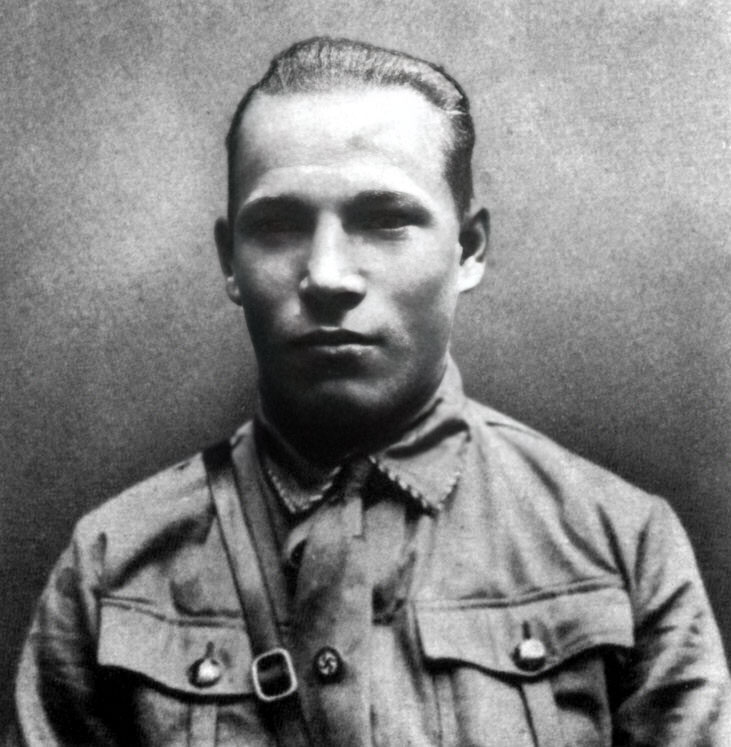
Max Beulich (*9 January 1913, † 4 April 1932 in Mittweida) was a resistance fighter against the Weimar Republic and a Blood martyr of the National Socialist movement.
In October 1931, the Melker Max Beulich joined the NSDAP and the SA at the age of 18.
In the night of 4 April 1932, the SA man Max Beulich from Mittweida in Saxony is attacked by communists and severely injured by a deep liver puncture. He died of the wound the same night after an immediate operation. One of his brothers was a communist, another a member of the Reichsbanner. The solemn funeral of Max Beulich and the extraordinary sympathy of the SA comrades and party comrades from the surrounding area gave the relatives of the deceased a different, new image of the movement of which they had previously been opponents. The brother of the deceased, who was organised in the Reichsbanner, approached the leader of the local group at the end of the funeral service, thanked him for the great sacrifice and love during his brother’s last walk and said literally:
„This day is a turning point in my life, I have become a different person today. I will talk to my other brother and come back to see you.“
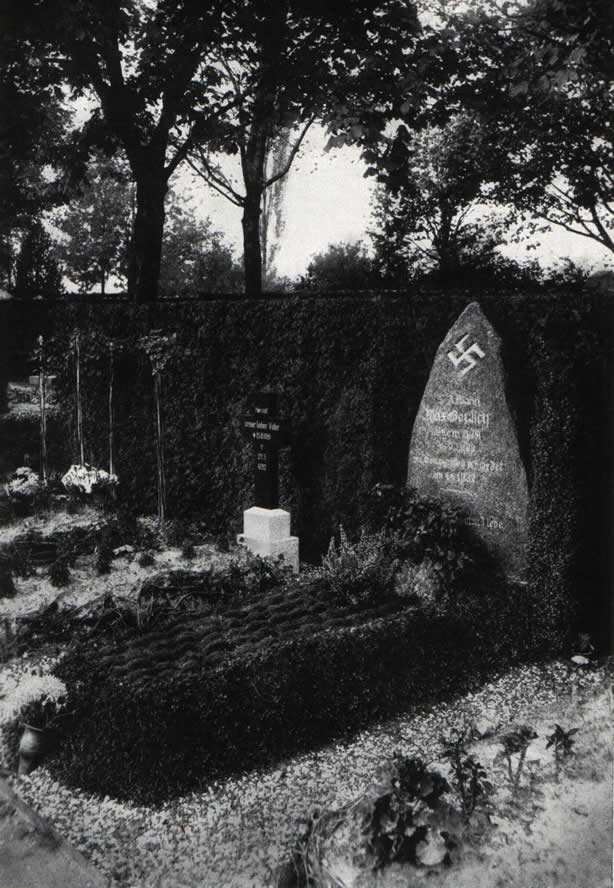
Gravesite of Max Beulich
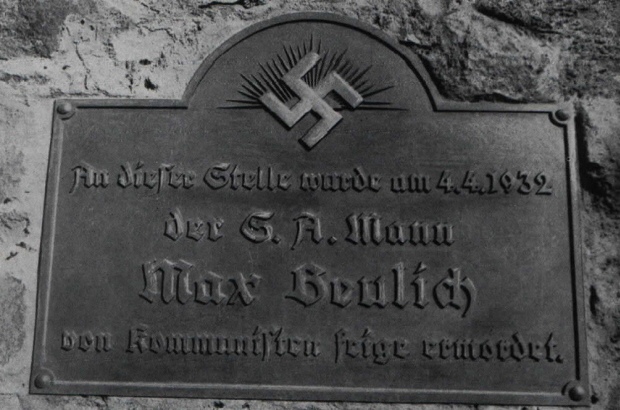
Memorial plaque at the site of Max Beulich’s murder
The street in Chemnitz where Max Beulich was murdered bore his honorary name during the Third Reich.
Ludwig Frisch
(* 27. Juli 1906, † 8. April 1932 in Chemnitz)
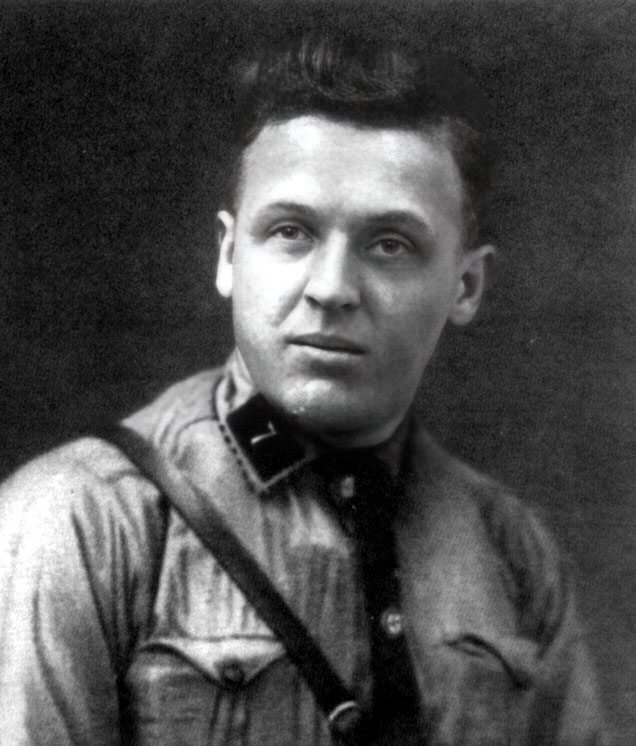
Ludwig Frisch was a resistance fighter against the Weimar Republic and a Blood martyr to the National Socialist movement.
The young locksmith had come to Chemnitz from his Bavarian home village. In Chemnitz’s SS-Sturm 1, Ludwig Frisch was a courageous fighter for Adolf Hitler. Together with several thousand people, he had heard his Führer speak on 3 April at the Südkampfbahn. On 4 April 1932, he was walking through Zeppelinstraße in Hilbersdorf in the evening with an SS comrade to fetch spare parts for a loudspeaker van. Out of the darkness 15 shots suddenly fire at Ludwig Frisch and his comrade Dießner, Ludwig Frisch falls to the pavement with a shattered knee. His comrade is also seriously injured. Although Ludwig Frisch’s artery is hit, the strong, healthy nature of the twenty-six-year-old rebels against death. And his friends remember how he spoke for himself at a torchlight procession of the SA in the face of the glorious enthusiasm of the German youth:
“All of this is worth dying for.“
He did not complain. „I want to march again“ is his only wish. A blood transfusion becomes necessary, thirty SS comrades unanimously make themselves available to take blood. Only one is allowed to sacrifice it and a young aristocratic student joyfully gives his blood for the worker Ludwig Frisch. But even the subsequent leg amputation does not improve his condition. It was in vain. Ludwig Frisch dies on 8 April 1932. „In a brown shirt let me be buried once,“ he said forebodingly to his mother at his last farewell.
In Chemnitz (Weissenfels), an SS standard bore his honorary name.
Friedrich Hellmann
(* 20 April 1901, † 8 April 1932 in Berlin)
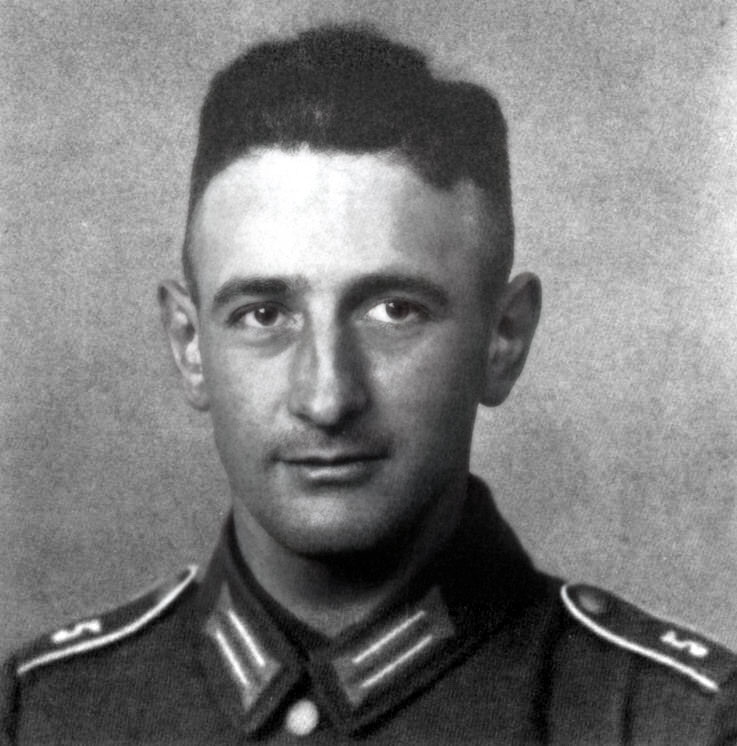
Friedrich [Fritz] Hellmann was a resistance fighter against the Weimar Republic and a Blood martyr to the National Socialist movement.
Hellmann fought in the Freikorps Lützow. During the election campaign for the Reich President in 1932, the SA Scharführer, a former Reichswehr soldier, fell in Berlin. Communists opened fire on him and his comrades. Many were wounded. Fritz Hellmann died one day later, on 8 April 1932, in Friedrichshain hospital, later Horst Wessel hospital.
At the funeral, the Weimar system police confiscated all the wreath ribbons and the instruments they had brought with them.
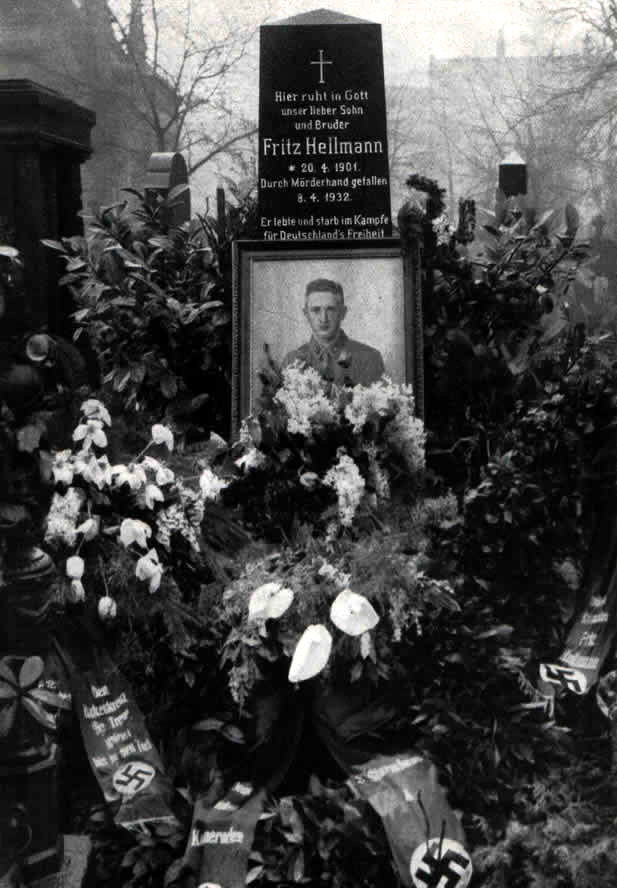
Gravesite of Friedrich Hellmann.
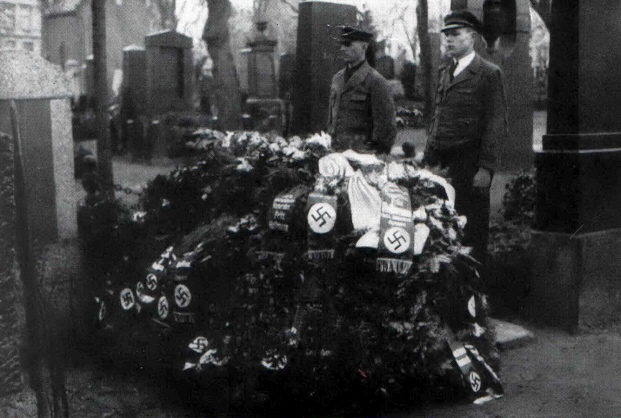
Wake for Fritz Hellmann.
A picture from those days is given by the newspaper „Der Angriff“:
„Shortly before midnight, when the Horst Wessel song was played at the end of the rally, the Bolshevik subhumans, light-shy criminal types, were already creeping through the surrounding, poorly lit night-time streets, waiting behind a corner or in some dark hallway for individual SA comrades to come along. At the corner of Christburger Strasse and Greifswalder Strasse, others stood together in large numbers, already ready to proceed to the preparatory attack.
A squad of SA, who had just been bringing red rowdies to order in the crowded hall, approached the red horde. At the same moment the bandits unlock their revolvers and fire twenty or thirty shots at the defenceless. In a flash, the SA men throw themselves to the ground to avoid being hit by the murder bullets, but even now the communists do not stop, shooting out what is left in the magazines.
Just as they are about to put their empty pistols in their pockets and rush at the SA armed with knives, steel rods and brass knuckles, a police car speeds up. The riffraff runs wildly away, disappears in all directions and manages to escape.
A few minutes later, an ambulance drives through the silent streets, which were still echoing from the lashing shots. SA comrade Fritz Hellmann lies on the stretcher, badly injured and unconscious. The deadly lead had torn his body apart. That same night, in the operating theatre of the Friedrichshain hospital, doctors and nurses were still trying to save him.
For years he was in the front line of the fight for the liberation of his fatherland - as an eighteen-year-old in the Lützow Free Corps, he fought in the Ruhr area, in Munich and in Braunschweig. After completing his twelve years of service in the Reichswehr, he joined the SA to continue fighting against the Bolshevik danger at the age of thirty-one - as he had done thirteen years before.
Not twenty-four hours after the terrible street battles in north-eastern Berlin, Fritz Hellmann closes his eyes forever, while outside in Germany the brown columns march towards a new mighty victory over communism.“
Heinz Brands
(*10 October 1905, † 10 April 1932 in Hamburg)

Heinz Brands was a resistance fighter against the Weimar Republic and a Blood martyr of the National Socialist movement.
On election day, 10 April 1932, the NSDAP guards who were on duty in front of the polling stations in Hamburg had a hard job. When the last ballot box was closed, they too were able to march off to their storming pub. Since uniforms were banned, they marched in civilian clothes. A small troop of SA men is met by fifteen Reichsbanner people on foot and thirty on wheels. Feeling superior, the Reds organise the attack. While the cyclists block the way, the others charge at the small band of resisting SA fighters with pistols and knives. Killed by gunfire, the SA man and merchant Heinz Brands, aged twenty-seven, and the SA man Harry Hahn bleed to death on the pavement of Hamburg.
In Hamburg, an Alster ship bore the name „Heinz Brands“. It is currently called „Osterbek“.
Harry Hahn
(* 25 May 1906, † 10 April 1932 in Hamburg)
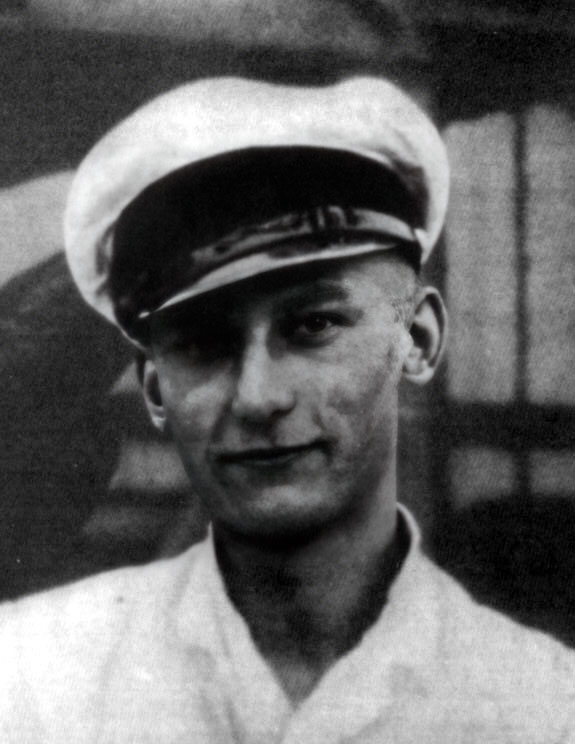
Harry Hahn was a resistance fighter against the Weimar Republic and a Blood martyr to the National Socialist movement.
On election day, 10 April 1932, the NSDAP guards who were on duty in front of the polling stations in Hamburg had a hard job. When the last ballot box was closed, they too were able to march off to their storming pub. Since uniforms were banned, they marched in civilian clothes. A small troop of SA men is met by fifteen Reichsbanner people on foot and thirty on wheels. Feeling superior, the Reds organise the attack. While the cyclists block the way, the others charge at the small band of resisting SA fighters with pistols and knives. Killed by gunfire, the SA man and steward Harry Hahn from Leipzig and the SA man Heinz Brands bleed to death on the pavement of Hamburg. Harry Hahn died at the age of twenty-six. Shortly before his death, his baby daughter was born. His wife took her own life a few months later in despair. The child was sent to an orphanage.
A street in Hamburg-Horn was named after him. A Hamburg Alster ship bore his name, which currently had to be renamed „Wischbek“.
Silvester Gratzl
(* 28 December 1907, † 17 April 1932 in St. Andrä i. Lavanttal)
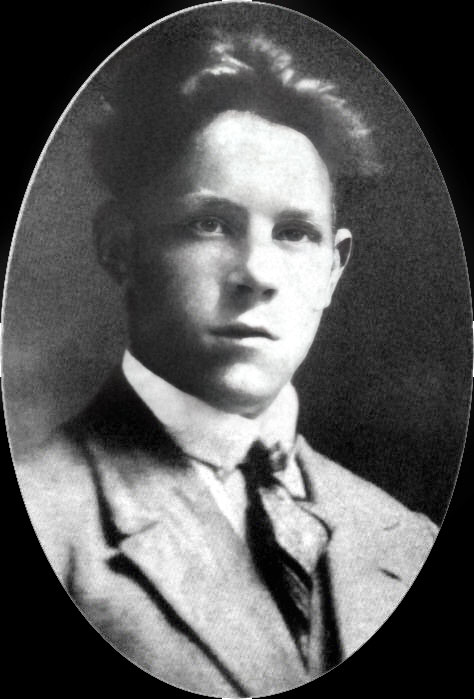
Silvester [Sylvester] Gratzl was a Blood martyr of the National Socialist movement.
Silvester Gratzl joined the NSDAP and the SA in May 1931. He was a twenty-five year old assistant barrel maker from St. Andrae in Carinthia and on 15 April 1932, after a political dispute, was seriously injured by a Marxist after incitement by Social Democrats through knife wounds, whereupon he died two days later.
Johann Broweleit
(* 13 June 1883, † 23 April 1932 in Duisburg-Hamborn)
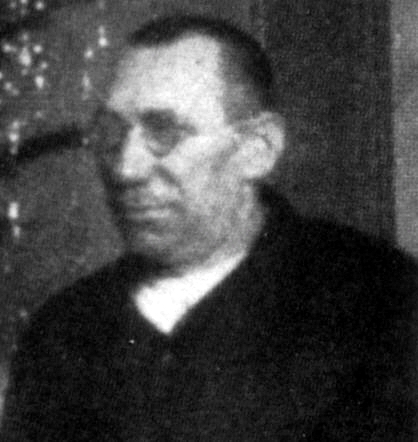
Johann Broweleit was a resistance fighter against the Weimar Republic and a Blood martyr of the National Socialist movement.
Despite a severe visual impairment, Johann Broweleit volunteered to fight in the First World War against the states that had declared war on Germany. He went to the Western Front, but did not join the fighting troops.
On 23 April 1932, a group of National Socialists from Hamborn were attacked by a twenty-five-strong superiority of communists while distributing leaflets. A bleeding man lay on the ground, the 45-year-old smelter worker Johann Broweleit. Pierced by a sharp blade, he died after a few minutes. The murderer, an eighteen-year-old communist named Wladislaus Labitzki, fled to Russia immediately after the crime.
The former Grünstraße in Duisburg, where the murder took place, bore the honorary name Johann-Broweleit-Straße during the Third Reich.
Johann Lüchtenborg
(* 16 December 1904, † 23 April 1932 in Harkebrügge (Oldenburg))

Johann Lüchtenborg was a resistance fighter against the Weimar Republic and a Blood martyr to the National Socialist movement.
Johann Lüchtenborg joined the NSDAP and the SA in February 1932.
On 10 April 1932, Johann Lüchtenberg, a worker in Harkebrügge near Oldenburg, confronts the two perpetrators while tearing down an NSDAP election poster. After being stabbed in the neck, he sinks to the ground. Afterwards the perpetrators continue to kick him. He dies on 23 April 1932. The murderers were centrists misled by agitation. They received light prison sentences of one year and three months and were soon amnestied.
The SA home of Sturm 21/20 bore the name of the slain man in the Third Reich. In Oldenburg, the new housing estate „Lüchtenborg“ built under National Socialism was named after him.
Udo Curth
(*30 October 1909, † 24 April 1932 in Berlin)

Udo Curth was a resistance fighter against the Weimar Republic and a Blood martyr to the National Socialist movement.
On 24 April 1932, the SA man Udo Curth, a young commercial employee from Berlin, was walking home with some comrades after his voluntary service in the traffic office when they met the communists Franz Mels and August Wellnitz, who were smearing the walls of the houses and the pavements with hammers and sickles. Udo Curth is shot dead in front of the house at Möckernstraße 64 while trying to call the police.
The murderer, Franz Mels, a member of the Kampfbund gegen den Faschismus, is sentenced to four years in prison by the Weimar systemic justice. The other, August Wellnitz, escapes to Russia with the support of the Red Aid.
The newspaper Der Angriff wrote about the events:
Mourning flags in the spring sun
Last oath to Udo Curth
The whole of German Berlin mourns - Ten thousand at the fresh grave
A balmy spring day that almost seems to herald summer. Once again, the red swastika banners billow out in gentle winds to many thousands in the Reich capital. But not joyful of battle and victory, as days ago. Wreaths of mourning announce that this time the last tribute and sacred vow is to a young martyr of our glorious movement. And above, in the blue skies, an aeroplane sways, also decorated with large swastika flags. It circles in wide arcs over the Luisenstädt cemetery, where for the fifth time in a few months thousands and thousands are gathering to pay their last respects to a comrade murdered by red beasts. (...) Yesterday we buried the former SA-man Udo E. Curth: „Clear the line of fire!“ with this calm shout to a fellow henchman, a degenerate Bolshevik creature cold-heartedly shot him down, a few hours before the grandiose victory of our movement, which was one of the fruits of his self-sacrificing work, and which he was not allowed to see in this life. German Berlin honours him like a prince. Once again it is our priest Wenzel who speaks to us in moving words in the chapel, which can only hold a tiny fraction of the mourners. The brave parents stand in a noble frame at the coffin of their son. Next to them is his younger brother and comrade-in-arms, who makes a silent vow on his behalf. Then the seemingly endless funeral procession strides through the upstretched arms of the masses to the open grave, where Dr. Goebbels calls out our sacred oath to his comrade. „It was not the best who gave birth to this present state. But it will be the best who will soon drive it down from its thrones.“ The people are already making themselves the avengers of our martyrs: a few hours after the bloody deed, those behind this murder were miserably beaten up in the electoral battle. The group leader of the former Gruppe West, Freiherr v. Wechmar, the standard leader of the former Standarte 8, Karl Heck, the Sturmführer of the former Sturm 26, Vogt, the section leader of the Yorck section, Pg. Boetzer, they all shout their combat vow to the fallen comrade. Pg. Prinz August Wilhelm also pays his last respects, as do Dr. Meinshausen and many others of our new state parliamentarians. We want to fight for your resurrection, Nordic blood must not perish. So sounds the storm song, over the graves. It is the oath that burns on the hearts of us all. [...]
Franz Hilz
(*28.1.1904 - † 2.5.1932)
District Munich-Upper Bavaria, SA Group Hochland

The name of the Blood martyr Franz Hilz appears across sources, but is not mentioned in various essential lists and enumerations of the NSDAP. The background for this could be that there were doubts about the political character of the deed.
The first reports on the bloody deed in the „Wolfratshauser Wochenblatt“ describe the circumstances of the confrontation. However, the victim and the perpetrator are initially not assigned to a political group [issue 100 of 2 May 1932]:
„Serious bloody deed in Icking! Tonight at about 2 o’clock a terrible bloody deed occurred in front of the Klostermair estate in Icking, in the course of which a good young man lost his life and another was seriously injured. Around the same time, a number of young people came on their bicycles from Zell, where they had attended a dance. In front of the Klostermair’s estate in Icking, a violent exchange of words took place between the aforementioned and a group of participants in the May dance at the inn, resulting in a serious stabbing. Franz Hilz, a farmhand employed by Mayor Pitschesrieder, was stabbed in the thigh, [which] resulted in his death by bleeding to death due to an injury to the aorta. The ledfige] servant of Mr. Kl[?] Milker Franz Wenningere]? [suffered] a very serious injury through a stab in the lung. In the early hours of the morning he was taken by the local ambulance column to the local hospital, where he lies in a precarious condition. Mr. Klostermair’s unmarried farmhand, Michael Gattinger, received a lighter injury, but also had to be taken to the local hospital. As suspects of the crime, 6 arrests were made, mostly of young people living in Nantwein. The actual cause of the serious bloody deed, which brought such a terrible end to the beautiful 1st of May and brought great suffering to their families, has not yet been fully clarified. The public prosecutor’s office had [still] taken care of the matter in the course of the night. [Issue 101 of 3 May 1932]: We learn the following about the bloody deed in Icking: The six arrested are the single locksmith Otto Hanel from Bludenz (Oest), Franz and Nikolaus Pikolruaz, Schumacher’s sons, Josef Steinach, labourer, Matthias Pickl, horse butcher’s son, Ludwig Gigi, basket maker, the latter all from Nantwein. Otto Hanel seems to be the main perpetrator. The public prosecutor’s office is eager to completely clarify the cause and the actual perpetrators of the serious bloody deed. The post-mortem examination of the stabbed man’s body took place yesterday afternoon. The condition of the severely injured Melker Wenninger is still serious, but today a slight improvement can be noted. The arrested men, of whom Ludwig Gilgl was released, made a racket in front of the inn ‘Zur Post’ in Ebenhausen before they arrived in Icking. They had sought admission in vain. At the end of Ebenhausen they fired revolver shots.“ [Additions and partly different spellings of proper names are due to the poor state of preservation of the original source; editor’s note].
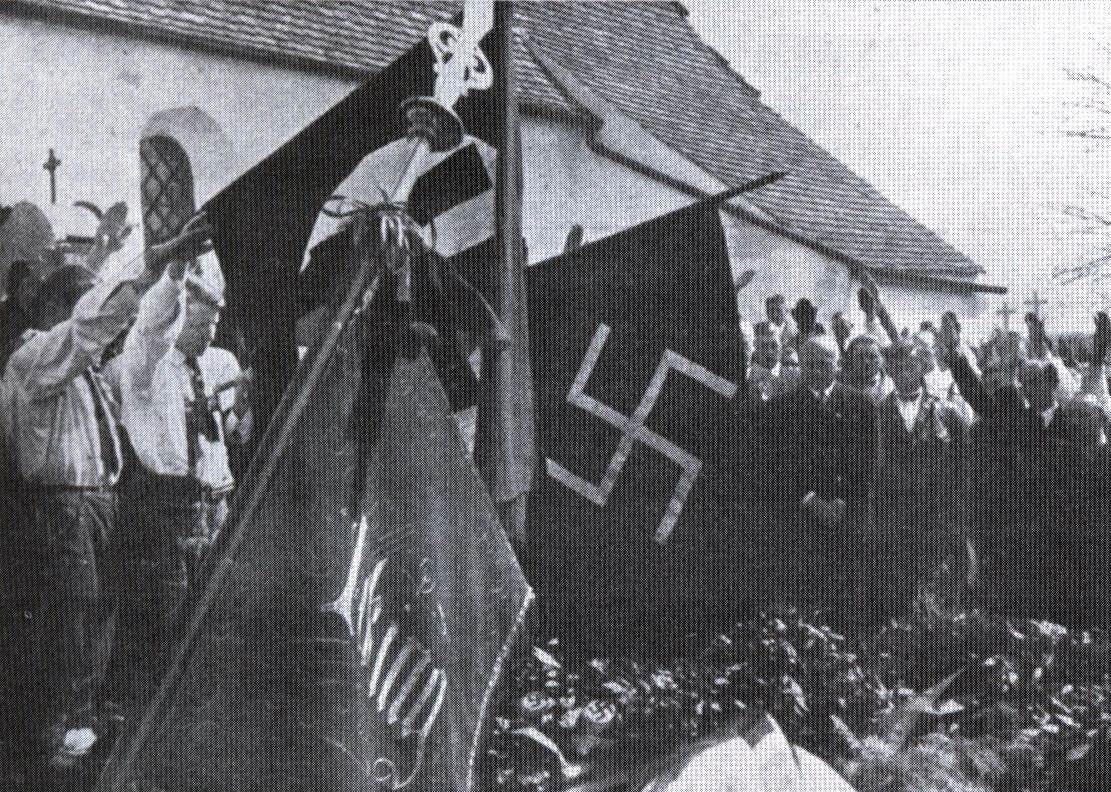
Flags lower at the grave of Franz Hilz.

The funeral procession for the killed man
Only in the newspaper’s report on the funeral of Franz Hilz are there clear indications of the political affiliation of victim and perpetrators: [Issue 102 of 4 May 1932] „[...] The murdered man was a National Socialist and belonged to the disbanded SA before the ban; those arrested as suspects of the vicious murder, among whom the murderer is certainly to be found, are described as Communists. Even if the immediate cause of the bloody deed does not lie in the political sphere, - the ultimate background will still have to be sought there, for the perpetrators are communists, and the two other seriously injured are former SA men [...]“ The newspaper „Tölzer Kurier“ mentions the perpetrators as communists from the workers’ settlement and red stronghold Nantwein. Hilz and the other wounded are clearly described in the same newspaper article as members of the NSDAP.
Franz Hilz was born in Icking, Bavaria, about thirty kilometres south of Munich.
During the May Day procession and the subsequent celebrations, the twenty-eight-year-old wore the party badge of the NSDAP and was thus recognisable as a National Socialist. The perpetrators are said to have announced immediately after the aforementioned first confrontation from the pub „Zur Post“ in Ebenhausen that they „wanted to stab something“.
The fatal blow to Franz Hilz was a stab with a knife, which hit the twenty-eight-year-old through the testicle into the abdomen and caused severe bleeding. Only when some farmers, among them the mayor, arrive at the scene of the crime due to the tumult of the altercation, can the six attackers be overpowered and held until the police arrive.
The SA-Sturm 25/2, Solln bore the traditional name „Sturm 25 Franz Hilz“.
Paul Stenzhorn
(* 9 July 1899, † 5 May 1932 in Oberhausen a. d. Nahe)
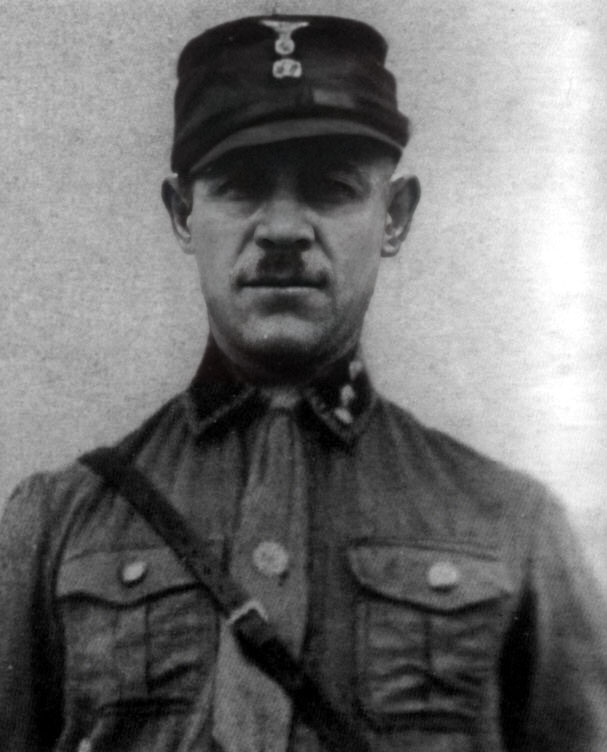
Paul Stenzhorn was a resistance fighter against the Weimar Republic and a Blood martyr to the National Socialist movement.
Although not yet of age, Paul Stenzhorn volunteers to fight in the First World War against the states that had declared war on Germany.
The SA man Paul Stenzhorn was a locksmith from Oberhausen on the Nahe and was known as a particularly brave fighter against political separatism. He campaigned intensively against the efforts to secede West Germany in the form of an independent republic. This plan was primarily pursued by the Centre Party of the time.
On 5 May 1932, Paul Stenzholz was sitting with some friends in the youth hostel on the Lemberg when the notorious centrist Karl Baab from Oberhausen approached him and asked him to come outside. The Sturmführer stepped out with him. Without an exchange of words, Baab drew a pistol and fired two shots at him at close range, which were instantly fatal.
The wife and boys of the fallen Sturmführer mourned him. They were supported by the NSDAP to save them from the worst poverty. The murderer, however, was sentenced by a court of the Weimar system to three years and seven days in prison.
A memorial stone was later erected at the site of the murder:
Here Paul Stenzhorn fell
on 5 May 1932 by murderer’s hand
in the struggle for the Third Reich
Silvester Fink
(* 10 March 1876, † 27 May 1932 in Innsbruck)
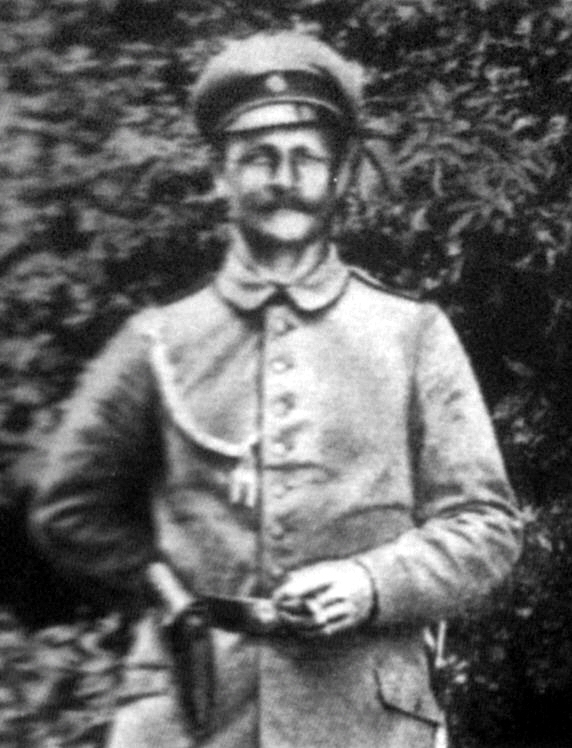
Silvester Fink was a Blood martyr of the National Socialist movement.
The butcher’s assistant Silvester Fink joined the SA Reserve. On 27 May 1939, a meeting of the NSDAP was planned in Höttingen near Innsbruck in the „Goldener Bär“ pub. This meeting had been announced and advertised beforehand by distributing handbills. Beforehand, the Social Democrat Dr. Kunst publicly agitated against the „fascists“ with a speech.
There are about 80 National Socialists in the hall when it is stormed by 150 Communists and Social Democrats with brass knuckles and knives. Together with the police, they succeed in forcing the Reds out of the hall. Suddenly shots are fired. Silvester Fink lies stabbed in his blood. The ambulance called in is not let through and is pelted with stones. Finally the police call in the military for reinforcements to get the red mob under control. The social democrats and communists unanimously follow the dying Silvester Fink to the hospital and engage in another brawl with his comrades and the police, who try to protect him. Silvester Fink succumbed to his wounds in hospital on 27 May 1932.
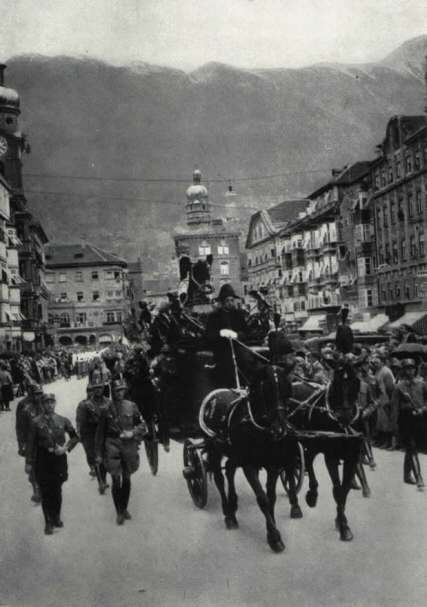
The funeral of Silvester Fink
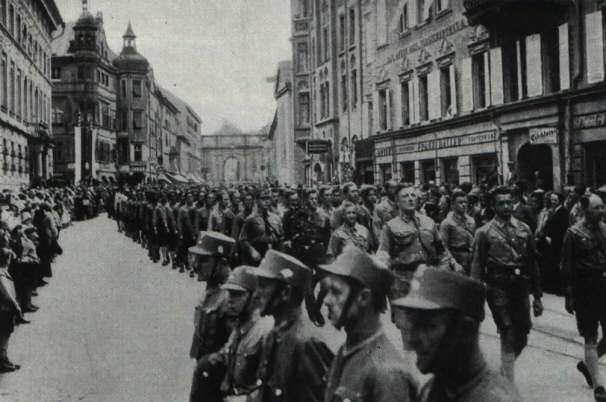
Last escort for Silvester Fink in Innsbruck
Jodokus Kehrer
(* 2 March 1889, † 31 May 1932 in Burscheid district of Düsseldorf)
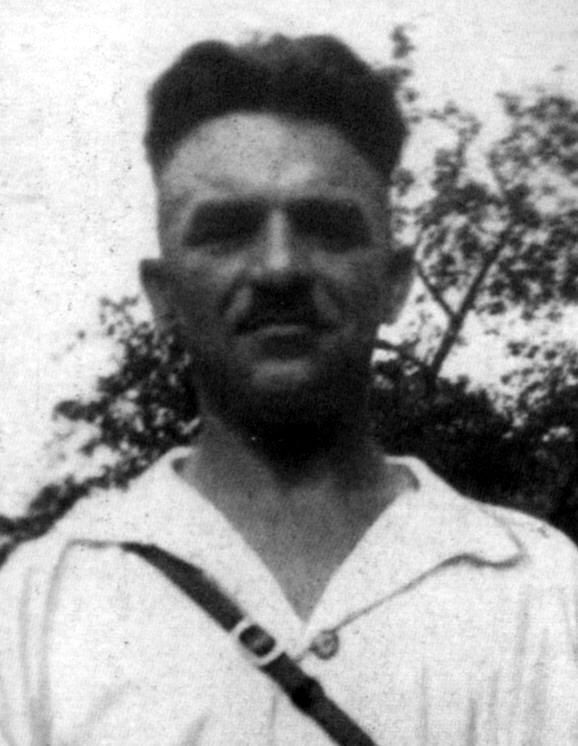
Jodokus Kehrer war ein Widerstandskämpfer gegen die Weimarer Republik und ein Blutzeuge der nationalsozialistischen Bewegung.
Nach einer nationalsozialistischen Versammlung in Wermelskirchen begeben sich am 31. Mai 1932 dreißig Parteigenossen geschlossen über Land in ihren Heimatort zurück, unter ihnen der SA-Truppführer Jodokus Kehrer aus Burscheid. Dabei werden sie von Kommunisten angegriffen, können jedoch einen festhalten, um ihn der Polizei zu übergeben. Auf der Landstraße kommt ihnen plötzlich ein Motorrad mit Beiwagen entgegen, das mit den beiden, bereits vorbestraften, kommunistischen Stadtverordneten Pulm und Berger besetzt ist. Auf zehn Meter Entfernung halten die beiden Kommunisten an und feuern zehn Schüsse blindlings in die nationalsozialistische Schar hinein, die ihren Weg völlig arglos fortgesetzt hatte. Der Polizeibetriebsassistent a. D. Jodokus Kehrer, dreiundvierzig Jahre alt, verheiratet und Vater zweier Kinder, wird durch einen Kopfschuß tödlich getroffen.
In Leverkusen trug eine Straße seinen Ehrennamen, die nach der Besetzung Deutschlands 1945 vorübergehend in Von-Ketteler-Straße umbenannt wurde. In der neu gebauten Siedlung Neuss-Reuschenberg wurde im Dezember 1937 eine Straße nach ihm benannt.
Emil (Erich) Fröse
(* 3 March 1905, † 3 June 1932 in Lünen)
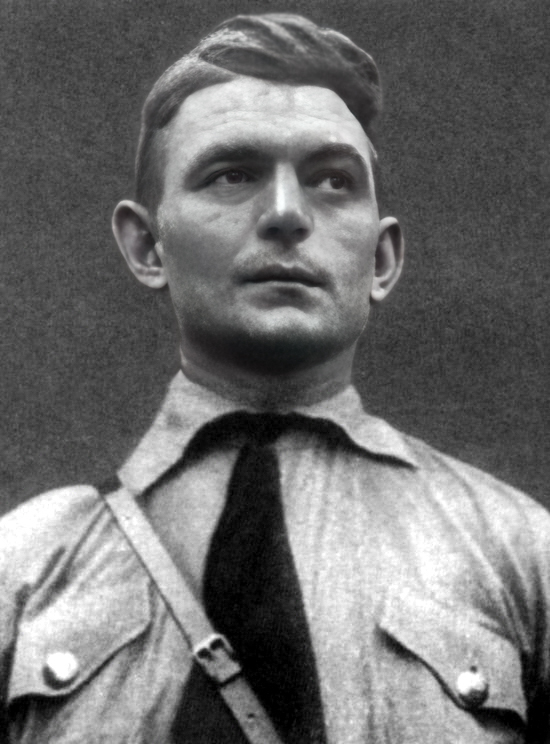
Emil (Erich) Fröse was a resistance fighter against the Weimar Republic and a Blood martyr of the National Socialist movement.
The miner Emil Erich Fröse joined the NSDAP and the SA in 1931.
„We Bolsheviks seize power now! Something else will happen here tonight.“
With these words, the communist Seibel enters the National Socialist public house „Zur Jägerklause“ in Lünen on 3 June 1932. After further bloodthirsty speeches, the landlord orders him out of the pub. Word quickly becomes deed. Still standing in the doorway, he pulls out a pistol, a shot rings out and the SA squad leader Emil Erich Fröse collapses dead. A grieving widow and a child mourn the husband and father.
During the funeral oration, Rev Mendel said:
„(...) I raise an open grave accusation against the one who is responsible for the fact that a young human life was taken away in such a terrible way. (...) The deceased also expressed his gratitude to you comrades and comrades-in-arms. You all want to work together with him for your ideal and your high goal in the reconstruction of our depressed nation, which is sinking deeper and deeper. The blood of martyrs will one day reap blessings,even if you are despised, persecuted, mocked and ridiculed, even threatened with your lives, as the deceased had to lose his life through the deceitful deed of a nefarious murderer. Their task is to call the German people to vigilance, so that they may stand up for the revival of a Germany of freedom. The deceased had to die so that Germany might live.“
The Sturm 1/190 bears the name „Emil Fröse“ in the Third Reich.
A commemorative plaque was unveiled in his honour in Lünen.
Hans Hilbert
(* 24 October 1909, † 19 June 1932 in Barmen)
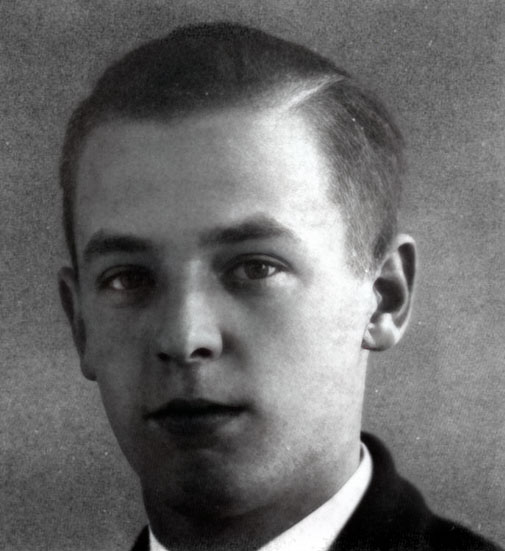
Hans Hilbert was a resistance fighter against the Weimar Republic and a Blood martyr to the National Socialist movement.
The SA in Barmen had scheduled a large propaganda march on 18 June 1932. In the evening, when the SA had already started, the ban on uniforms became known. The Brown Shirts, however, carried out their march in white shirts or bare-chested, ignoring the hate-filled rage of the commune. In their ranks marched the motorist and SA Scharführer Hans Hilbert from Wupperthal-Barmen. On his way home on 19 June 1932 he was attacked by communists. He was shot in the heart and the murderer tore off his badge. That same night, Hans Hilbert dies at the age of 22. And that was his confession at the hour of death, the confession of all SA men:
„I like to die for my Fatherland and for my Führer Adolf Hitler!“
In the newly built settlement of Neuss-Reuschenberg, a street was named after him in December 1937.
.
Wilhelm Hambückers
(* 15 March 1885, † 20 June 1932 in Übach)
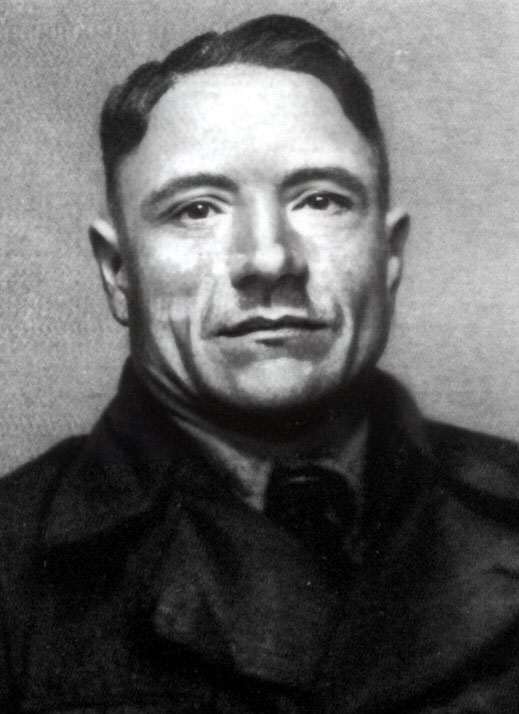
Wilhelm Hambückers was a resistance fighter against the Weimar Republic and a Blood martyr of the National Socialist movement.
In the night of 19 to 20 June 1932, the SA Sturmführer Wilhelm Hambückers, Sturmbannadjutant II/25 from Merkstein near Aachen, was shot in Übach (Geilenkirchen district) from ambush. An unemployed miner, father of two daughters and three stepsons, becomes the victim of communist murder. The rapid development of the storm is due to his activity. Under his leadership, seventy men followed the young Sturm in a few months, for the most part miners, all ready to spread Adolf Hitler’s idea in the Sturm area.
„He was my best,“ says his Sturmbannführer, „an upright, a martyr.“
Kurt Hilmer
(* 22 June 1911, † 20 June 1932 in Erkrath (Rhineland))
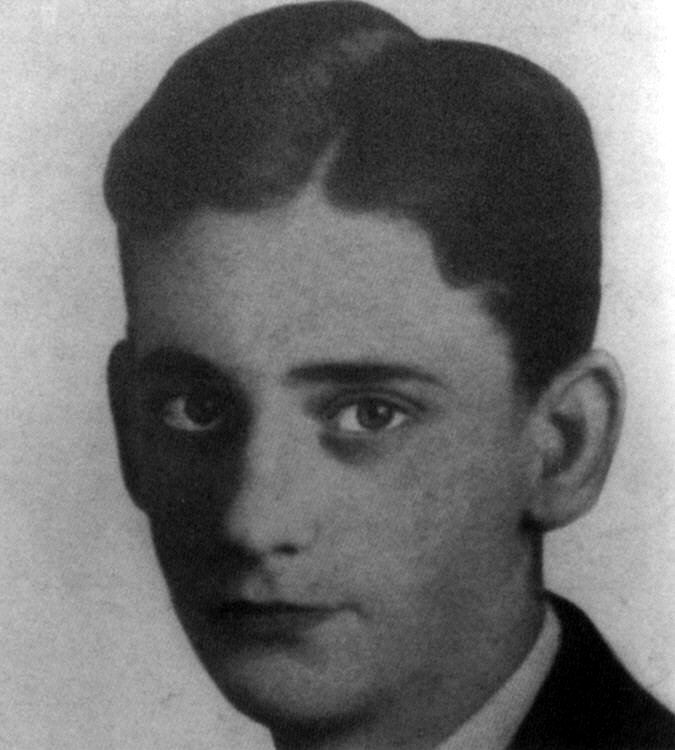
Kurt Hilmer was a resistance fighter against the Weimar Republic and a Blood martyr to the National Socialist movement.
When SS-Scharführer Kurt Hilmer, a clerk from Erkrath in the Rhineland, came near the NSDAP office on an off-duty day, 20 June 1932, he noticed the lively activity of communist mobs nearby. Kurt Hilmer immediately reported his observations to the guard in front of the office when twelve shots were already fired from the opposite embankment. Kurt Hilmer dies two days before his twenty-first birthday.
Also in 1932, a large quantity of cyanide was seized from communist functionaries in Düsseldorf. The poison was to be used to murder political opponents.
The Weimar systemic justice stopped the investigations against the murderers.
The murderers of Kurt Hilmer, the communists Emil Schmidt, Otto Lukat and Peter Huppertz, were not tried again until after the seizure of power, finally sentenced and executed on 27 March 1934.
Remarkably, this judgement was even recognised as lawful after the so-called „liberation“ in 1945 and throws a clear light on the „law“ of the then so-called „Weimar Republic“.
In Erkrath, Kurt-Hilmer-Platz and several streets were named after him. In the newly built settlement of Neuss-Reuschenberg, a street was named after him in December 1937. An SS storm in Düsseldorf bore the name „Kurt Hilmer“.
On 9 November 1938, a funeral service was held in Erkrath for the SS man Kurt Hilmer, who died there in 1932. A large Haan delegation took part. The people of Haan also commemorated the SA man Karl Paas from Gräfrath who died on Schillerstraße in 1930. In the evening, the local NSDAP group met at the Windhövel Hotel, and the Hitler Youth also commemorated the martyrs.
Herbert Howahrde
(*18.8.1914 - † 20.6.1932)
District Dusseldorf
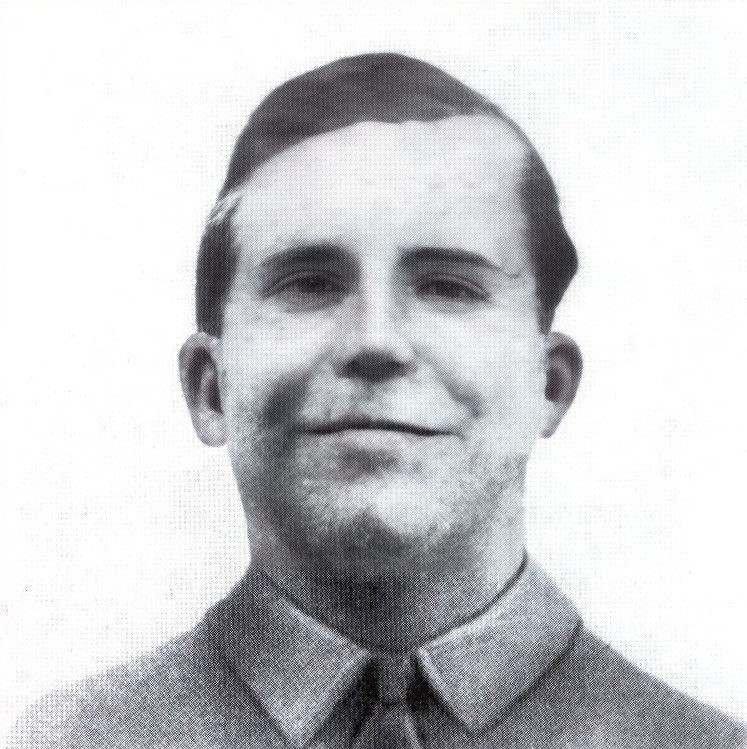
„Hit the fascists where you meet them!“
From the communist roadhouse opposite, the men could easily read the red letters on the wooden fence. However, they no longer needed this kind of encouragement, since they were hardened class fighters and anti-fascists.
On 18 June 1932, around noon, the Hitler youth Herbert Howahrde passed the restaurant in Wuppertal’s Paradestraße. Comrades had quickly jumped onto the pavement and insulted the boy as a „fascist dog“. As if to confirm the battle cry on the wooden front across the street, the powerful blow of a „workers’ fist“ sends the seventeen-year-old to the ground. The men maltreat the Hitler Youth with hard boot kicks. Only after the attackers have retreated back into the pub does Howarde pull himself together. When he arrives at home a little later, he is initially able to calm the mother down, despite the clearly visible traces of the altercation. Only later does she call a doctor who, after a brief examination, has the boy admitted to hospital immediately. Two days later, the Hitler Youth Herbert Howahrde dies in the early hours of the morning.
The „Westdeutsche Beobachter“ then wrote: „A good war widow lost her 17-year-old son and the German freedom movement lost one of its best, whose name is forever engraved in the list of those who sacrificed their lives for Germany and in the belief in its resurrection.“
In 1938, the city of Wuppertal renamed Königsplatz as Howardeplatz.
Why Herbert Howarde did not appear in numerous National Socialist accounts of the Blood martyres of the time of the struggle, yet the Hitler Youth honoured him as the dead of the movement, as did his home town, is unclear.
Helmut Köster
(* 2 October 1909, † 21 June 1932 in Berlin)

Helmut Köster was a resistance fighter against the Weimar Republic and a Blood martyr to the National Socialist movement.
On 21 June 1932, Adolf Hitler and Hermann Göring go to the then Minister of the Interior to demand protection or the right of self-defence for their comrades. To no avail. National Socialists were fair game in the „Weimar Republic“. They were just „National Socialists“.
Sturm 24 in Berlin has its first uniform maul after the lifting of the ban on uniforms. On their way back from duty, sixteen Hitler men are shot at from a communist criminal bar on the corner of Gneisenaustraße and Scheiermacherstraße in Berlin. Twenty-three-year-old merchant and SA Scharführer Helmut Köster sinks to the pavement, hit in the temple by a bullet. He dies the same day in hospital.
The Berlin Gauleiter Joseph Goebbels noted in his diary one day after the murder:
“The Bolshevik blood terror is assuming intolerable forms. The government is completely inactive against it.“
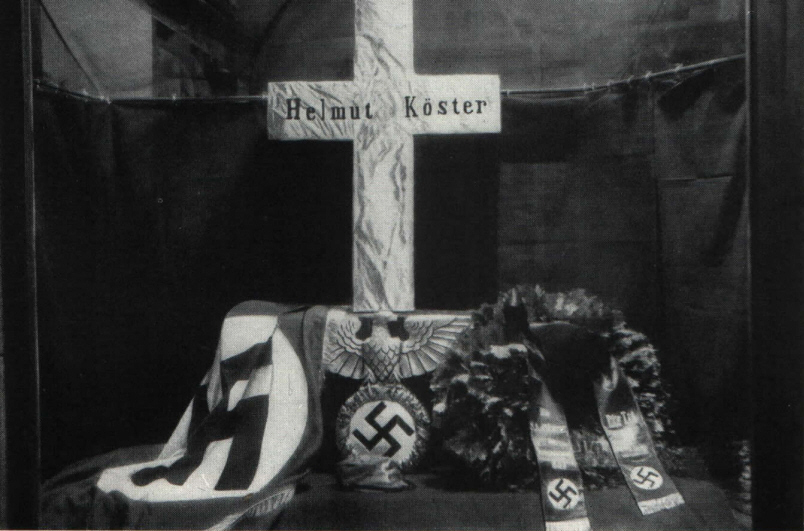
In memory of Helmut Köster.
Heinrich [Heinz] Habenicht
(* 13 September 1905, † 23 June 1932 in Dortmund)
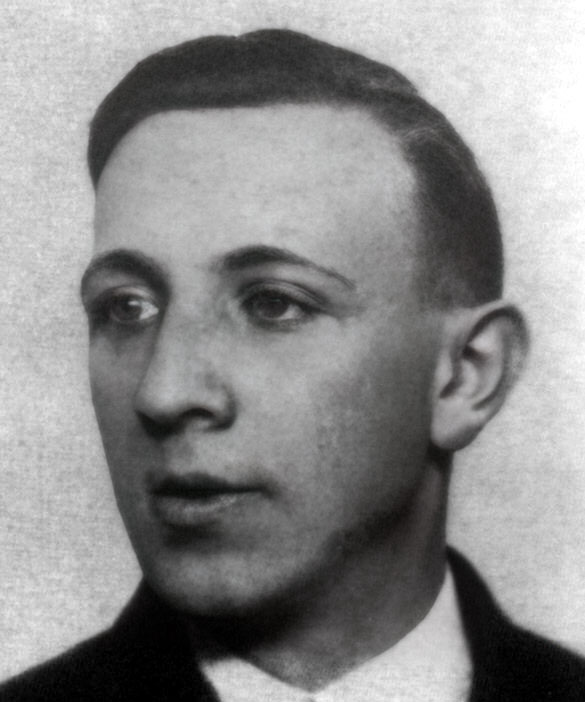
Heinrich [Heinz] Habenicht was a resistance fighter against the Weimar Republic and a Blood martyr of the National Socialist movement.
From heroes’ graves grow not palms, but swords!
These words of a German man sounded over the grave of the SA man Heinrich Habenicht, a clerk from Dortmund, who was murdered by communists on 23 June 1932.
Heinrich Habenicht joined the NSDAP and the SA in January 1932. On the day of his murder, he was assigned for the first time to protect the hall for an event. Suddenly the pub „Zur Bergschenke“ was fired upon by communists. The 60 or so comrades took cover. Only one lay dead, hit by a bullet: Heinrich Habenicht. Another five comrades were seriously wounded in the communist fire attack.
The National Socialist newspaper „Rote Erde“ wrote the following about this murder:
“The attack on a group of National Socialists turns out to be a planned action by the KPD and the Red Combat League. The National Socialists in a strength of sixty-five men were shot at from the surrounding houses, from the gardens and from behind walls. The SA man Heinrich Habenicht fell to the ground, badly hit, and another five party comrades were seriously injured. The communist mob fell upon the injured lying on the ground and maltreated them.
The police, who had accompanied the National Socialists in strength of three officers, were completely powerless. They had completely lost their nerve. The police officers who were posted at the Bergschenke also showed a completely incomprehensible attitude. Instead of taking action against the red murder bandits, they confronted the fleeing National Socialists with the shout „Hands up! It was only when a police officer arrived after a short time that his commando ruthlessly took action. It was only thanks to his intervention that the murderous commune’s rampage came to an end.“
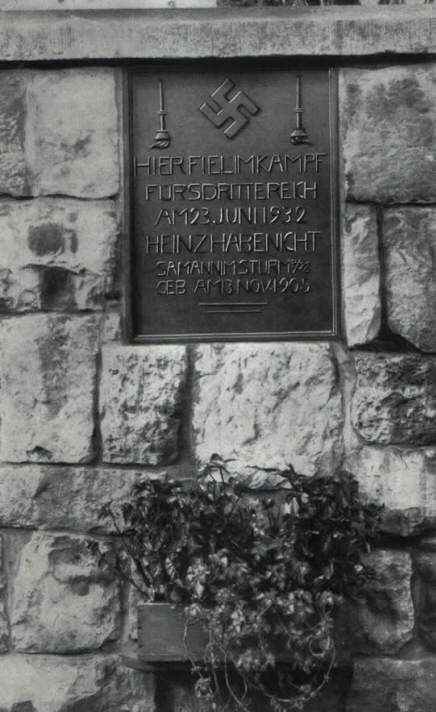
Memorial plaque at the murder site for Heinrich Habenicht
Max Kiehne
(*22.6.1896 - † 26.6.1932)
District Cologne-Aachen
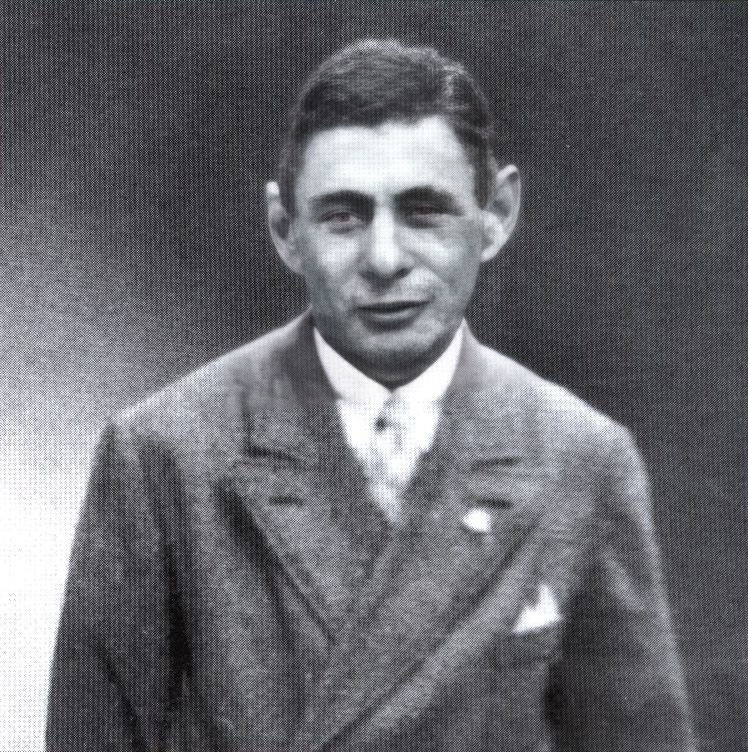
Max Kiehne is not listed as a Blood martyr in the official NSDAP lists. This is presumably due to the fact that the dead man belonged to the Stahlhelmbund, which was not a branch of the NSDAP until it was transferred to the SA in 1934.
Only the book „20 Years a Soldier of Adolf Hitler“ lists the name Max Kiehe as having fallen in the Cologne-Aachen Gau. Another contemporary source refers succinctly to the circumstances of his death.
On 19 June 1932, a joint march by the Sturmabteilung, Schutzstaffel and Stahlhelm was scheduled in Cologne. Two days before, the police chief Bauknecht banned the event. The units are then told to take a walk through the city in disbanded order so as not to violate the ban. The propagandistic effect, however, is not to be dispensed with. Although the ban is thus circumvented, the police intervene against the right-wingers. The situation escalates on Apostelmarkt when the officers clear the square.
Kiehne, a Stahlhelm man, and other participants in the procession are pushed away by the police. An officer allegedly fires his carbine for no reason and seriously wounds the thirty-six-year-old. Shot in the knee, the professional photographer is taken to hospital and dies there a week later as a result of the injury.
Fritz Borawski
(* 29 August 1902, † 26 June 1932 in Wattenscheid)

Fritz Borawski was a resistance fighter against the Weimar Republic and a Blood martyr of the National Socialist movement.
On 26 June 1932, miner and SS member Fritz Borawski dies of a bullet to the head in Wattenscheid after being shot at by communist mobs with comrades in Sommerdellenstraße.
The communist murderers Meißner, Bergmann, Erasmus and Becker were celebrated by their cronies as „victors over the fascists“.
The street from which the fatal shot was fired was named after Fritz Borawski in the Third Reich. In Bochum, an SS storm bore his honorary name.
Werner Gerhardt
(22 December 1912, 30 June 1932 in Zeitz)
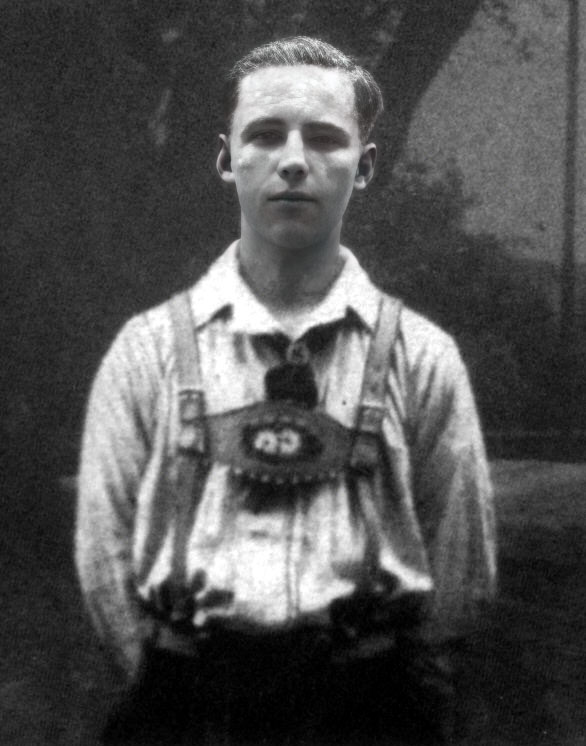
Werner Gerhardt was a resistance fighter against the Weimar Republic and a Blood martyr to the National Socialist movement.
His sacrifice
After four weeks of agonising suffering, Werner Gerhardt, a wood sculptor and leader of the Zeitz Jungvolk, dies on 30 June 1932.
On 1 June 1932, it is the Hitler Youth’s home evening. No less than eight attacks on comrades of the HJ have been carried out in the previous three days. The Hitler Youth are justifiably agitated and want to repay like with like. Their leader Werner Gerhardt calms them down by saying:
„They are, after all, only poor, incited proles, there are so many good people’s comrades among them.“
A quarter of an hour later, one such incensed comrade stabs him in the body with a knife. A Reich bannerman is arrested as the perpetrator. The workers’ boy lies pale in his bed and suffers terrible pain. „I have to pull myself together and bite my teeth so that my mother doesn’t notice, otherwise she’ll get so upset,“ he said.
He is operated on five times. Mother, brother, uncle and comrades give their blood for him to save him. During the last operation he says to his mother:
„Mum, don’t cry, I know I’m dying for Hitler.“
Two days later he dies at the age of nineteen. Two thousand Hitler soldiers and the whole of Zeitz give Werner Gerhard his last respects. The path on which he was murdered was called „Werner-Gerhardt-Weg“ in the Third Reich. The murderer Helmut Fritz receives three years in prison from the Weimar system of justice, but is amnestied soon afterwards. After the election of the National Socialists, however, he was sent to a concentration camp in Weißenfels in 1933, but managed to escape from there. Seized again, the murderer was sent there again.
Live for Hitler, die for Hitler! Like Herbert Norkus, 26 Hitler Youth had died in Germany and German Austria by 1934, becoming Blood martyres to the German youth who pledged eternal allegiance to them. What one of them, Werner Gerhardt from Zeitz, whispered to his mother with the last of his strength on 30 January 1932 was soon to apply to millions of young Germans:
„Mum, don’t cry, I know I’m dying for Hitler.“
The name Werner Gerhardt was added to the list of the Immortal Followers of the Hitler Youth.
Werner Gerhardt was mentioned in the Museum of National Socialist Elevation in Halle:
In this museum, the „struggle of our homeland in the shackles of Versailles, the hardship and misery of the creative population and the struggle for freedom of the National Socialist movement were to illustrate in documentary form the greatness of the times“, emphasising the „suffering and heroism of the individual fighter“. Robert von Klüber (Reichswehr), Otto Küfner (Stahlhelm), Werner Gerhardt (HJ) and Paul Berck (SS) were named as representatives of the numerous fighters of the Halle-Merseburg district who lost their lives in the conflict with the KPD and the police and were to receive a memorial in this museum. In doing so, the Gauleiter already mentioned the planned sections which would divide the museum, which was to be a part of the institution along with the archive and the hall of honour, into the following areas: 1. the handing down of all terrorist and arbitrary decrees and orders of the overcome system, 2. the presentation of the heroic struggle itself, 3. the deeds of the SA, SS and all party comrades in their decisive phases of struggle, and 4. the cultivation of the memory of the dead of the national movement in the Halle-Merseburg Gau. Rudolf Jordan then called on all National Socialists and party comrades to donate documents from the period between 1918 and 1933 to the newly established institution. Opposite a bust of Hitler, the names Werner Gerhardt and Paul Berck were displayed, and the cross wall was decorated with a swastika flag under which was written: „1933 Der Sieg“.
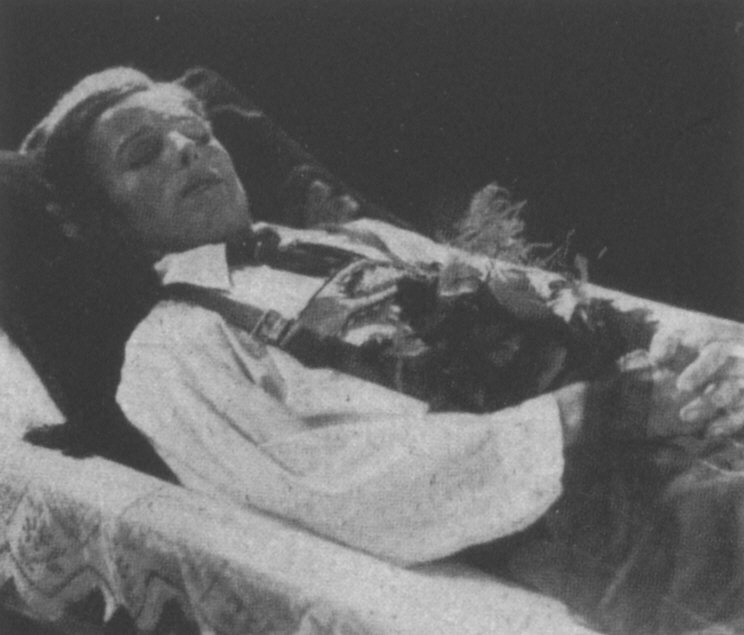
The murdered Hitler Youth Werner Gerhardt
Contemporary report:
The dead comrade Werner Gerhardt. Many comrades of the SA, SS and HJ sacrificed their lives in the fight for Germany’s liberation from the Novemberschmach. His comrade Heyne tells us about his struggle and his death, about the great death of Werner Gerhardt: „On a cold day in February, I, detached from the SA to the HJ, set out for the first time with the Zeitz troop entrusted to me on a night march. The snow falls softly and soon turns to rain. The cheerful mood seems to be over, the cold rain makes the otherwise cheerful horde dumb and gloomy. Next to me marches a comrade who is already 20 years old but still enthusiastically serves with the Jungvolk. His blond hair flutters in the wind. The more it rains, the worse the mood becomes. Suddenly the blond boy next to me starts singing: „The linen weavers have a clean guild“. He sings this cheerful song merrily, the others join in, the mood is back. The comrade who brought back the cheerfulness to all of us was Werner Gerhardt. Soon afterwards, on a Sunday morning, the Hitler Youth and the Jungvolk come together to commemorate the Hitler Youth who have been stabbed to death by Red murder. For the first time we come together with the Jungvolk. Their leader is standing among the young people. One wave and the wild horde is quiet. I speak of struggle, hardship and sacrifice. At the end we sing the song of the good comrade. The boys have tears in their eyes, they snuggle up to their „Werner“. Loyal comrades! - Jungvolk on the move. Werner Gerhardt marches in front. In a short time he had created a handsome ensemble. The pennant waves proudly in the wind. Werner sewed it himself, together with his mother. Every boy is proud to wear it. At the forester’s they go to their quarters. But, alas, when the feeding session is about to begin, two boys have forgotten their bread. Werner Gerhardt is quickly on the spot. He shares his bread and gives half to each of them. The boys enjoy it. Their Werner fetches two dry rolls. Comrade and leader, that was Werner Gerhardt. Sunday morning. The Hitler Youth march out into the Zeitz forest. They have only recently learned a new song that their Führer heard in Potsdam with the Berlin Hitler Youth: „If I don’t return, what of it, if only my fatherland, my Germany is free.“ We walk through the forest. Suddenly there is a big hello. Our Young People, also on the way, have discovered us and greet us with an Indian howl. We quickly storm up the mountain to meet our boys. We can’t believe that the song „If I don’t come back“ is coming from 20 boys’ throats. What a surprise for us! Werner Gerhardt taught the boys; he didn’t tell us anything to make us happy. 31 May. Home evening of the Hitler Youth. No less than eight attacks have been carried out on comrades of the HJ in the previous three days. The protective measures are talked through. „All go home united!“ is the order from the leader of the followers. The comrades are understandably agitated, they want to repay like with like. On the way home I talk to Werner Gerhardt. He doesn’t agree with the angry speeches, he says to me: „They’re only poor incited proles, there are so many good people’s comrades among them.“ A quarter of an hour later, one of these rabble-rousing comrades stabs him in the body with a knife. We had stopped at a corner to talk to some communist youth. Werner Gerhardt walks 200 steps ahead, then he collapses, screaming for help. A Reichsmann stabbed one of the best boys for no reason at all. We rushed after the criminal while some comrades were taking Werner to the doctor. Unfortunately, a policeman has already arrested him. With his pistol he has to hold back the excited boys who want to beat up the murderer. The criminal is taken to the police station in the town hall. Word of the vile bloody deed quickly spreads; a short time later, around 600 people have gathered in front of the town hall to protest against the murderous plague. The Horst Wessel song rises to the night sky like a confession. The police take up their rubber truncheons against us! - For the first time I am allowed to visit Werner Gerhardt in hospital. Pale, he lies in his bed, his blue eyes shining just like before, when I hand him a bouquet of flowers from his comrades. He speaks quietly about the operation, he asks about his boys, whether everything is being carried out properly. Once again he squeezes my hand, we look at each other, then I leave quickly so as not to show my tears. Does he already know what fate had destined for him? I speak to the nurse. She tells me about the terrible pain he has to endure. He has already been operated on twice. „I have to pull myself together and grit my teeth so that my mother doesn’t notice, otherwise she’ll get upset,“ he had said to me. Heroic courage of a German working-class boy! - Back in hospital. I am not allowed to enter his room, he is lying alone. He has been operated on for the fifth time. His mother is lying at home, she gave her blood just like her brother, uncle and comrades to save her son through blood transfusion. Four weeks of terrible agony and joking. During the last operation he says to his mother, „Mum, don’t cry, I know I have to die for Hitler.“ Two days later we receive the terrible news. We were prepared for it, and yet it squeezes the breath out of us. We clench our fists and mourn silently! On the same day, the murderer, Reichsbannermann Fritz, is transferred from Zeitz to Naumburg. His comrades greet him as he leaves the prison with the cry: „Freedom“. „Comrade Fritz unbroken,“ the Social Democratic Sudelblatt still dares to write the next day. We go to Werner’s mother. The face of this German woman has collapsed. Pale, she lies in bed when we are called into the room. At the sight of this poor worker’s wife, who had already sacrificed her husband for the fatherland in the great war, tears come to our eyes. But the woman is stronger than we are. „Don’t cry, my Werner doesn’t want it,“ she calls to us. We pull ourselves together, shaken by the greatness of this woman. She talks to us, tells us how the seriously ill man ordered everything so that everything would be in order. The successor, the cash register, everything is precisely regulated so that his young people can continue to march and suffer no harm. When she continues to tell us how Werner worked almost every day until late at night for his boys, how he sewed pennants for them, how he continued to work and earn not only for his tongues but also for his mother, then we really understand what we have lost in Werner Gerhardt. Once more we go to him, once more the coffin is opened. The last greeting for Werner Gerhardt. You did not fall in vain! When we see him lying like this, we are all gripped, whether SA, HJ or Jungvolk, we can’t help it, we have to cry; it is not pain alone, it is anger against those who tore this victim from us, who murdered Werner Gerhardt. We will always think of it. - Sadly, the bells ring. 2,000 Hitler soldiers and with them the entire German Zeitz give Werner Gerhardt his last escort. The huge procession is a terrible indictment; even the opponents stand silently by the road. The streets are crowded. After the blessing in the chapel, they go out to his resting place. The SS carry the coffin, followed by 50 boys, tears in their eyes, his best comrades, the Jungvolk. The song of the good comrade is sung and Werner Gerhardt is laid to rest. But only his body passes away, his spirit is among us, he lives in our hearts, he spurs us on to our last deed. (...)
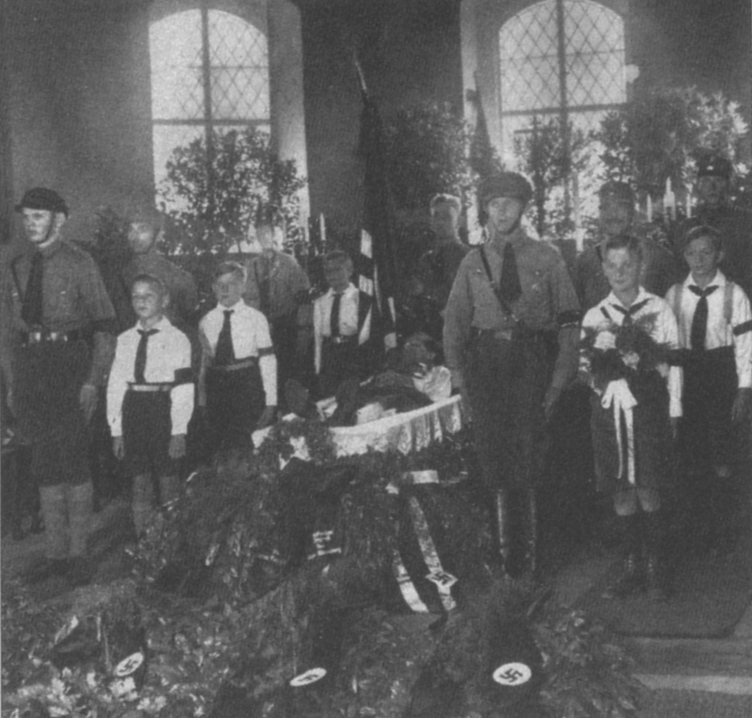
Honour guard of HJ and Jungvolk at the coffin of their murdered comrade Werner Gerhardt
Hermann Zapp
(* 14 November 1906, † 30 June 1932 in Kaiserslautern)
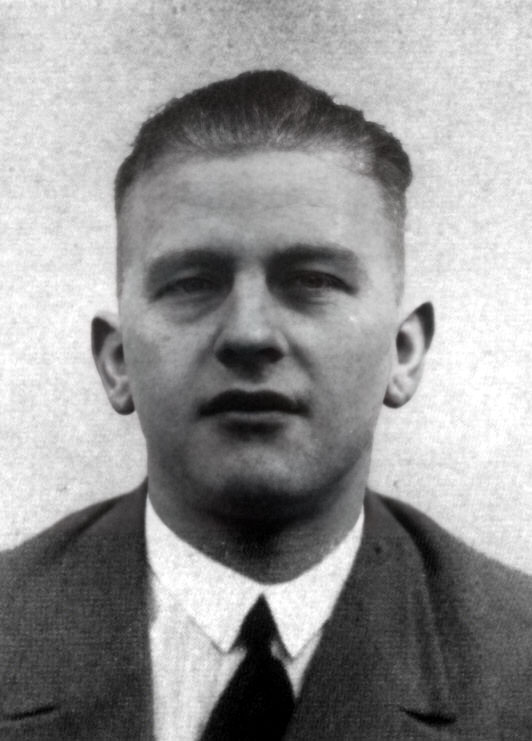
Hermann Zapp was a resistance fighter against the Weimar Republic and a Blood martyr to the National Socialist movement.
It is around 10 o’clock in the evening. The SA man Hermann Zapp, the son of the owner of the National Socialist party pub in Morlautern, is on his way home to his mother. Then, at the prison wall on the Abendsberg, the communist Mathias Heil jumps out of the ambush and fatally stabs his victim in the carotid artery. The victim drags himself about a hundred metres, then is taken to hospital by paramedics, but dies on the way there. The murderer is caught up with by the police and arrested. The latter confesses to the murder; he was a communist criminal known from the separatist period. Fifteen hundred SA men and fifteen thousand inhabitants escort the modest, solid and popular SA man to his final resting place. Each man of SA Sturmbann III/23 carried a rose in his hand as the units marched to bury their murdered comrade.
Ten years in prison was the sentence that the communist murderer received.
Hans Steinberg
(* 1 March 1906, † 1 July 1932 in Berlin)

Hans Steinberg was a resistance fighter against the Weimar Republic and a Blood martyr to the National Socialist movement.
On 1 July 1932, the boys of the „Partisan Group Röse“ have been assembled. An action planned for a long time against the brown fighters is finally to be carried out. Even before the full-scale attack, SA men walking individually are attacked. Red scouts on bicycles search the streets around Lenzener Platz in Berlin. In the evening, the attacks against the members of Storm 102 increase to such an extent that the neighbouring Stürme 41, 101 and 103 have to rush to the aid of their harassed comrades. The rabble now turns to regular small-scale warfare. The street fight lasts for hours, the lanterns are turned out, the bullets of the Komune whistle from the dark corridors of the houses, from the dimmed flats, from the roofs. The SA Scharführer Hans Steinberg, who is accompanied by two comrades, is overtaken by a cyclist and struck down and killed by a shot. His companions are attacked with daggers. In addition to Steinberg, five SA men remain lying on the pavement, seriously injured by gunshots.
Hans Steinberg left behind a small child and his pregnant wife, who gave birth to twins five months later.

Memorial on Hans-Steinberg-Platz in Berlin
The newspaper Der Angriff wrote about the events:
We lower the flags ...
German Berlin laid Hans Steinberg to rest
Now this bitter cup has also passed: Scharführer, SA man Hans Steinberg lies in the ground. The unshed but most painful tears have been choked down. The long farewell look into the tomb is done. Three handfuls of sand are spilled and purple roses, last signs of love, have trickled down like dripping heart’s blood. Now the mound is already arching over the grave in the Luisenstädt cemetery on Bergmannstraße and if it were not for the guard of honour, if they did not remain in iron stiffness and heartfelt devotion, as they do at Helmuth Köster’s grave, hour after hour, throughout the days, then perhaps the visitors to the cemetery would no longer know that yesterday we went our last way with one of our most loyal dead. That is how cruelly forgetful the times are in which we live. It is just as well! We do not have long to sing laments. We know too well that words do not lighten our heavy hearts and do not resurrect our dead. The relatives, who experienced the funeral ceremony with the deepest feelings of grief, heroic courage, boundless surrender and admirable patience, know this too. So if we once again touch fresh wounds and once again let the shattering events rise from the recesses of wildly aching memory, then it is only to memorise this fighter Steinberg, who was a living embodiment of the five duties of the SA man: decent, courageous, obedient, discreet and comradely!
Eight comrades wake ...
Eight comrades stood vigil at his bier. The storm straps lowered, the eyes directed into the distance. The armbands florid, pale as marble, hard as steel, immobile, mute. ... The soft light of the chapel candles, the sultry twilight of the hall, made the faces appear even more motionless, but whoever looked under the visors of the brown balaclavas saw the laboriously restrained, burning facial expressions: grief, hatred, pity, impotence and unbridled rage for revenge ... Eight comrades on death watch know best whom they have lost. Eight comrades on death watch have been together with the murdered man in misery and blood. They have stood together, they have fallen together. There stands the man at their heads to whom he sacrificed his young life to save the other. The threatened comrade was brought home and on the way Hans Steinberg received the fatal bullet of the murderer, whom this earthly jurisdiction will probably never call to account. The boy who dragged Steinberg from the hail of bullets to the rescue centre is also standing there. - „Heine, it’s got me!“ - „It’s not bad, Hans!“ - „Yes, Heini, yes, I’m suffocating, I ... he ... suffocate...!“ That was the end.
In the afternoon, it was still a happy day: Steinberg had got a temporary job ... Moving ... Five marks in cash. - „Kids, now I’m going to buy a balaclava!“ He arrived with the balaclava, as happy as a child, as proud as a boy in his first pair of long trousers: „Is that a cap, guys? What, that’s a cap! - Give me a mirror, how do I look? - You look great, don’t you? Now the commune can come!
She danced on. The cap fell - now they gave it to him in the grave. SA man Hans Steinberg had taken a long time before he found his way to us. He had previously been an active member of the commune, until one day, like so many of our best, the scales fell from his eyes. A commune leader had called for a demonstration against the police. But he himself stayed at home. - „Why,“ Steinberg asked him. - „Because I don’t want to have my bones smashed. Now you know for sure!“ The next day Steinberg reported to the National Socialists’ Sturmlokal: „If you want me, take me! The Commune won’t tell me anything more!“ His comradeship was exemplary. There was no delicate task to which SA man Steinberg would not have volunteered. He went countless ways at the risk of his life to protect threatened comrades. In Niederschönhausen he fended off a fatal blow from his Sturmführer and had to bear the consequences for weeks. Undeterred, he went his way, from his flat to the storm restaurant and back. A difficult path, because his house was the meeting place of the communists and how often he had been threatened that he would soon be a dead man. The planned murder succeeded only too well. We do not complain and we do not cry. We do not want to give people a maudlin spectacle. We wipe away our tears as if we should be ashamed and swear only to ourselves, to ourselves, that you, Hans Steinberg, although you are not the first and will not be the last, that you have nevertheless hammered us again as hard as we must be! Away with the inhibitions! Now your consideration more! Comrade, we leap into the breach! We wrest the storm flag from your deathly fists and plant it anew! In the middle of the burial mounds of Wessel, Kütemeyer, Thielsch, Moritz, Norkus, Curth, Köster and the many others who fell for us. Then we’ll take them and listen, - the storm signals are already sounding! Hans Steinberg, they’re sounding the victory! We are with you, - in your spirit!
The flags lower for the last time. The old picture that we have seen too often now. The storms stand in an iron line. Behind them, the endless mourners, arms stretched to the sky in mute accusation as the flag-draped coffin approaches swaying. A broken wife and mother drags herself with heavy steps behind. At home, a four-year-old child waits in vain for his father.
“... only a short time left!“
Dr Goebbels speaks. The sound of his words echoed off the walls of the houses and out into the street, where the police were now dutifully spreading their hands, as if someone wanted to take away the dead man we had lost. The lamenting drums fall silent: „My comrades! When I first heard about the murder of an SA man, I hid bitterly. Then I set to work and have not stopped until today. Whenever I was tired, my dead comrade would stand behind me and look at me: You have to go forward! - It worked! - That’s how it has remained until today! From tomorrow onwards an avalanche will roll, a storm of reconnaissance will roar over Germany. - It is in vain to wait for help from others! We see it again and again: we are on our own! When they say they want to help us, when they say they sympathise with us: that is not true! If we don’t help ourselves, no one will help us! But you know this as well as I do: there was a time when if one fell, no one crowed about it....
Today, 15 million stand embittered and outraged, and it won’t be long before the whole nation stands up. Then the plague that is hanging over the whole cultural world, not only over Germany, will be swept away, then we will march victoriously to the end if we go into battle without compromise! This was also the case with the one who lies under the earth. We have thoroughly forgotten how to cry, and the dead will not demand that we cry or recite slogans, but he will demand that we conquer life and not despair at the difficult tasks. We can say goodbye more comfortingly than ever: Graves can sometimes become the source of popular uprisings! We have experienced that from the graves of Wessel and the many others a seed sprouted and grew, grew - into a huge movement. But our task will only be fulfilled when this movement becomes a people. That is what we promise the dead and the survivors: The hour of the new Germany is near! The young Germany stands at the door of power. Then, when the Führer knocks on the door with hard knuckles and behind him 15 million workers’ arms stretch out and you don’t hear the knocking, he shouts, „Open up! Open up!“ He promised Horst Wessel and his dead company! He will keep it! The servitude will only last a short time!“
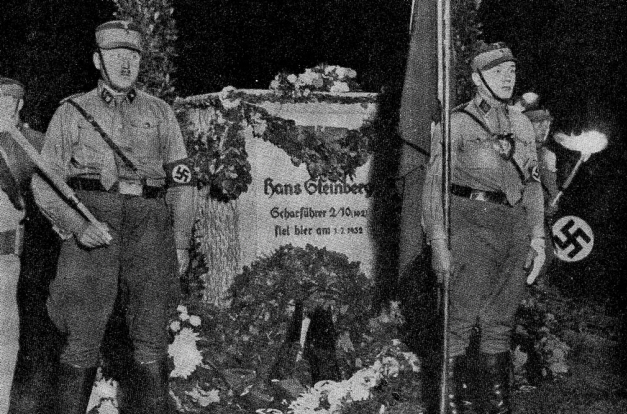
His comrades later erected a memorial stone in his memory on the square that bore his honorary name in the Third Reich. At its unveiling, the deputy Gauleiter Görlitzer dedicated the following words to the murdered man:
„Hans Steinberg went his way consciously and deliberately, as a loyal German fighter must go. We would not be worthy of the sacrifices of our four hundred dead, we would not be worthy of the new Germany, if we did not remember those who won it for us. This stone should stand here as long as the square bears the name Hans-Steinberg-Platz, as long as there is a Berlin, as long as there is a Germany! Let us remember the comrade who gave his life, his happiness, and let us be worthy of the great legacy. The fatherland above all: nothing can rob us of our love and faith in this country! May we die, our heirs will have the duty to preserve and shape it. Germany will not die!
Friedrich Karpinski
(* 25 May 1894, † 2 July 1932 in Essen)
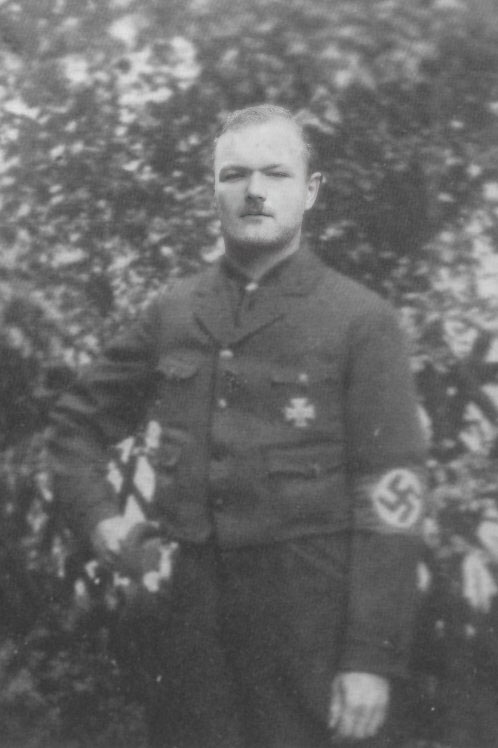
Friedrich Karpinski was a resistance fighter against the Weimar Republic and a Blood martyr of the National Socialist movement.
The SS man Friedrich Karpinski was a miner from Essen-Stoppenberg. In the field of the First World War he had received the Iron Cross I. Class for bravery in the face of the enemy.
On his return from a propaganda march in Essen on 2 July 1932, an SS squad to which Friedrich Karpinski belonged was fired upon from ambush by communists and pelted with stones. The small group of SS men had to retreat in the face of superior numbers, which Friedrich Karpinski covered until his comrades were safe. He himself, however, sinks down, hit in the heart by a bullet. The communist pursuers attacked him while he was still lying on the ground and tore his Iron Cross off his shirt. Then they continued to kick and beat Friedrich Karpinski. His comrades fought their way back and took him to hospital on a motorbike sidecar. Friedrich Karpinski dies on the way there. He left behind his wife and 14-year-old son.
Hans Handwerk
(* 8 January 1916, † 5 July 1932 in Frankfurt am Main)
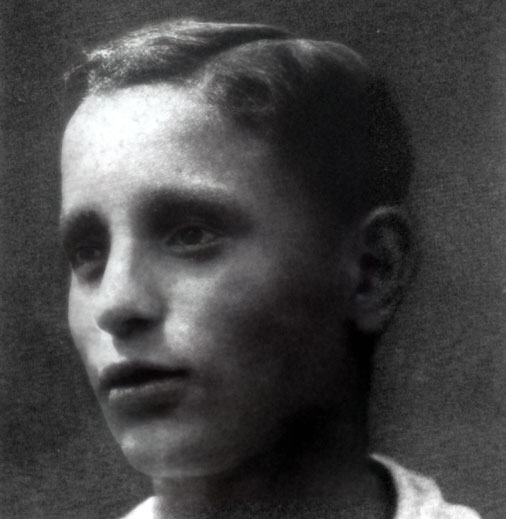
Hans Handwerk was a resistance fighter against the Weimar Republic and a Blood martyr of the National Socialist movement.
The Hitler Youth boy Hans Handwerk signed up for the drummer corps of the local Hitler Youth. In August 1931 he marched to HJ duty with the black and white flamed Landsknecht drum. In the process, the 15-year-old is beaten to the ground so severely by communists that he is not allowed to leave his bed for eight days. He then joins the SA together with his brothers Willy and Fritz.
After a propaganda march by the Frankfurt SA on 4 July 1932, there are organised attacks on returning SA men in various parts of the city. Hans Handwerk is walking home with his two brothers, as he often does. Suddenly the unarmed men are attacked and shot at by about 30 communists. The SA man Hans Handwerk is shot in the head from ambush and dies in hospital on 5 July 1932. The locksmith apprentice died at the age of 16.
In Frankfurt, Langestraße bore his honorary name during the Third Reich.
Walter Ufer
(* 19 November 1889, † 5 July 1932 in Dortmund - Eving)
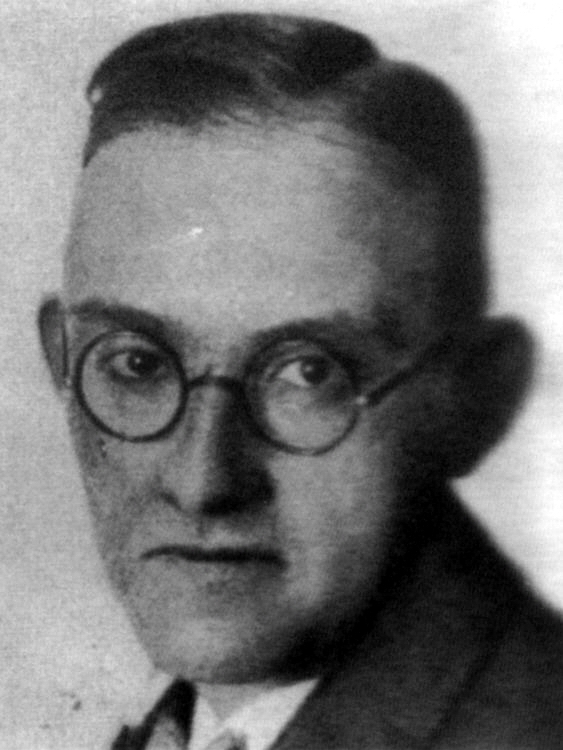
Walter Ufer was a resistance fighter against the Weimar Republic and a Blood martyr to the National Socialist movement.
The tenor singer of the Städtische Bühnen in Dortmund, who had originally studied economics and passed his exams as a business graduate, asserted himself as an artist with tenacious diligence and tireless work. As press officer of the Eving section of the NSDAP, he fought for Adolf Hitler’s movement. He had joined the party on 1 December 1931. On the evening of 24 June 1932, on his way to a meeting which had previously been cancelled for security reasons, he was attacked and beaten by forty communists. The murderers continued to beat the unconscious man lying on the ground, torturing him with knives, sticks and iron bars. On 5 July 1932, Walter Ufer died of his injuries.
A street in Dortmund was named after him.
Ludwig Decker
(* 28 November 1913, † 10 July 1932 in Beverungen)
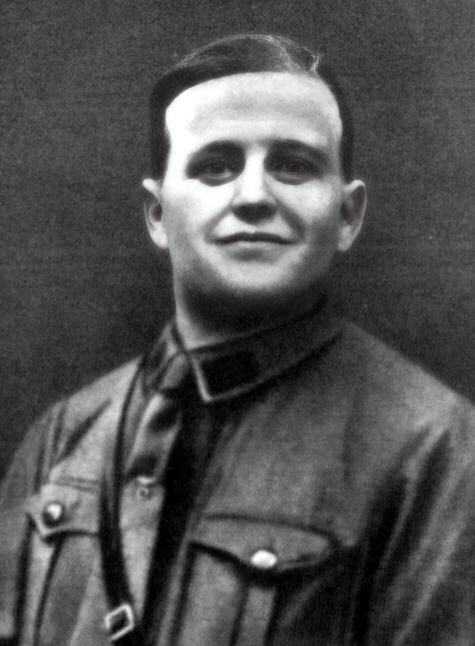
Ludwig Decker was a resistance fighter against the Weimar Republic and a Blood martyr to the National Socialist movement.
During a march in Beverungen, SA men were attacked by a group of communists outnumbering them four to one. Other SA comrades and the police rush to reinforce them and wedge the communists in. At the head of the requested reinforcements, Ludwig Decker of Sturm 10/136 runs to the aid of his comrades. The wedged-in communists want to escape the encirclement and open fire on the storm. Ludwig Decker is stabbed in the thigh during the fight. Unsuccessfully, his comrades try to stop the bleeding under a hail of stones and beaten by fence slats. Only when the police finally fire warning shots do the communist murderers flee.
The blacksmith’s apprentice Ludwig Decker bleeds to death at the age of eighteen on his way to hospital. The murderer, the communist Diederich, was „sentenced“ to five years in prison by the Weimar system justice.
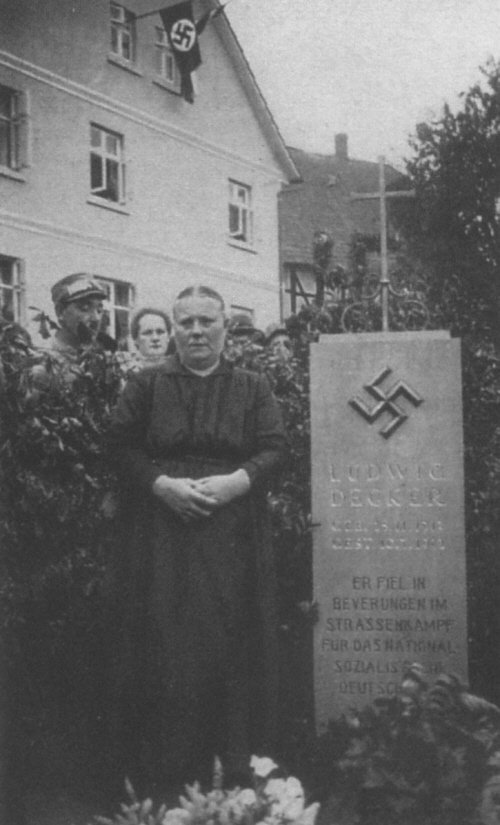
The mother at the grave of her murdered son
Georg Konjetzke
(* 20 October 1912, † 10 July 1932 in Ohlau in Silesia)

Georg Konjetzke was a resistance fighter against the Weimar Republic and a Blood martyr of the National Socialist movement.
On 10 July 1932, SA marches take place in all the larger towns in Silesia, which are very popular among the population because of their exemplary order. At the big sports festival in Brieg, many hundreds of SA men from Breslau are also present. At around 7 p.m. a lorry filled with about forty SS men from Breslau drives across the ring road in Ohlau.
Memorial stone at the murder site of Herbert Stanetzki and Georg Konjetzke
Suddenly several hundred Reichsbanner people rush out of the side streets, surround the car and try to drag the occupants off the car. The Reds beat the men with iron bars and fence rails, and within a few minutes thirteen of them were lying on the ground bleeding. Then the Reichsbanner people take flight. Around 9 p.m., three hundred quickly alerted SA men rush from Breslau to help escort the threatened comrades home. After the SA, led by Sturmbannführer Miller, leave the wagons to continue on foot, the leaders at the Schlosspark and Ohlebrücke are met by shots from the Reichsbanner, which come from bushes to the side. Numerous SA men collapse, seriously injured. The SA man Georg Konjetzke of Sturm 32/157 is beaten beyond recognition by lath blows and remains dead in the square. The farm worker dies at the age of 19. The communists throw his body into the Ohle. Among the murderers is the main ringleader, Councillor Manche. Rural police who are alerted are also fired upon. The Reichsbanner then flees. At around 10 p.m. the Sturmbann 1/11 marches off, but it too is suddenly met by rapid fire. Herbert Stanetzki, an SA man from Breslau, is shot in the head and dies instantly. The SA goes on the attack, the Reichsbanner is chased away. Since the police were no longer in control of the situation, Ohlau’s Reichswehr had to be called in. Only then does calm return. Herbert Stanetzki also died on the same day. Two dead, but also more than twenty seriously injured remain. The incident went down in history as Ohlau Bloody Sunday.
The Weimar Republic sentenced three defendants to minor penal servitude, some to prison and a few acquitted.
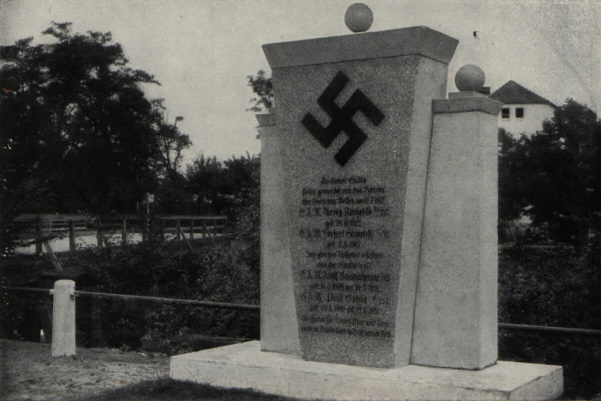
Memorial stone at the murder site of Herbert Stanetzki and Georg Konjetzke
Herbert Stanetzki
(* 8 August 1907, † 10 July 1932 in Ohlau, Silesia)
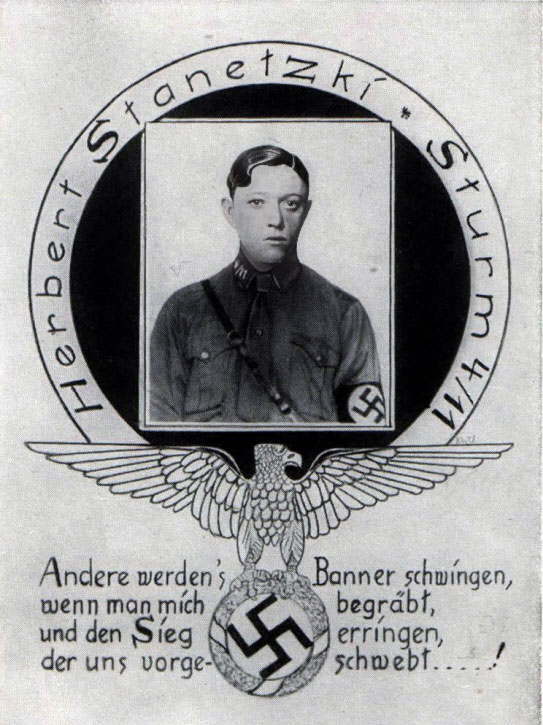
Herbert Stanetzki was a resistance fighter against the Weimar Republic and a Blood martyr to the National Socialist movement.
On 10 July 1932, SA marches take place in all the larger towns in Silesia, which are very popular among the population because of their exemplary order. At the big sports festival in Brieg, many hundreds of SA men from Breslau are also present. At around 7 p.m. a lorry filled with about forty SS men from Breslau drives across the ring road in Ohlau.
Suddenly several hundred Reichsbanner people rush out of the side streets, surround the car and try to drag the occupants off the car. The Reds beat the SS with iron bars and fence rails, and within a few minutes thirteen of them lay bleeding on the ground. Then the Reichsbanner people take flight. Around 9 p.m., three hundred quickly alerted SA men rush from Breslau to help escort the threatened comrades home. After the SA, led by Sturmbannführer Miller, leave the wagons to continue on foot, the leaders at the Schlosspark and Ohlebrücke are met by shots from the Reichsbanner, which come from bushes to the side. Numerous SA men collapse, seriously injured. At around 10 p.m. the Sturmbann 1/11 marches off, but it too is suddenly met by rapid fire. Herbert Stanetzki, an SA man from Breslau, is shot in the head and dies instantly. The farm labourer from Breslau dies at the age of 24. The SA goes on the attack, the Reichsbanner is chased away. Since the police were no longer in control of the situation, Ohlau’s Reichswehr had to be deployed. Only then does calm return. On the same day, the SA man Georg Konjetzke died. Two people were killed, but more than twenty were seriously injured. The incident went down in history as Ohlau Bloody Sunday.
The Weimar Republic sentenced three defendants to minor penal servitude, some to prison and a few acquitted.
In Breslau, a street was given the honorary name „Herbert Stanetzki“ during the Third Reich.
Heinrich Grasmeher
(* 22 March 1909, † 11 July 1932 in Steeden a. d. Lahn)

Heinrich Grasmeher was a resistance fighter against the Weimar Republic and a Blood martyr of the National Socialist movement.
In January 1932, Heinrich Grasmeher joins the NSDAP and the SA.
On 11 July, the SA man Heinrich Grasmeher was stabbed in Steeden an der Lahn in the Denner inn by a Reich bannerman and members of the Iron Front. He had stood in front of his leader during an exchange of words. The locksmith dies from the stab wounds.
His last words were:
“With joy I fought for the movement and now I gladly die for Adolf Hitler.“
The murderer is sentenced by the Weimar system justice to 2.5 years in prison and released after only six months.
Storm 25 bore the name Heinrich Grasmeher in the Third Reich. A marble memorial plaque at the murder site kept his memory alive.
Kurt [Curth] Kreth
(* 22 December 1899, † 12 July 1932 in Köslin)
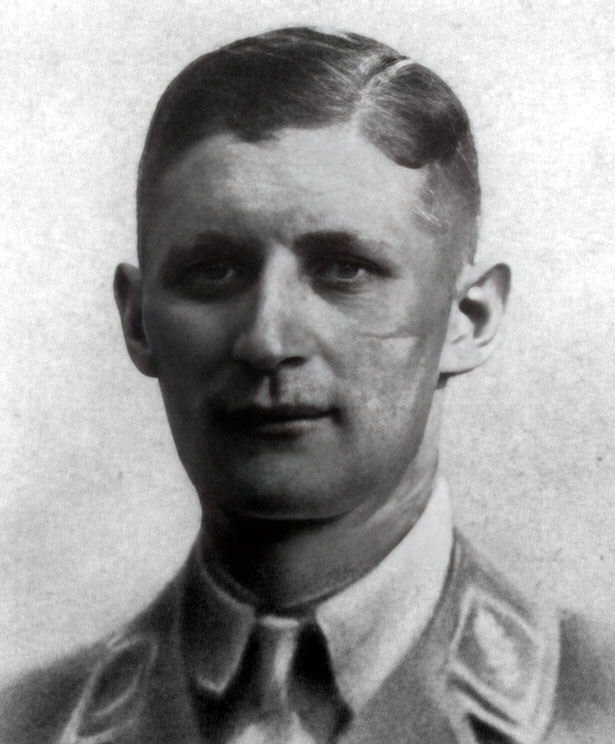
Kurt [Curth] Kreth was a resistance fighter against the Weimar Republic and a Blood martyr of the National Socialist movement.
In the first days of July 1932, the SA Standartenführer Kurth Kreth, a landowner from Neuhof, district of Bublitz in Pomerania, came from Zanow on his motorbike. On the back seat was his Standartenadjutant Dr Günther Roß from Berlin, who was active in the NS Teachers’ Association. Close to Köslin, they ran into a horde of Köslin communists armed with clubs and heavy cobblestones, who formed a lane as the motorbike passed, beating them. Roß fell and, lying on the ground, was further abused by the Reds. Despite his serious injuries, Standartenführer Kreth turned back to stand by his comrade and succeeded in getting his friend to hospital. After 12 days, on 12 July 1932, both succumbed to their injuries.
In Swinemünde, Bublitz, Danzig and Stettin, streets bore the honorary name „Kurt Kreth“ or „Curt Kreth“ during the Third Reich.
Günther Roß
(* 28 July 1900, † 12 July 1932 in Köslin)
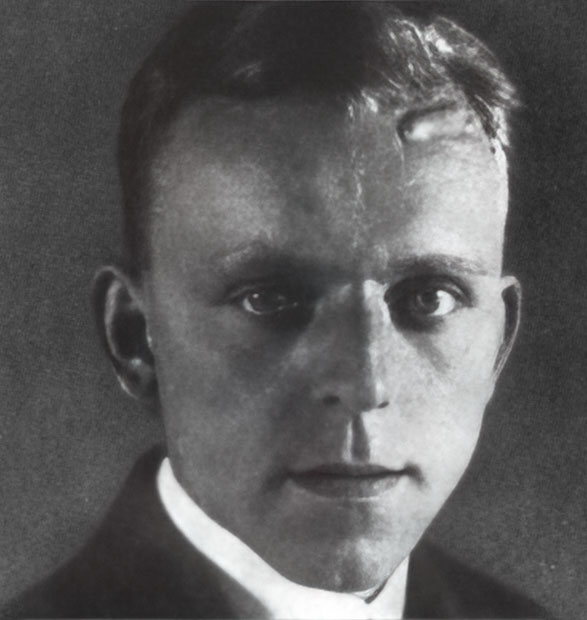
Günther Roß was a resistance fighter against the Weimar Republic and a Blood martyr of the National Socialist movement.
In the first days of July 1932, the SA Standartenführer Kurt Kreth, a landowner from Neuhof, district of Bublitz in Pomerania, came from Zanow on his motorbike. On the back seat was his Standartenadjutant Dr Günther Roß from Berlin, who was active in the NS Teachers’ Association. Close to Köslin they ran into a horde of Köslin communists armed with clubs and heavy cobblestones, who formed an alley as the motorbike passed and beat them both. Roß fell and, lying on the ground, was further maltreated by the Reds. Despite his serious injuries, Standartenführer Kreth turned back to stand by his comrade and succeeded in getting his friend to hospital. After 12 days, on 12 July 1932, both succumbed to their injuries.
In Berlin and Bublitz, streets bore his honorary name.
Friedrich Schröder
(* 4 November 1908, † 17 July 1932 in Berlin)

Friedrich Schröder was a resistance fighter against the Weimar Republic and a Blood martyr of the National Socialist movement.
He was an insurance officer from Kreuzberg’s Sturm 124/8. On Saturday, the night of 17 July 1932, he was on duty at the Sturmlokal in Lindenstraße. There was always a heightened state of alert in the immediate vicinity of the communist traffic pub „Prochnow“. Everyone waited, passing the time by playing skat, music and the like, yet always in high tension. Midnight has passed, suddenly a call from outside: „Communists are coming!“ The skat cards fly aside, thirty men rush into the street, just around the corner into Hollmannstraße, corner of Alte Jakobstraße - suddenly shots, it’s for cover „We work our way forward - dark figures disappear - and there we see him lying, our comrade Friedrich Schröder, a bullet hit him in the heart.“ He died in the Urban hospital. The SA man from Sturm 124/III/8, Friedrich Schröder, one of the best, became a victim of the Bruderkampf. He knew only his work and his Sturm. When the work was over, he reported for duty. His funeral was on 23 July 1932 in the forest cemetery in Eberswalde (between Tramper Chausee and Freienwalder Straße). His storm carried his name in the Third Reich and a memorial plaque was inaugurated and affixed to the house at Alte Jakobstraße 1a in Berlin on 9 November 1934:
Murdered by Marxists on this spot
17 July 1932
the SA man Friedrich Schröder,
born 4. 11. 1908.
Do not let the hero in your soul die.
The northern part of the Elisabethufer in Berlin was renamed Schröderdamm in his honour.
Ullrich Massow
(* 4 August 1912, † 17 July 1932 in Greifswald)
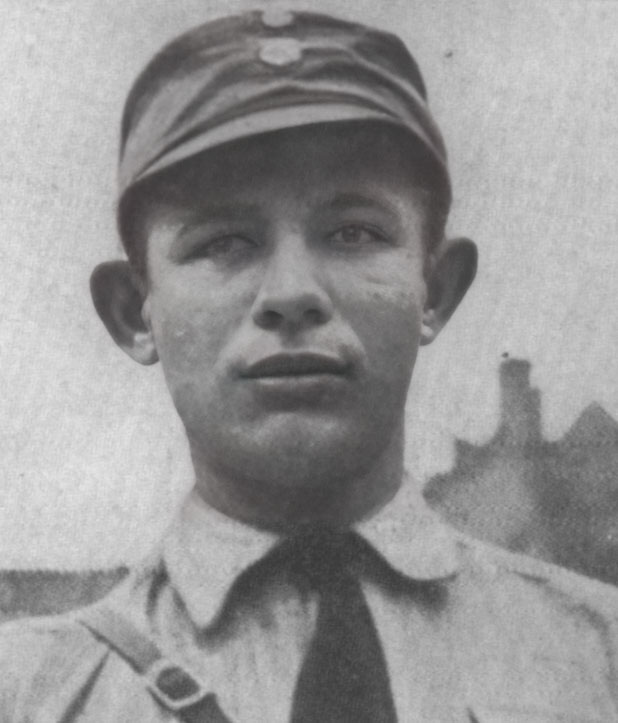
Ullrich [Ulrich] Massow was a resistance fighter against the Weimar Republic and a Blood martyr of the National Socialist movement.
In Greifswald, following a National Socialist rally, SA men are shot at by Communists. Twenty-five of them are wounded by gunfire. The blacksmith Ullrich Massow is beaten to death, seriously injured. The SA man succumbs to his severe injuries while being transported to hospital. The event became known as Greifswald Bloody Sunday.
In Stettin, a street bore his name.
Bruno Reinhard
(* 22 January 1908, † 17 July 1932 in Greifswald)
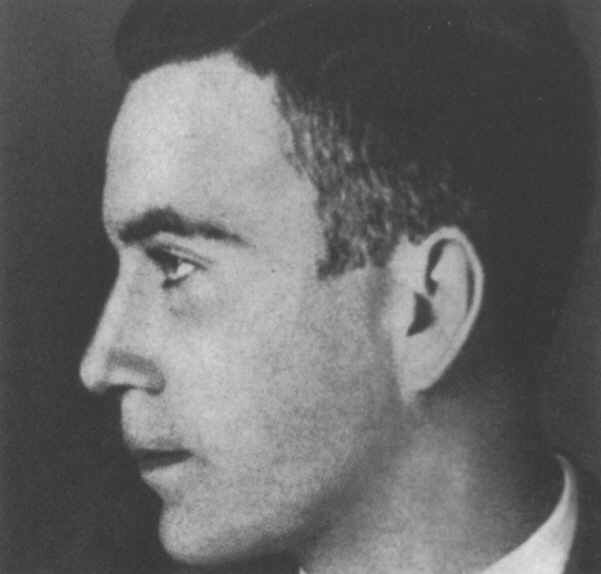
Bruno Reinhard was a resistance fighter against the Weimar Republic and a Blood martyr to the National Socialist movement.
In the university town of Greifswald, the SA man and student Bruno Reinhard from Dresden fought for Adolf Hitler’s movement. He was born in Tsingtau and lost his father at an early age. His high idealism often led him, regardless of the dangers, to visit communists with whom he had had disputes in their homes in order to convince them of National Socialism, which he often succeeded in doing. In spring 1931 he joined the NSDAP and the SA. He was a member of the NS Student League. With noble means he beat the enemy, who hated him all the more. On 17 July 1932, Bruno Reinhard was shot by communist murderers. The event became known as Greifswald Bloody Sunday.
His mother suffered deep sorrow, and fate inflicted even greater suffering on her: one week after Bruno Reinhard’s funeral, his brother, a first lieutenant at sea, also died at sea on the training ship „Niobe“.
Three quarters of a year after his death, Bruno Reinhard’s life companion gave birth to his daughter.
In Greifswald, a street was given his name.
Herbert Schumacher
(* 10 October 1913, † 17 July 1932 in Greifswald)
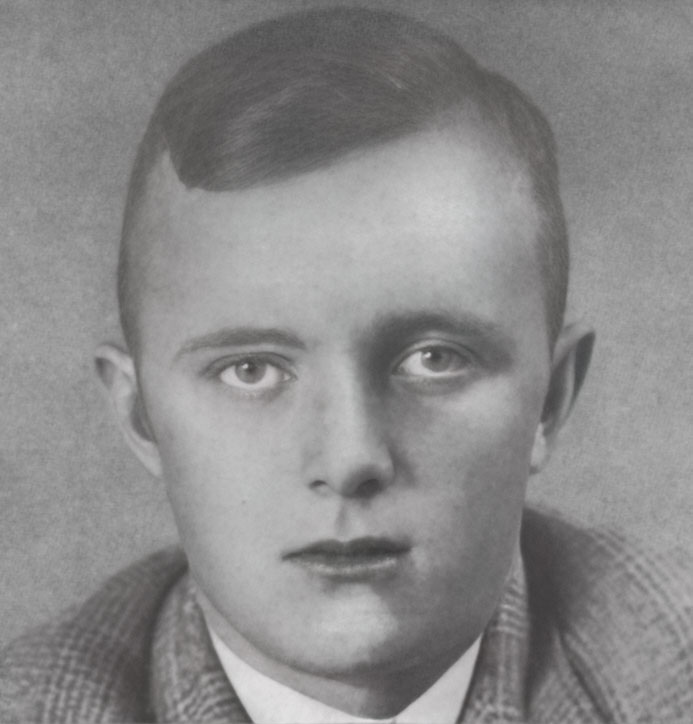
Herbert Schumacher was a resistance fighter against the Weimar Republic and a Blood martyr to the National Socialist movement.
In March 1931, the businessman Herbert Schumacher joins the NSDAP.
In Greifswald, following a National Socialist rally, SA men are shot at by Communists. Twenty-five of them are wounded by gunfire. Herbert Schumacher, already severely wounded by gunfire, was literally trampled by his killers and beaten up with forks and clubs so badly that he died in hospital. The event became known as Greifswald Bloody Sunday.
Helene Winkler
(† 17 July 1932 in Hamburg-Altona)

Helene Winkler was a resistance fighter against the Weimar Republic and a Blood martyr of the National Socialist movement.
Party comrade Helene Winkler, a member of the NS-Frauenschaft, became a victim of the so-called Bloody Sunday in Altona. On her way home from the final rally she was fatally shot by a bullet. It was never clarified whether it was a communist or a police bullet.
Heinrich Koch
(* 14 November 1903, † 17 July 1932 in Hamburg-Altona)
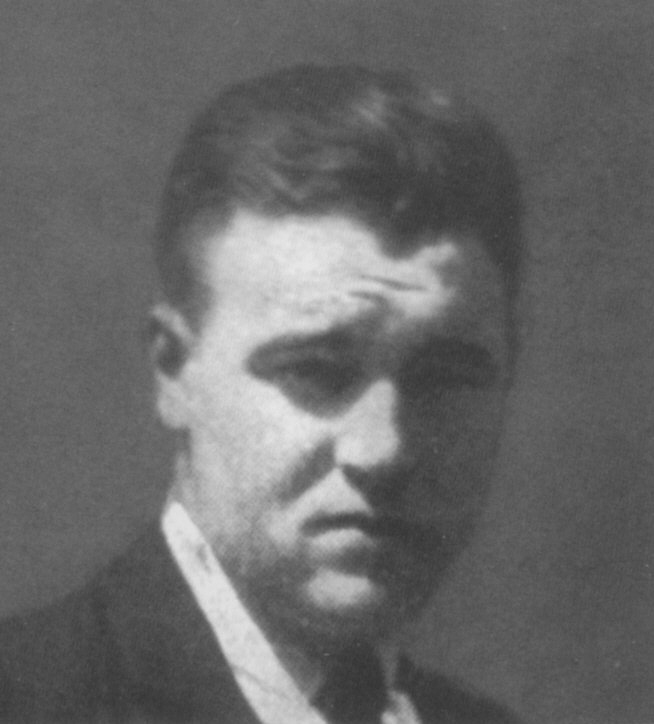
Heinrich Koch was a resistance fighter against the Weimar Republic and a Blood martyr to the National Socialist movement.
The waiter Heinrich Koch joined the SA in April 1931.
The SA Scharführer, who belonged to the Elbstrand column, became a victim on the so-called Bloody Sunday in Altona. He was shot in the heart and then in the head and dies. Only a week earlier he had been seriously injured in the face by a communist with a broken bottle. He left behind two underage children.
In Hamburg, an Alster steamer bore his name.
Rathenaupark in Hamburg was renamed Koch-Büddig Park after 1933.
Peter Büddig
(* 25 June 1908, † 18 July 1932 in Hamburg-Altona)
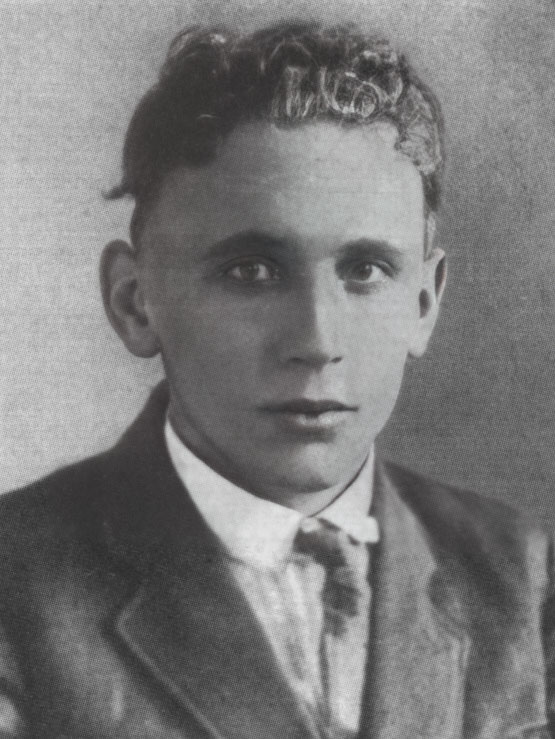
Peter Büddig was a resistance fighter against the Weimar Republic and a Blood martyr to the National Socialist movement.
The SA man and ship’s steward Peter Büddig became a victim of the so-called Bloody Sunday in Altona and was shot in the back, from which wound he died the next day. He left behind a widow.
Rathenaupark in Hamburg was renamed Koch-Büddig Park after 1933.
Herbert Härtel
(* 10 August 1910, † 18 July 1932 in Groß-Rosen, Silesia)
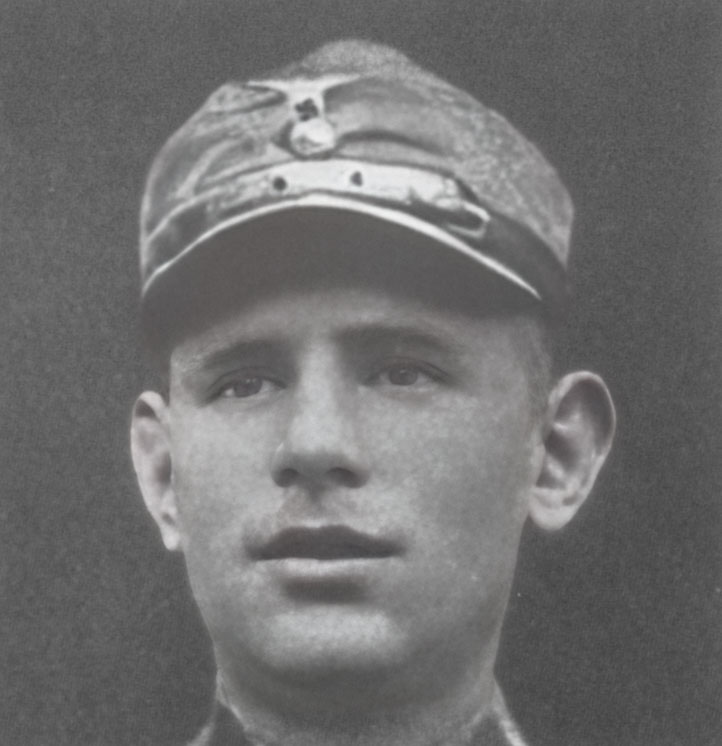
Herbert Härtel was a resistance fighter against the Weimar Republic and a Blood martyr to the National Socialist movement.
On 18 July, there is a serious clash in Groß-Rosen. When the propaganda squadron of Standarte 10 ends a rally in this town with a chant, they are attacked by about 100 communists and Reichsbanner people. The Landjäger, who was present, initially tried to hold back the Marxists, but was himself severely harassed and even put his side-rifle back in his pocket at the communist’s request. Nor does he resort to firearms when the unarmed SA men are attacked with bludgeoning tools, hatchets and knives. With great courage, the National Socialists then beat the Communists into flight, who in turn grab their pistols and open fire. In the process, SA Scharführer Herbert Härtel collapses after being shot in the heart. The carpenter dies at the age of 21.
In Striegau, a street was named after him during the Third Reich.
Herbert Egon Zimmermann
(*1903 - † 24.7.1932)
District Cologne-Aachen
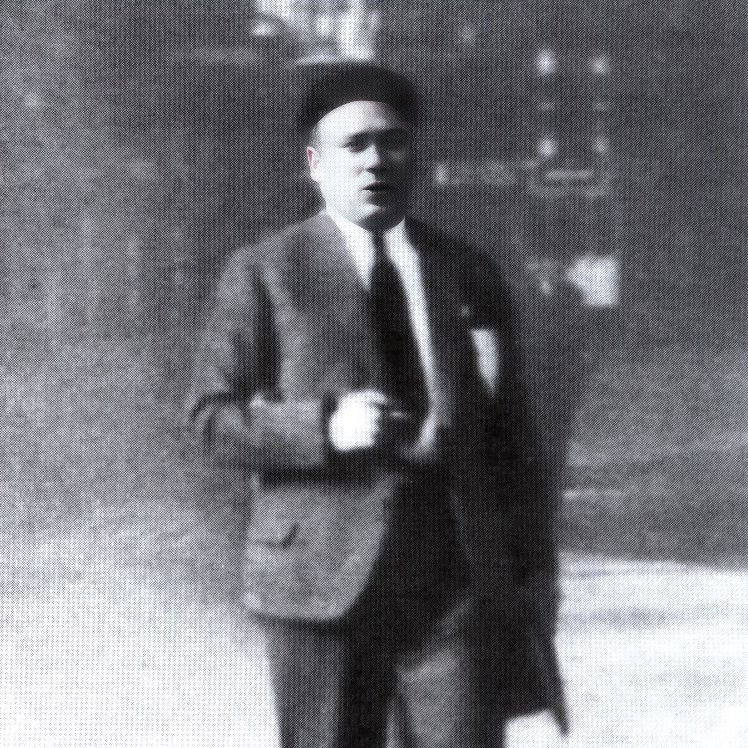
„At the grave of our fallen comrade Zimmermann, we want to come together and search our consciences. Here we want to renew the oath we took when we promised to work wholeheartedly for the Fuehrer and his idea“, according to a report on the 1935 district convention of the Jülich district of the NSDAP.
Herbert Zimmermann died at the age of 28. He was allegedly an SS man in Sturm 4, Sturmbann IV, Cologne, SS-Standarte 5, Trier. He came from Plauen in the Vogtland.
On Sunday, 24 July 1932, Zimmermann was part of a unit that was pasting election posters in Jülich in the Lower Rhine region. When the small group reached the eastern corner of the bastion wall in Hubertusstrasse at around 6 a.m., the fatal shots were fired. Hit in the head by a bullet, Herbert Zimmermann collapsed and died instantly. The shooters were members of the largest successor organisation of the illegal Red Front Fighters’ League, the Combat League against Fascism.
The SS man was one of the fallen members of the NSDAP who received extensive honours in their homeland.
Thus, today’s Probst-Bechte-Platz in Jülich was named after him and a memorial plaque was placed at the scene of the crime. Nevertheless, the name only appears in local chronicles.
Zimmermann does not keep supra-regional lists. One exception is the „Mitgliedsbuch für Fördernde Mitglieder der SS“ (membership book for supporting members of the SS). Zimmermann’s name is also found among the Blood martyres of the Schutzstaffel mentioned here. Whether this is actually due to the fact that Zimmermann, as is claimed in a book from 2004 with reference to „an eyewitness“, spied for the KPD in the Schutzstaffel as an undercover man, must be doubted, since the reference cannot be further verified or assigned in any way.
The police report quoted by the „Aachener Anzeiger/Politisches Tageblatt“ in its issue of 28 July 1932 clearly attributes Zimmermann to the NSDAP environment. Furthermore, it is questionable why the party or the Schutzstaffel assigned the victim to an SS unit and did not leave it at a simple party comrade, if it was merely a matter of creating another political martyr. „The political clashes in Jülich.
The police report: In the morning hours of 24 July 1932, as already reported, there was a clash between communists and National Socialists in Jülich, in which a supporter of the National Socialists, the 29-year-old clerk Herbert Zimmermann, was killed by a bullet to the head. The reason for this clash was the encounter of several communists with National Socialists who had smeared the road embankment with red paint. The communists tried to sand the road, but the National Socialists resisted. A shootout developed, resulting in the death of one of the participants. The investigation by officers of the political department of the Aachen police headquarters in conjunction with the Jülich police led to the arrest of two communists from Jülich who were convicted by witness statements of having taken part in the shooting at the National Socialists. The communist Pfeffer from Jülich admitted during his interrogation to having fired a number of shots. He had stored the pistol in a safe hiding place in his flat after the crime, where it was also found. Pfeffer claims that shots were also fired from the National Socialist side. This allegation is still being investigated. Yesterday, three of those involved in the shooting were provisionally brought before the examining magistrate in Aachen. The man shot, who was wanted by the public prosecutor’s office and the police in Hamburg, did not belong to the NSDAP, according to the party leadership, but had been active for the party for some time.“
The background of the Hamburg investigations against Zimmermann were „property offences“ for which he already had several relevant criminal records.
Robert Bitzer
(* 3 January 1902, † 27 July 1932 in Wiehl)
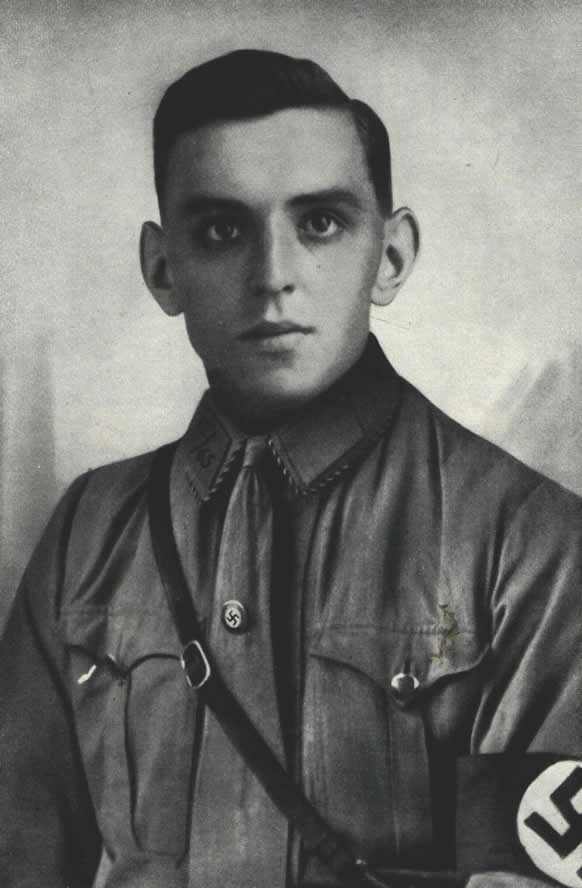
Robert Bitzer was a resistance fighter against the Weimar Republic and a Blood martyr of the National Socialist movement.
Election campaign July 1932. The Iron Front seeks to outdo the Red Front in agitation. Both are united in their struggle against the National Socialists. In the night of 26-27 July 1932 there is a clash between members of the Iron Front and SA men in Oberwiehl, district of Cologne. The group wanted to check previously pasted election posters again. Experience shows that many were torn down. These were to be replaced as quickly as possible. In the process, they come into contact with a group of political opponents. The SA man Ernst Johst is seriously injured by knife wounds, while the SA man and hammer smith Robert Bitzer is killed by a kidney puncture.
In the Third Reich, a path to the Adolf Hitler Field in Cologne bore his name.
Johann Raskin
(* 4 April 1906, † 28 July 1932 in Eilendorf (Rhineland))
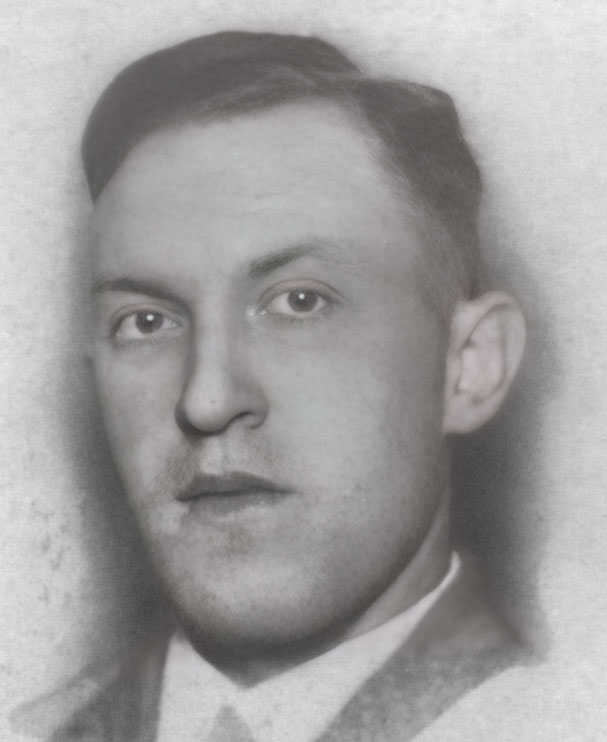
Johann Raskin was a resistance fighter against the Weimar Republic and a Blood martyr to the National Socialist movement.
On 28 July 1932, the SA man and Scharführer Johann Raskin was the victim of an attack by two communists in Josefstraße in Eilendorf near Aachen. Struck in the abdomen and lungs by bullets and hit on the back of the head by a lead-filled rubber truncheon, he falls to the ground and dies. The mechanic left behind a wife and child.
There was a Johann-Raskin-Straße in Eilendorf in the Third Reich.
Erich Sallie
(* 5 April 1913 in Praust, † 29 July 1932 in Wiederitzsch)
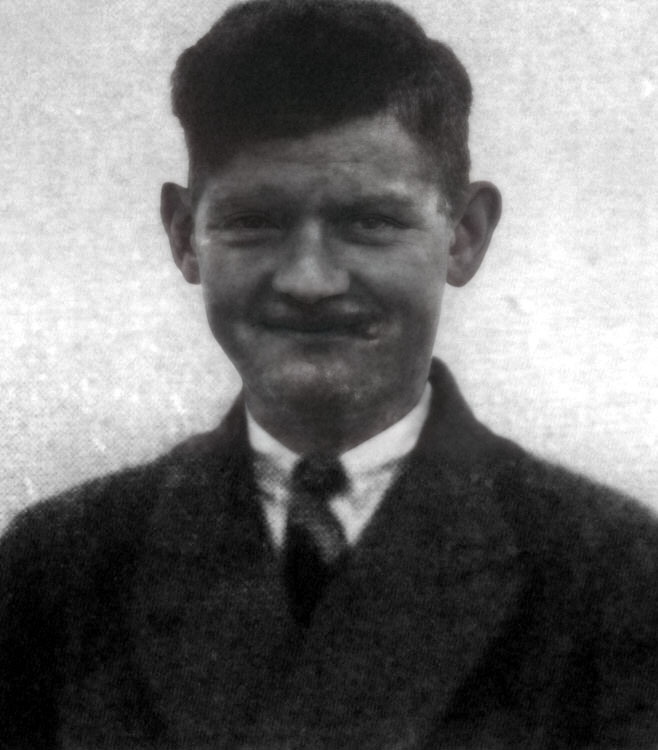
Erich Sallie was a resistance fighter against the Weimar Republic and a Blood martyr to the National Socialist movement.
„Fulfilment of duty, comradeship and loyalty, that was the life of the young SA man and farmer’s son Erich Sallie of SA storm 12/107 at Seehausen near Leipzig,“ begins the account of one of his comrades about the life and death of Erich Sallie. And he continues:
„He was a tall, blond German boy, the archetype of flourishing life. His blond hair shone with his eyes.“
The report goes on to describe how Erich Sallie, the son of a German farmer from West Prussia who opted for Germany and was expelled from his homeland after the Polish occupation after the First World War and had to leave his homeland, grew up among numerous siblings, how he put himself at the service of Adolf Hitler’s movement and the SA, and how he led comrades home after an election meeting on the night of 29 July 1932.
„pitch-dark night! The Stentzlerstraße, where the communist pub was located, was being passed when suddenly headlights flashed from the adjacent potato field and about a hundred heavily armed communists attacked the few SA men from the pub. They were armed with beer bottles, stones, slats, clubs and knives. A wild brawl broke out. The few SA men defended themselves like berserkers against a superior force of ten. Erich Sallie was pushed away and murdered in a bestial manner. A stab from behind with a long knife through the spine and neck caused the death of his comrade in a few seconds by bleeding to death. Any medical help would have come too late. The communist criminals were not satisfied with the bestial, fatal stab alone, but continued to crush and stab the lifeless body.
Erich Sallie dies at the age of nineteen.
On 8 November 1938, a solemn procession took place in Leipzig, during which the coffins of the seven Leipzig Blood martyrs Walter Blümel, Alfred Kindler, Erich Kunze, Heinrich Limbach, Alfred Manietta, Erich Sallie and Rudolf Schröter were first brought from the North Cemetery to the Markt, where the dead were called „to the last roll call“. Instead of them, the formation of honour responded with „Here!“ when each name was called. The coffins were then transferred to the grove of honour specially created for them at Leipzig’s South Cemetery.
In Wiederitzsch, a street bore his honorary name.
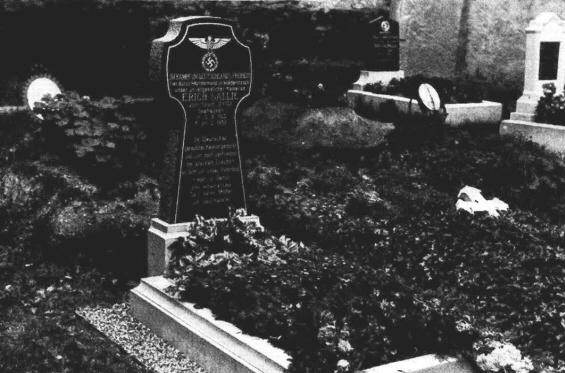
The grave of Erich Sallie
Otto Reinke
(* 8 June 1913, † 30 July 1932 in Königsberg (Prussia))
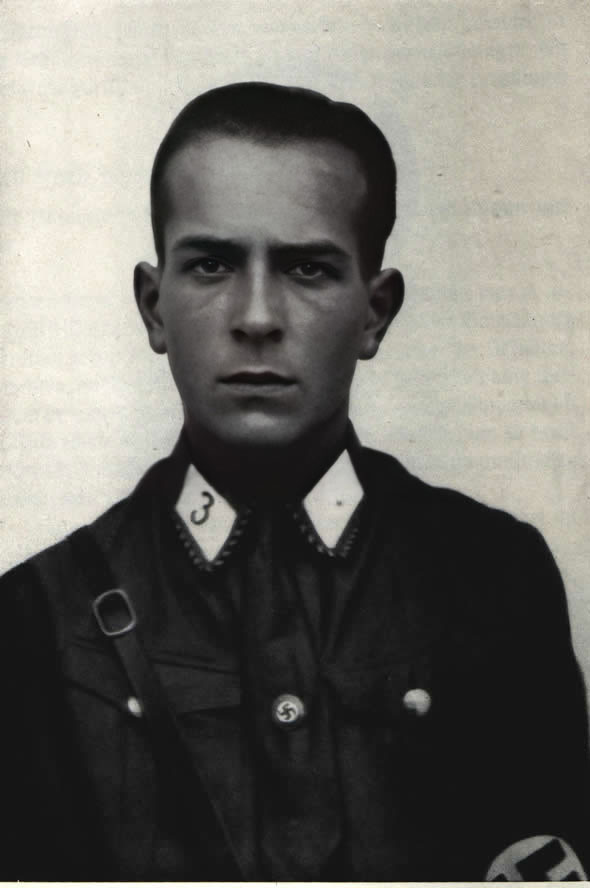
Otto Reinke was a resistance fighter against the Weimar Republic and a Blood martyr to the National Socialist movement.
An excellent comrade was the SA man Otto Reinke in Königsberg in Prussia. In 1931 he joined the NSDAP and the SA. He was in the forefront of the fight for the National Socialist world view and was repeatedly attacked and seriously injured by communists. In July 1932, after being wounded, he is ordered to stand guard of honour for Adolf Hitler, who greets him with a handshake while he is in Königsberg. Reinke pays no heed to his wounds and on 30 July 1932 throws himself back into the commune. Propaganda material is to be distributed on this day. The 12 men are attacked by a group of communists about 70-80 strong. The Scharführer Otto Reinke was stabbed in the neck, his artery was cut and he bled to death. The murderer later met his fate and was shot in the spring of 1933.
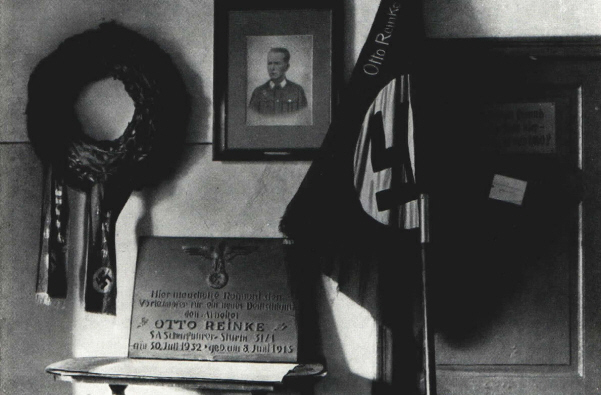
Memorial for Otto Reinke

Gravesite of Otto Reinke
Willi Meinen
(*31.7.1906 - † 31.7.1932)
District Mecklenburg-Lübeck
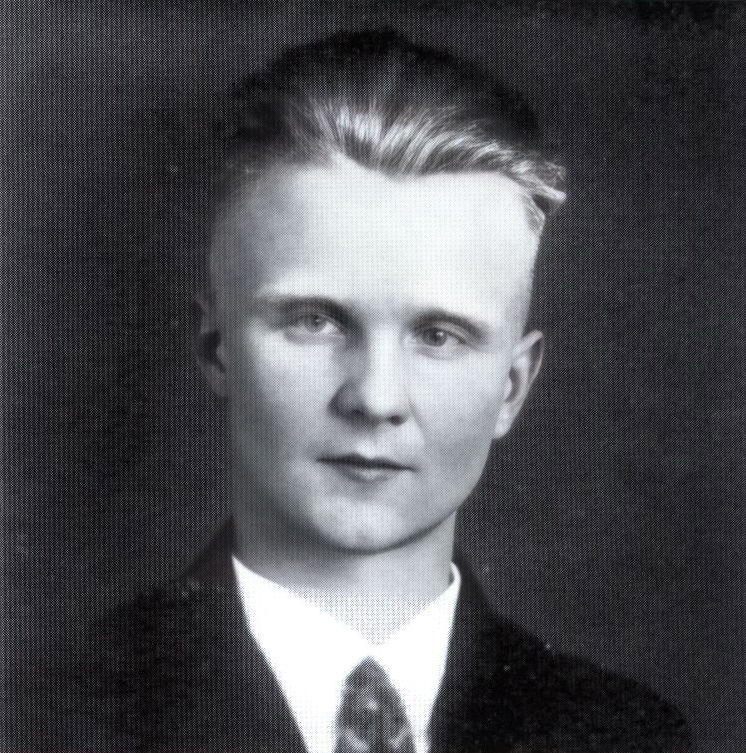
That night, the clerk Willi Meinen, the only child of his parents, had gone to the Feller inn in Lübeck’s Hundestraße. He worked for his parents in a shop in Kleine Burgstraße.
It was the night from Saturday to Sunday; his birthday. Shortly after midnight he had ordered a glass of beer at the bar. Willi Meinen wore an NSDAP badge on his lapel. But he was not a member of the party. He was talking politics with an acquaintance. Two young SPD people had overheard the conversation. Both were
Minutes before, he had come into the shop shouting „Freedom“ and raising his fist. At that time, the members of the Social Democratic Reichsbanner greeted each other with the word „Freiheit“. A heated discussion ensued between the two and Willi Meinen at the beer counter. Finally they tore off the 26-year-old’s NSDAP sign.
As the situation became threatening, various guests left the pub, and Meinen also followed them to go home. The two Reichsbanner people rushed after Meinen and shouted to him at the corner of Tünkenhagen that he should get out of the way or he would get a beating. Meinen hurried up Hundestraße, pursued by the two opponents. They shouted loudly for the National Socialist to be stopped. As he fled, Meinen had to stop at the Lendersche Wirtschaft in Hundestraße.
happen. In the Lendersche Wirtschaft, the traffic pub of the workers’ sports club, there was a guard of thirty men. There were always two guards in front of the door. When these guards heard the shouts of the pursuing two people to arrest the „National Socialist“, they jumped forward and tripped the fleeing Meinen.
This is how the pursuers, and perhaps others, reached their victim, whom they horribly mauled with blows and knife wounds. The carotid arteries were torn open and also the chest in the area of the heart. Although the police arrived immediately, it was too late to help.
Willi Meinen bled to death on his twenty-sixth birthday.
Immediately after the crime, the two Reichsbanner and SPD members, Karl Kaehding, a warehouse worker, and Johannes Fick, a riveter, were arrested by the police as possible perpetrators. The unmarried Kaehding was completely blameless, Johannes Fick, on the other hand, had a long list of sins: theft, bodily harm, resistance to state authority, freeing prisoners. But both had to be set free again after a short time.
After the National Socialists came to power, the case was reopened and the false alibis of the perpetrators could be refuted. In the course of the trial, both perpetrators finally confessed to the murder. On 17 September 1933, the defendants were sentenced to death for treacherous murder by the Lübeck Regional Court.
In the reasons for the judgement it says among other things:
„According to the testimonies of all witnesses, one cannot speak of self-defence. We attached particular importance to establishing in the preliminary investigation whether a weapon had been found on Meinen. Nothing of the kind! The whole other appearance of the deceased on that evening also gives eloquent evidence that Meinen was not willing to act aggressively against the two Reichsbanner people, who were far superior to him in physical strength. They killed a political opponent who had done them no harm, deliberately and with deliberation!“
After the war, rumours about the involvement of Herbert Frahm, better known by his stage name Willy Brandt and former Chancellor of the Federal Republic of Germany, arose again and again. Frahm, at that time a member of the communist-friendly Socialist Workers’ Party (SAP), preferred the Lendersche Gastwirtschaft in Hundestraße as a place of business. It may be assumed that he at least witnessed the murder.
Peter Kölln
(* 3 June 1910, † 31 July 1932 in Itzehoe)
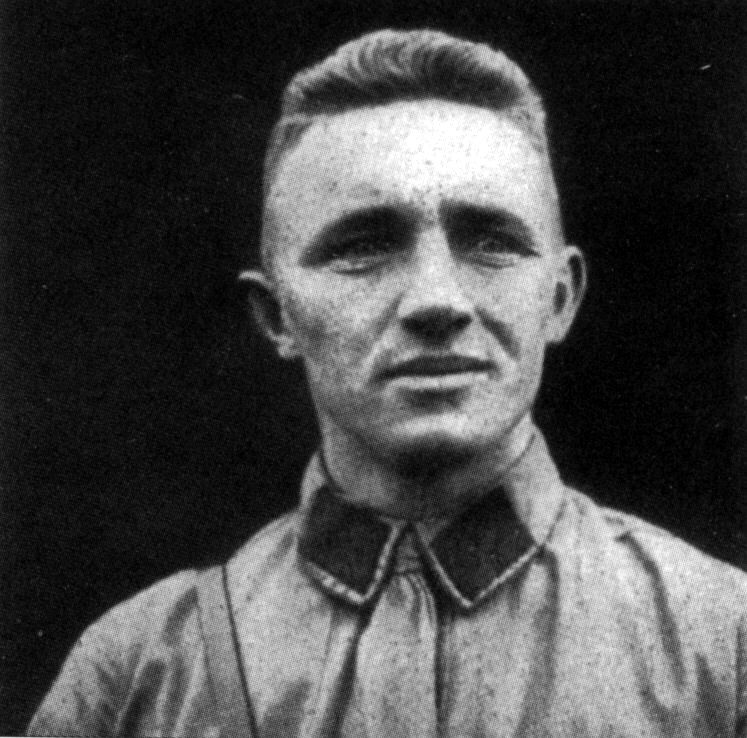
Peter Kölln was a resistance fighter against the Weimar Republic and a Blood martyr to the National Socialist movement.
Peter Kölln was a member of the NSDAP and the SA. Before the 1932 Reichstag elections, marauding communists in Itzehoe constantly tried to tear down NSDAP flags and election posters. A group of SA men therefore called the Weimar system police. However, they preferred not to show up at all. On the night of 31 July 1932, Peter Kölln went home with his brother and a friend. While doing so, they were attacked by communists, during which the gardener Peter Kölln was shot dead.
All the hatred of the red murderers was in vain, however. In the Reichstag election, the NSDAP received 42.9% of the votes in Itzehoe and thus became the strongest force.
A simple memorial stone was erected at the murder site during the Third Reich. A gas pipe specially routed there fed the eternal fire that was located in front of the stone.
The current Feldstraße in Itzehoe was named Peter-Kölln-Straße in his honour.
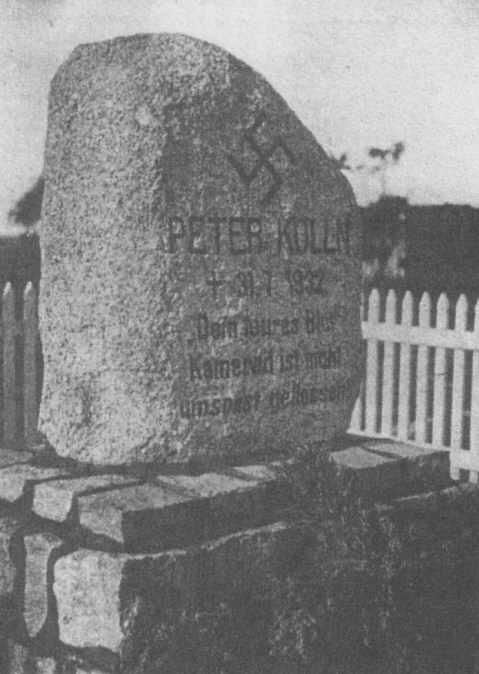
The memorial stone for Peter Kölln in front of which the eternal flame was located:
Your precious blood
Comrade is not
flowed in vain
Fritz [Friedrich] Schrön [Schroen]
(* 21 June 1914, † 31 July 1932 in Essen)
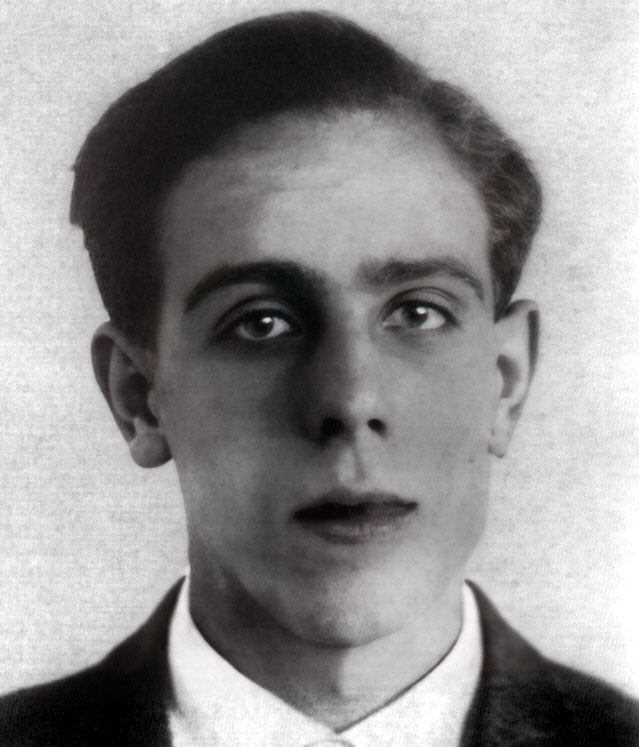
Fritz [Friedrich] Schrön [Schroen] was a resistance fighter against the Weimar Republic and a Blood martyr of the National Socialist movement.
Even at school he gave lectures on National Socialism. Only sixteen years old, he led a squad of forty Hitler Youth in an exemplary manner.
In the night of 31 July 1932 there were serious political clashes in Essen. An NSDAP sticker column wanted to renew the posters damaged or destroyed by the communists before the polling stations opened. During a communist attack, a National Socialist is shot in the arm. A police officer is drawn into the confrontation, a second one rushes to his aid and is shot at by communists, whereupon the latter pulls out his pistol and hits the eighteen-year-old SA man Friedrich Schroen in the head. The Weimar system policemen, firing wildly, search the men tending to their dying comrade for weapons. They were all unarmed. The murderer nevertheless remained on duty.
The Frohnhauser Markt bore the name Fritz Schrön during the Third Reich.
Axel Schaffeld
(* 23 November 1904, † 1 August 1932 in Braunschweig)
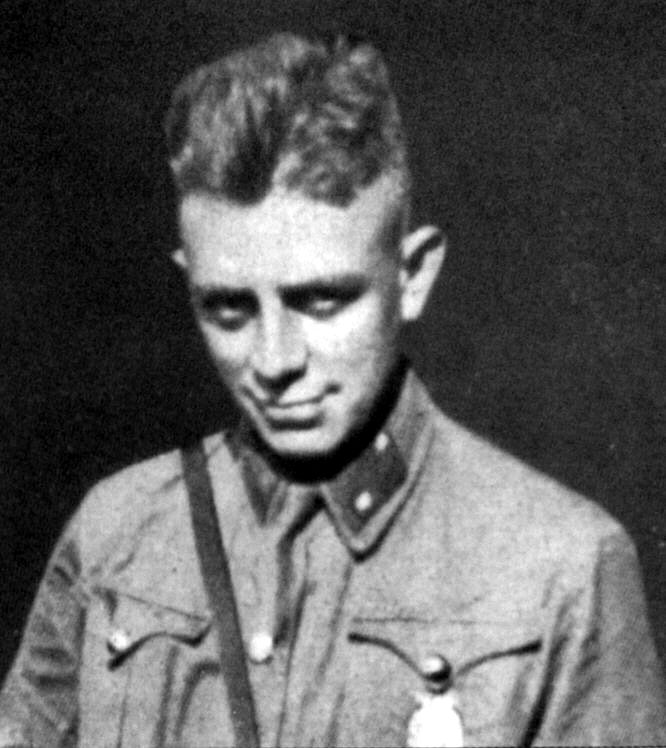
Axel Schaffeld was a resistance fighter against the Weimar Republic and a Blood martyr to the National Socialist movement.
Mechanical engineering student and SA storm leader Axel Schaffeld from Braunschweig was an enthusiastic fighter for the coming Third Reich. After the NSDAP’s great election victory in July 1932, he joyfully followed Adolf Hitler’s slogan: „The struggle continues!“ On 1 August 1932 he marched through the streets of Brunswick at the head of his SA storm. A communist bullet hit him from ambush and Sturmführer Axel Schaffeld died on the way to hospital.
The Braunschweig City Chronicle writes:
01 August 1933: Unveiling of the memorial plaques for Axel Schaffeld (on Schulweg, now Axel-Schaffeld-Straße) and Gerhard Landmann (on Eichtalstraße) who were murdered by communists.
The Braunschweigische Landeszeitung writes about the murder on 11 March 1933:
„The murder of Axel Schaffeld. Four Marxists in the Dock-The First Day of the Trial.“
And on 24. 6. 1933:
„High prison sentences in the Schaffeld trial. Klages sentenced to ten years, Leydecker and Hesse to twelve years each.“
The memorial plaque at the site of the murder bore the following text:
Axel Schaffeld fought and died for a new Germany
In Heidelberg, the comradeship house of the German National Socialist Student Union is named Axel Schaffeld House. In Braunschweig, a Jungbann ensign bears his name.
Johannes [Hans] Reifegerste
(* 9 April 1886, † 3 August 1932 in Frohburg (Saxony))
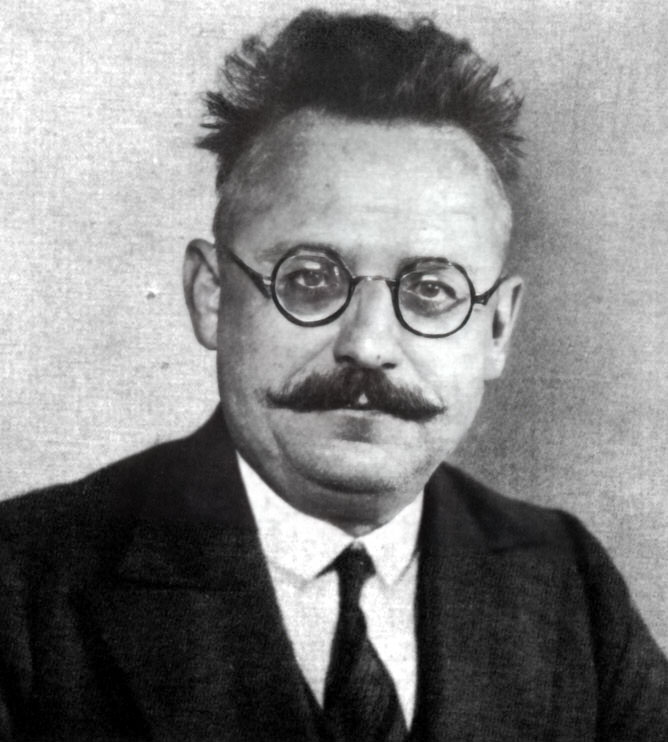
Johannes [Hans] Reifegerste was a resistance fighter against the Weimar Republic and a Blood martyr of the National Socialist movement.
It was the August elections of 1932. Every party comrade stood in his place. The propaganda leader of the NSDAP local group Frohburg and at the same time leader of the local group Escherfeld, Hans Reifegerste from Streitwald in Saxony, was also fully committed to the work of the election campaign. He himself went along and stuck up election posters. In the process he was attacked by communists in Frohburg on 31 July 1932 and so seriously injured by a stab in the back that he succumbed to his wounds on 3 August 1932. He left behind his wife and four children.
Fritz Schulz
(* 26. Januar 1893 - † 3. August 1932 in Berlin)
District Berlin
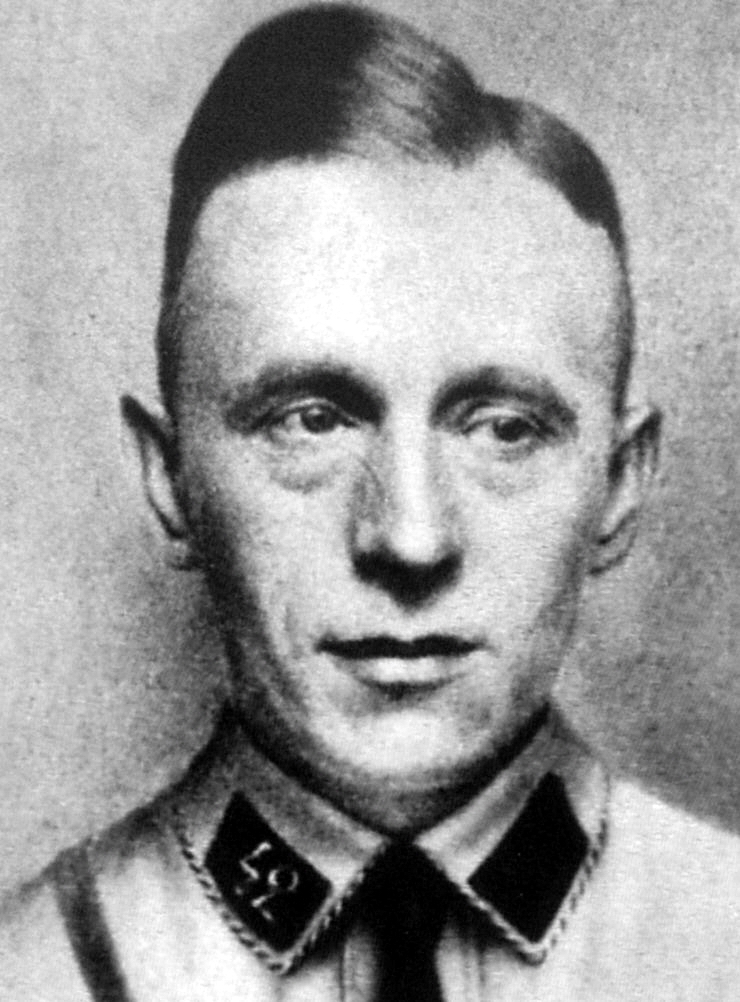
Fritz Schulz was a resistance fighter against the Weimar Republic and a Blood martyr of the National Socialist movement.
The political views of the Berlin SS man Fritz Schulz had long been known. His small barbershop was raided several times and the furnishings completely demolished. Eventually, the thirty-nine-year-old had to move the shop to another district of Berlin. But since he lacked the means, he had no choice but to stay in one of the red working-class neighbourhoods, thus jumping out of the frying pan into the fire.
The power of the communists in the Wedding district seemed to grow stronger and stronger as the political successes of the NSDAP became apparent. The SA and SS men had to accompany each other home after every service, as far as they could.
Fritz Schulz is on his way home from the „Loeper“ storm restaurant on the corner of Genterstraße and Luxemburger Straße with some comrades of SS-Sturm 2/III/42. Only two hundred metres further south on the corner of Triftstraße and Sparrstraße is the political opponent’s public house, the restaurant „Zur Alten Linde“. As the group passes the pub at around L50 o’clock, a superior number of communists rush out of the pub at the relay men. The National Socialists see knife blades flashing, then shots are fired. Hit by several bullets, Schulz collapses dead in front of the house at Triftstraße 67. During a bloody street battle, SS men Moser, Kühne, Piel and Otto Schulz are injured by gunshots and knife wounds. The attackers retreat back into the pub when the police raiding party arrives. After the officers have broken down the door of the „Alte Linde“, about twenty people, among them the upholsterer Karl Burmeister, are arrested and the rooms are searched. The police find several bludgeoning and stabbing weapons, as well as cartridge cases.
The unit of the fallen later bore the honorary name „SS- Sturm 2 Fritz Schulz“. On 11 August 1934, a memorial plaque was dedicated at the scene:
A memorial plaque was unveiled at the site of the murder on 11 August 1934:
Here fell on 3 August 1932
by red murderer’s hand
the SS man Fritz Schulz.
His honour was called loyalty.
Herbert Gatschke
(* 14 October 1906, † 30 August 1932 in Berlin)
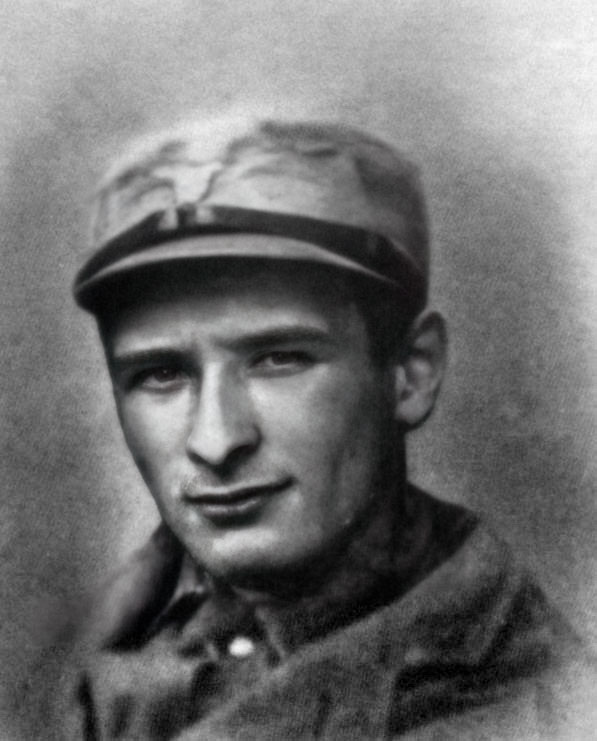
Herbert Gatschke was a resistance fighter against the Weimar Republic and a Blood martyr to the National Socialist movement.
In Berlin-Charlottenburg, the NSDAP holds a rally in the Hohenzollern Festival Halls on 29 August 1932. The Sturm 33 Maikowskis had taken over the protection of the hall. After leaving the hall in the early morning hours of 30 August 1932, his SA comrades go to the Sturmlokal in Röntgenstraße. The commune is already lurking there, shots whip through the nocturnal street. Herbert Gatschke and his two comrades are attacked by about 30 communists. Herbert Gatschke, a twenty-six-year-old businessman from Berlin-Charlottenburg, was fatally shot. As an SA paramedic he did his duty tirelessly. His two comrades are also seriously wounded. Herbert Gatschke left behind a wife and three small children.
Hans Maikowski wrote on the occasion of the murder of Herbert Gatschke:
„SA men of the 33rd Storm! No other storm is so closely related to the struggle for a German Berlin as the 33ers. You kept the Charlottenburg Commune, a select criminal rabble, in check. The street is ours, but 20 per cent of the Sturm were thrown into the dungeons of this republic. The Commune, thus made safe, began new acts of terror. The SA man Gatschke, whom the red murdering rabble shot on 29 August in a cowardly attack, will never be forgotten by us. Who did the thugs shoot? Not a capitalist, not an exploiter, but an unemployed man who left behind a wife and three children. We won’t talk about it any further. For every 33er there is only one slogan now: ‘Silence and action. I order mourning for Sturm 33 until the murder of our comrade Gatschke is atoned for. Hans Maikowski, Sturmführer 33.“
Adolf Hitler gave the eulogy at the funeral in the Luisenstädt cemetery in Berlin on 3 September 1932. Addressing Herbert Gatschke’s widow and comrades, he said:
„Many can die in Germany, but their death will not mean the same. For hundreds, death is particularly difficult because it means for them not only a farewell to life, but also to Germany, for which they died. There is no other thanks for us National Socialists than to vow that the struggle for Germany will continue unabated. You died for it, we will continue to fight for it! And if ever temptation should approach one of us, then the sacrificial death of our comrades will show him what our path is to be. If our dead no longer had the good fortune to witness Germany’s rise, then we have the sacred duty not to act on our dead as Germany did in 1918, because then they would have died in vain! Our dead will not have died in vain.“

The Führer at the grave of Herbert Gatschke during his eulogy.
The newspaper Der Angriff wrote about the events:
The Führer gives the SA man Gatschke his last escort
While elsewhere the reaction is celebrating its festivities, National Socialist Berlin was once again in deep mourning. As so often before, the party comrades of Berlin once again directed their steps to the Luisenstädt cemetery last Saturday to pay their last respects to our SA comrade Gatschke, who was killed by a cowardly red murderer. Once again, a fresh burial mound arches over a National Socialist Blood martyr who has now found his way home to his dead comrades. More and more people flocked to the Hasenheide. The Berlin SA storm troopers arrived in full numbers and lined up in long brown trellis lines at the cemetery. Our SA comrade Gatschke lies solemnly laid out in the mortuary at the entrance to the cemetery. The coffin is wrapped in a huge swastika flag. A wall of green wreaths and fragrant bouquets of flowers is effectively enlivened by memorial ribbons in the colours of our movement. The silence of death reigns all around. Frozen in posture and expression, comrades of the 33rd Storm flank the coffin and hold guard of honour. After our Gauführer Pg. Dr. Goebbels and the Obergruppenführer Pg. Graf Helldorf enter the mortuary, the funeral service begins. In a long memorial speech, the clergyman pays tribute to the martyrdom of the now dead SA man. In the meantime, our Führer Adolf Hitler has arrived at the cemetery, accompanied by Reichstag President Pg. Göring, and joins the funeral procession - at first almost unnoticed. During his presence in Berlin, the Führer did not miss the opportunity to pay his last respects to his dead comrade-in-arms. A forest of mourning flags surrounds the open tomb. On its edge, a German wife and mother stands still and weeping. Once again, this hour gives birth to immense anger about the assassin who not only took away one of our best, but also murdered the faithful father of three underage children and the life partner of a young woman in the open street. After a short church ceremony at the grave, our district leader took the floor. Full of bitter rage, he lined up accusation after accusation, not only against the Bolshevik murder pack, no, also against the system of „national concentration“, which had proved incapable of chasing away the red murder spook.
„But we vow that our idea, for which so many have already suffered and bled, and for which our SA comrade Gatschke also went to his death, will not be falsified and turned into the opposite!“ In short soldierly words, Pg. Graf Helldorf also dedicates a warm commemorative call to the dead. Then Adolf Hitler approaches the grave and lays a large bouquet of beautiful roses. Deep silence all around as the Führer begins to speak: „Many can die in Germany, but their death will not mean the same. For hundreds, death is especially hard because it means to them not only a farewell to life, but also to Germany, for which they died.“ There would be no other thanks for us National Socialists, Adolf Hitler continued, than to vow that the struggle for Germany would continue unabated. „You died for it, we will continue to fight for it! And if ever temptation should approach one of us, the sacrificial death of our comrades will show him what our path is to be. If our dead were not fortunate enough to witness Germany’s rise, then we have a duty not to commemorate our dead as Germany did in 1918, because then they would have died in vain!“ The last words of the Führer have faded away. A National Socialist murdered in the fight for Germany’s freedom has found his final resting place. His sacrifice has not yet been atoned for.
But we all know our duty: Over graves forward!
In Berlin, a street was named in Herbert Gatschke’s honour. In the health house located opposite the clinic on the Urban in Berlin on the corner of Fontanepromenade (Am Urban 10/11), the SA set up a Reichssanitätsschule, which they named after Herbert Gatschke.
August Aßmann
(* 11 August 1914, † 6 September 1932 in Graz)
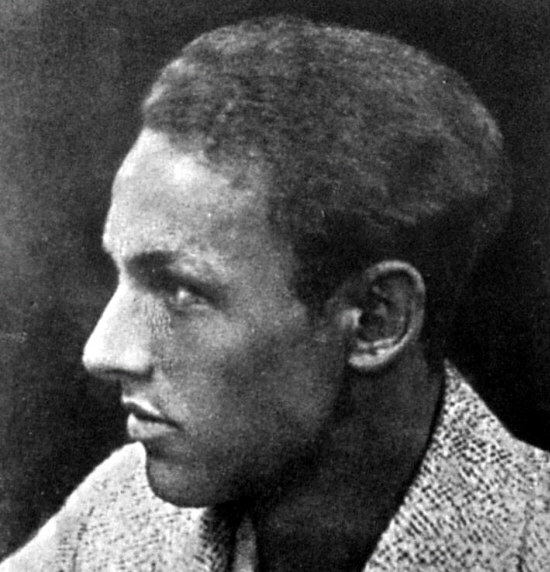
August Aßmann was a Blood martyr of the National Socialist movement.
On Tuesday, 6 September 1932, a meeting of the NSDAP took place in Graz, which was attended by about 450 people, including a large group of communists and social democrats, and at which a former communist leader from Steyr appeared as a speaker. Already during the meeting there were repeated clashes between communists and national socialists in the vicinity of the pub. Finally, at Albrechtsbrücke, six SS men were attacked by a group of about 50 young socialists equipped with sticks, knives and revolvers and chased across the bridge to Fischmarkt. In the process, 18-year-old construction student and SS man August Aßmann from Graz was fatally injured by a knife thrust. Three other SS men and a non-party member were wounded by stabs and blows.
After the end of the meeting, several squads of National Socialists had to be escorted home by patrols.
August Aßmann was the first Blood martyr in Styria.
Josef Laß
(† 7 September 1932 in Leoben)
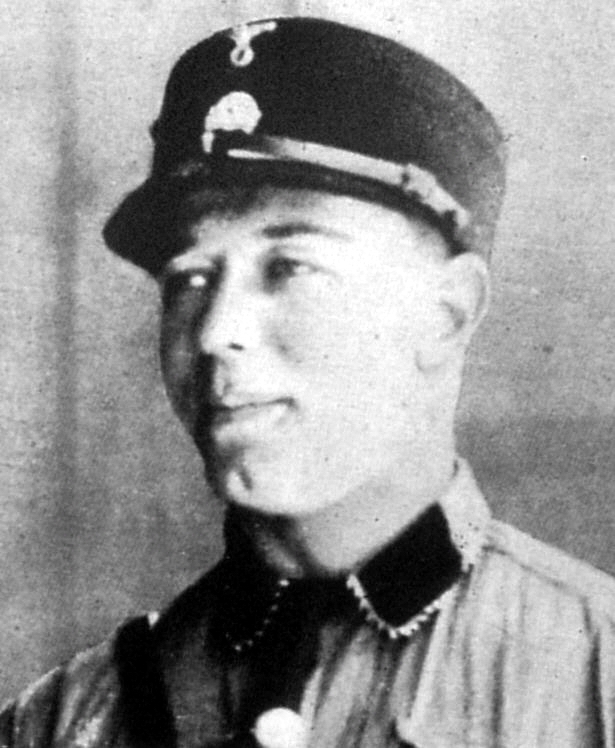
Josef Laß was a Blood martyr of the National Socialist movement.
On Wednesday, 7 September 1932, a Social Democratic and a National Socialist meeting took place simultaneously in Leoben. A brawl broke out between National Socialists and Social Democrats, during which a National Socialist was seriously injured by a stab in the stomach. After the end of the meeting the National Socialists had to be protected by gendarmerie patrols. The National Socialists living in Leoben were escorted to the main square, then refused to be escorted any further, dispersed and went home. On this way home, the National Socialist and machine fitter Josef Laß, who was walking with his father, was killed by a shot, apparently from a revolver, near the city tower in Schulgasse. His father shot from his pistol in the direction from which the shot had come, but because of the darkness he could not see whether anyone was in that direction. A young socialist was identified as the murderer.
Willi Weber
(*2.7.1904 - † 9.9.1932)
District Hesse-Nassau

Willi Weber is one of the Blood martyres who, almost without exception, remain unnamed in contemporary sources.
A book from 1936 describes the Hessian fallen of the movement:
„Willi Weber was born on 2 July 1904 in Altenburg near Alsfeld [in Hesse] as the son of the teacher Heinrich Weber there. He attended primary schools for two years and then entered the Oberrealschule at Easter 1913, which he attended until lower secondary school. He then learned the profession of gardener and became self-employed in 1924.
Willi Weber was politically active at an early age and joined the NSDAP as an SA man in the spring of 1930. He always did his service with zeal and constant readiness. During a propaganda march to Nieder- Ofleiden, his unarmed detachment was attacked by heavily armed communists on 16 July 1932. A Marxist murder bullet also hit him. Severely wounded by a bullet in the thigh, our comrade Willi Weber, after a hard struggle, transferred to the Horst Wessel standard on 9 September. The proud storms of Upper Hesse hold his memory in honour and his example as an obligation in their minds.”
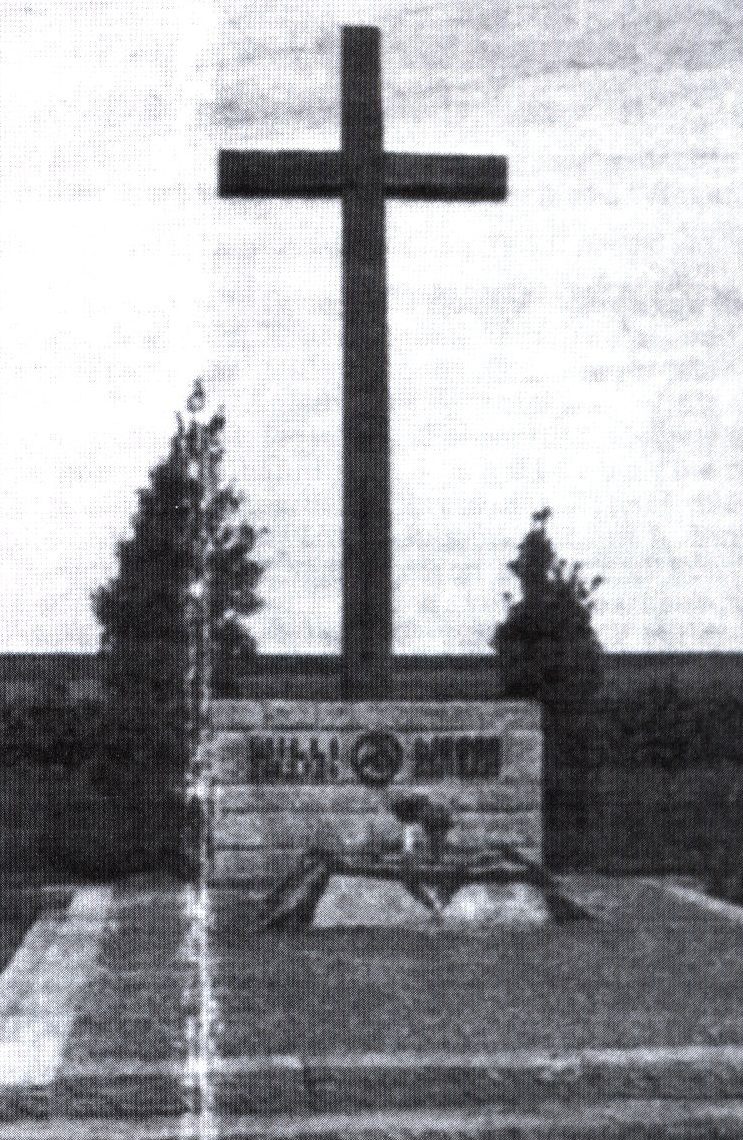
The grave of honour of the murdered Willi Weber

The flag of the SA storm Willi Weber
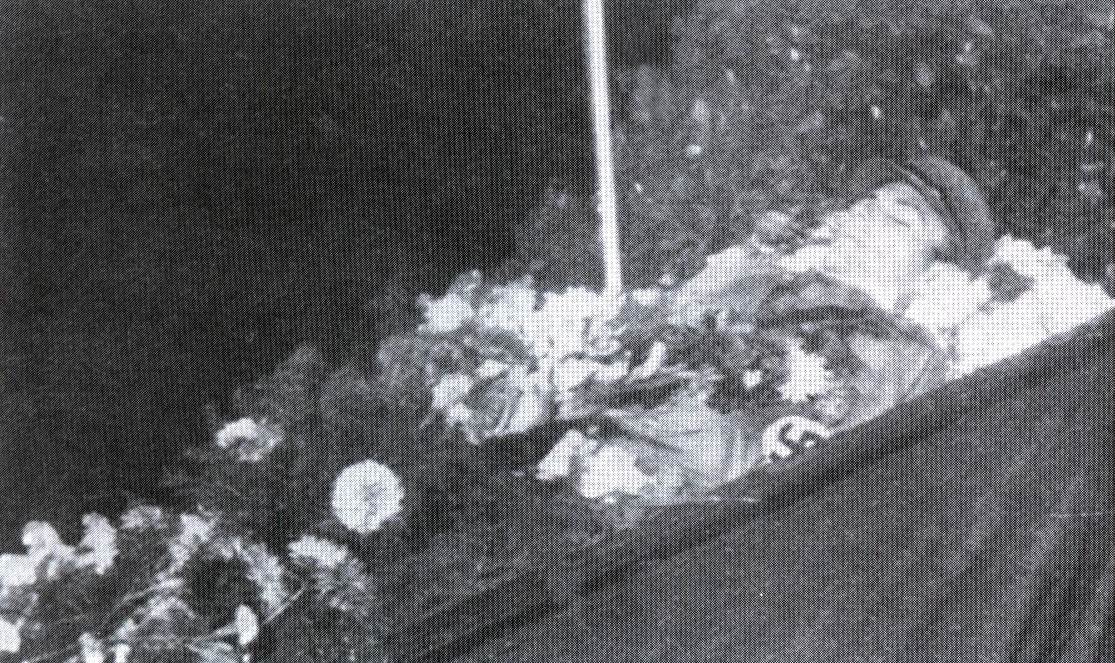
The laid out SA man Willi Weber

The SA carries its comrade Weber to the grave
Erich Niejahr
(*14.1.1917 - † 5.10.1932)
District Cologne-Aachen
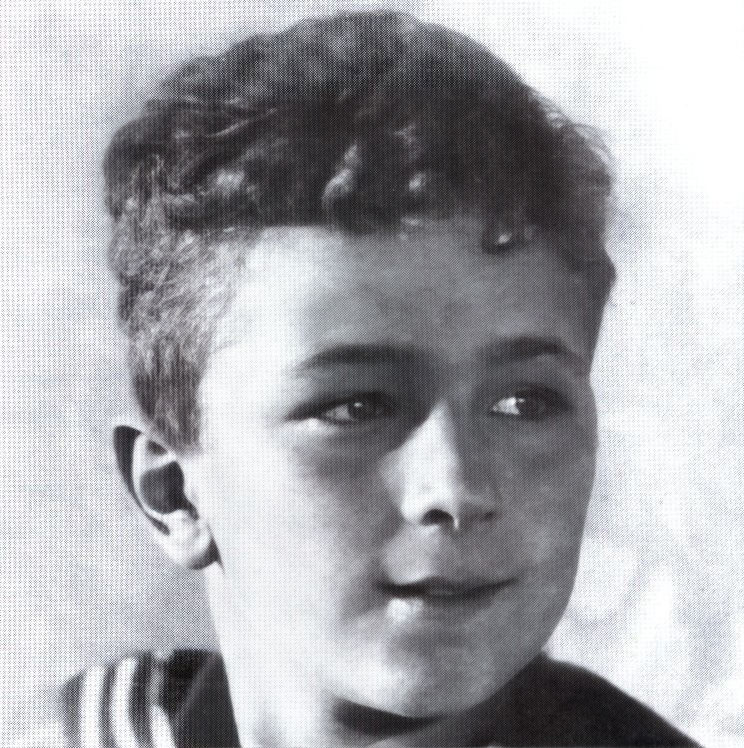
Erich Niejahr was the youngest Blood martyr of the National Socialist movement, proven beyond doubt.
The boy was born in Sundweg near Iserlohn.
The father Erich Hans Niejahr had served in the First World War and was a storm leader of an SA unit in Cologne. The family lived with their five children in the working-class district of Riehl in Cologne. Early on, Erich had contact with the NSDAP through his father and became a member of the very active Cologne Marine HJ. In addition to the usual evenings at home, the service consisted primarily of nautical training on the Rhine with the cutter „Deutschland“.
Like the whole family, Erich played an instrument. A picture shows the boy with his violin. Initially, Erich Niejahr had attended primary school in Nibelungenstraße in the Mauenheim district. He then completed an apprenticeship as a confectioner at the Kirschbaum café on Kaiser-Wilhelm-Ring in Cologne. His father was an employee at the Cologne labour office. He was known in the red area as an active SA man and hated by his political opponents. The family was often mobbed and threatened in front of the house entrance at Kevelaer Straße 16. There were even attempts to
The attempt to storm the flat had already taken place several times before the bloody confrontation in the late summer of 1932. The fatal assault is described by the brother of the then fifteen-year-old Marine Hitler boy:
„Father was an SA storm leader and was to be exterminated with the whole family. On 29. 8. 1932 in the evening at about 8 p.m. it started. The communists forced their way into the house and beat my mother, who was defending the entrance. Father tried to call for reinforcements. The attackers dragged my mother out into the street by her hair and beat her with objects. The consequences were a fractured skull base and several broken ribs. Erich Niejahr came home from work and saw all this. He turned around to call the police. He stumbled. A mob of grown men pounced on him and beat him until he didn’t move. I myself hid in the cellar entrance and still have the image in my mind’s eye of how they maltreated my mother. All this happened in our flat, which was in a dead-end street. You could get in, but it was difficult to get out. Afterwards we were taken to the SA house at Eidstraße 73 and hidden. However, we did not find peace from attacks until 1933.”
The Gebietsführererschule Niederlahnstein near Koblenz, a RAD camp in the Eifel and the cutter of Niejahr’s Marine-HJ-Kameradschaft were named after him.
After the attack, the boy complained almost continuously of headaches until he was finally admitted to the Vinzenz Hospital on 23 September, where he lost consciousness and did not wake up again. Erich Niejahr was not able to attend the boat christening of his HJ entourage as planned. He died on 5 October 1932.
The alleged perpetrators were the communists Weingartz, Hasseiweiler and the Schmitz brothers.
His father was also a victim of political violence. He died in a Soviet concentration camp after 1945.
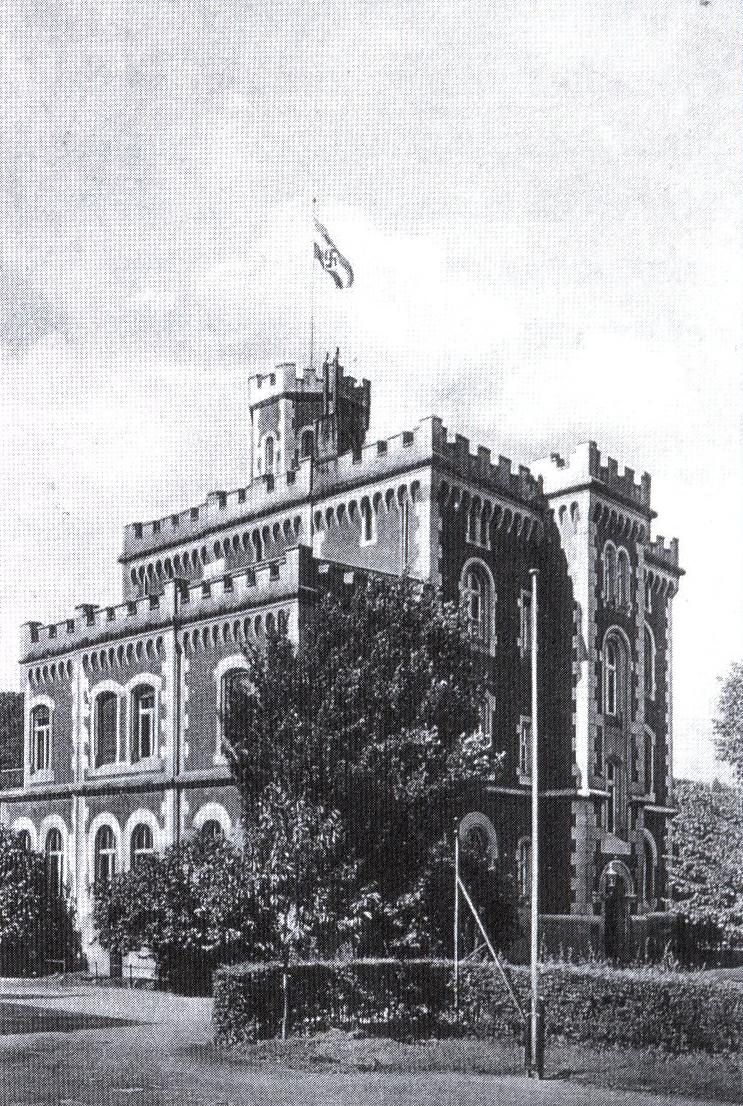
The Hitler Youth District Leader School „Erich Niejahr”
Gregor Schmid [Schmidt]
(* 1 April 1912, † 10 October 1932 in Stuttgart)
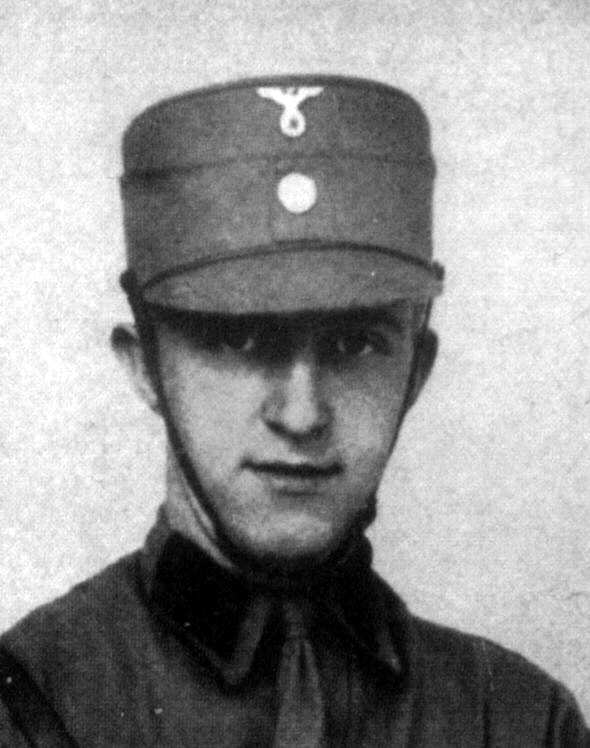
Gregor Schmid [Schmidt] was a resistance fighter against the Weimar Republic and a Blood martyr to the National Socialist movement.
On the day of the Reichstag elections, the unit of the Stuttgart SA man Gregor Schmidt had gathered at the Sturmlokal to follow the results on the radio. Around zero o’clock, Schmidt accompanied an SA comrade home, who had already been threatened several times by political opponents. As the twenty-year-old confectioner is on his way back, he encounters a communist squad near the town hall. They attack him and severely injure him with steel rods. His skull is fractured and he suffers from encephalitis. The SA man dies on 10 October 1932.
The „NS-Kurier“ wrote about the murder:
„Election night from 31 July to 1 August 1932. The mob of the old town gathers at the Wilhelmsbau in Stuttgart. SA man Schmid runs into them as he accompanies a comrade home. Shouting „Revenge for the election“ and „Beat them to death, the brown murder plague“, the red hordes pounce on him. Schmid tries to escape, but is caught up and beaten to the ground. His stab and slash wounds are sewn up. Helpful comrades take him away to recover. But his condition worsens from day to day. X-rays reveal skull fractures. When he sees his death in agonising pain, he says: „I want to die, because I can’t be an SA man any more.
His last words were:
„My mother is the most important thing to me, but my Germany is even more important!“
A street in Filderstadt bore his name.
Josef Grün
(date of birth unknown - † 26. 10. 1932)
District Vienna
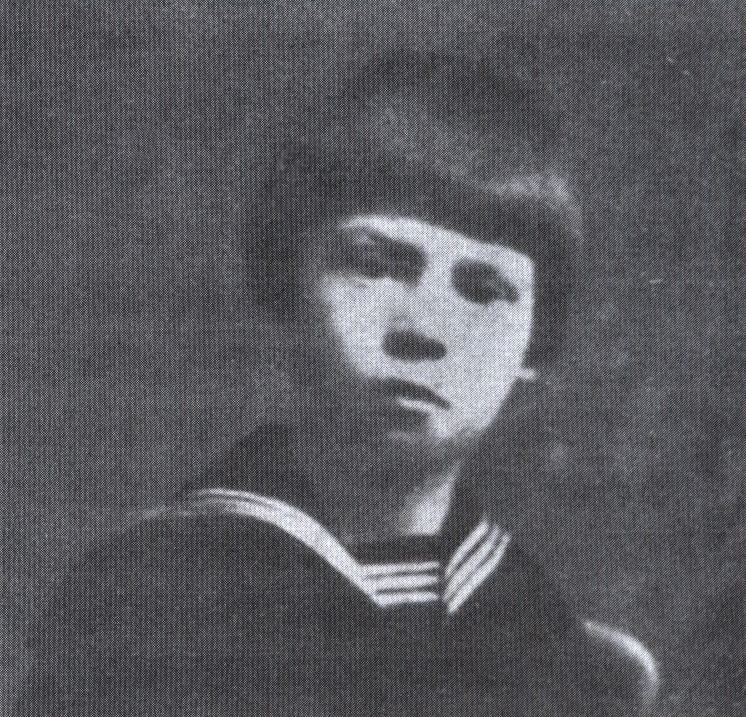
Kinderbild des mit elf Jahren Tode gekommenen Jungvolkjungen
Child’s picture of the Jungvolk boy who died at the age of eleven
Josef Grün would be by far the youngest Austrian victim of political violence from the left against the National Socialists. However, the background of the crime cannot be clearly clarified.
After the funeral of the two victims of the collision in the Vienna district of Simmering Staller and Sennhofer, the eleven-year-old Jungvolk boy Josef Grün is said to have accidentally bumped into some Social Democrats on Vienna’s Bebelplatz in front of the house with the number 3, who knocked him down. A few days later the boy allegedly died of cirrhosis of the liver. According to medical information, however, this cause of death cannot be related to external influence.
Grün is almost exclusively listed as a Blood martyr in the Hitler Youth sources. The eleven-year-old is also found in the HJ collection of regulations, which is the most official source in this area.
When asked, a former Viennese HJ leader stated that the entire „Josef Grün“ case had been a rumour that was merely recorded in the HJ annals.
Nevertheless, news of the young murder victim of political violence reached as far as northern Germany.
The „Hamburger Nachrichten“, of Thursday, 27 October 1932, reported briefly but clearly on the incident:
„Tragic Death of a Viennese Hitler Youth
Vienna, 26 October
Joseph Grün, a twelve-year-old member of the Hitler Youth, while visiting the graves of the two National Socialists killed in the Simmering incidents at the Ottakringer cemetery on Sunday, received such a violent blow to the stomach from a man wearing the Three Arrows badge that he sustained severe internal injuries, to which he succumbed in hospital.“
Despite the not fully clarified background, Josef Grün remained a martyr of the National Socialist movement until 1945.
Alfred Kindler
(* 1 December 1907 in Leipzig, † 16 October 1932 ibid)
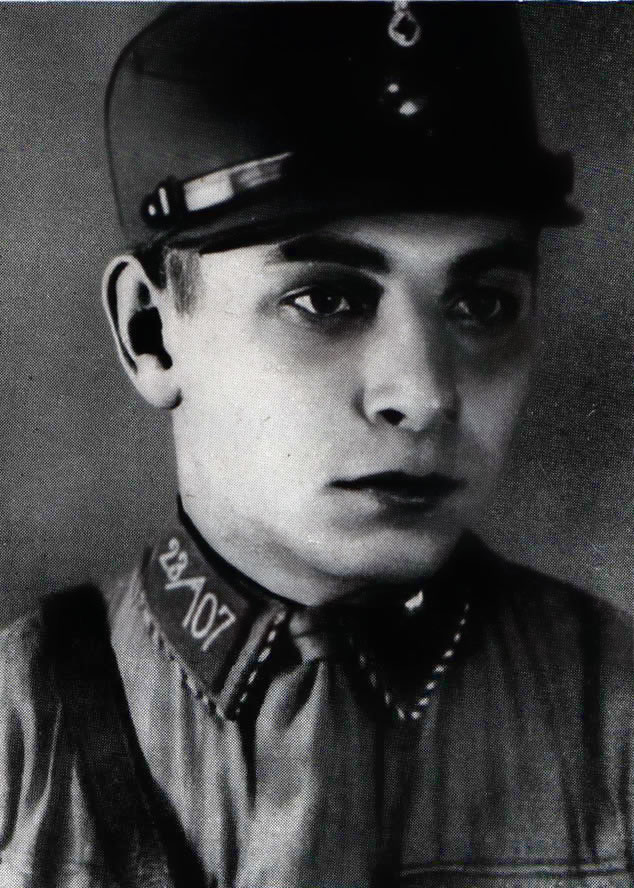
Alfred Kindler was a resistance fighter against the Weimar Republic and a Blood martyr to the National Socialist movement.
Alfred Kindler joined the NSDAP and the SA on 1 March 1932.
On 16 October 1932, the Leipzig district of the NSDAP held an election rally attended by about 30,000 people. In the evening at around 9.30 pm, SA men marched home after an uplifting day. Then shots from the Reichsbanner banner bang out of the „Arbeitsheim“, knocking four SA men to the ground, seriously injured. A fifth, the deputy squad leader Alfred Kindler, is taken to hospital with a severe lung injury and dies there. The twenty-five-year-old journeyman baker wanted to marry a month later.
On 8 November 1938, a solemn procession took place in Leipzig, during which the coffins of the seven Leipzig Blood martyres Walter Blümel, Alfred Kindler, Erich Kunze, Heinrich Limbach, Alfred Manietta, Erich Sallie and Rudolf Schröter were first brought from the North Cemetery to the Markt, where the dead were called „to the last roll call“. Instead of them, the formation of honour responded with „Here!“ when each name was called. The coffins were then transferred to the grove of honour specially created for them at Leipzig’s South Cemetery.
In Leipzig, a street bore his name.
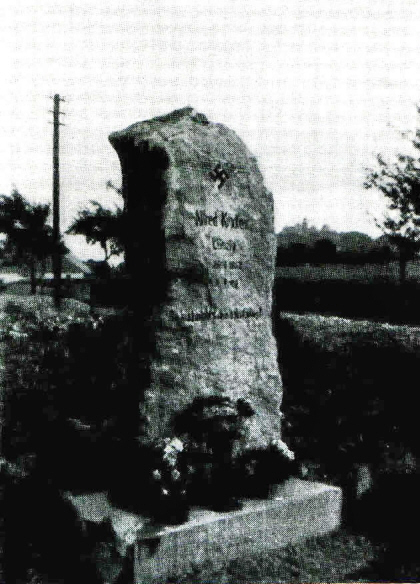
Memorial stone for Alfred Kindler

Grave of Alfred Kindler
Josef Staller
(† 16 October 1932 in Vienna)
Josef Staller was a Blood martyr of the National Socialist movement.
Josef Staller was murdered by Social Democrats during an altercation in the Simmering district of Vienna.

The murdered: Josef Staller and Otto Sennhofer
Early on Sunday morning, a unit of the Republican Protection League, an organisation comparable to the Reichsbanner, occupied the Social Democratic party pub at Drischützgasse No. 4. The men called up for stand-by duty had been openly told to bring firearms. At about 10.30 a.m. several marching bands, followed by several hundred Brown Shirts, started to move. A strong group of political opponents also accompanied the procession. Already at this point, clashes could only be prevented by a massive police presence.
Nevertheless, the first fisticuffs occur during the march in Lorystraße. A short time later, the participants are violently insulted by a group of social democrats in front of the apartment block Geiselbergstraße 4. The intervention of the security forces prevented worse. In the course of the procession, attacks and resistance increase in intensity. About fifteen Brown Shirts are cut off from the main body during one attack. The small group tries to flee from the attacking crowd. The escape route takes the men past the crowded Social Democratic party home in Drischützgasse.
The National Socialists clash with the Schutzbündlers posted in front of the building. When a mounted police unit arrives, the leftists break away from their opponent and retreat into the building. The Sturmabteilung is pushed by the officers in the direction of Enkplatz. Karl Tlasek, a police officer organised along social democratic lines, is hit in the head. The policeman is killed instantly. He is carried out of the field of fire by officers and National Socialists. Heavy fire starts from the ground and first floors of the party home. Moments later the police return fire. Twenty-one-year-old SA man Josef Staller and NSDAP member Otto Sennhofer collapse, fatally shot.
During the fight, 35 police officers, 18 SA and SS men and 30 other uninvolved persons were injured, some seriously.
Karl Heinzelmann
(* 2 June 1913?, Württemberg † 20 October 1932 in Hamburg)
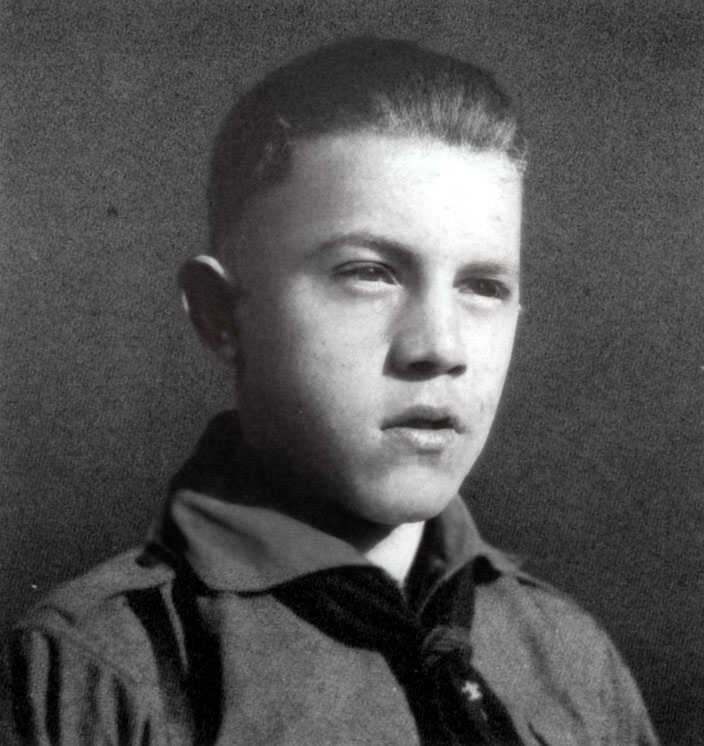
Karl Heinzelmann was a resistance fighter against the Weimar Republic and a Blood martyr to the National Socialist movement.
The journeyman painter Karl Heinzelmann wanted to go to sea. That’s why the Swabian’s apprenticeship took him to Hamburg. There he was referred to the naval SA. He and some comrades were on hall security duty in Hamburg’s red Gänge district. On his way home, he and his comrades were attacked. Shots were fired. Then the men are attacked with knives. Karl Heinzelmann is hit in the back. Two blows were so powerful that they injured the spinal cord. The nineteen-year-old SA man lay in a waterbed, paralysed from the chest down, for five months before he died.
A memorial plaque in Herrengraben marked the scene of the crime. The extension of Biosweg in Hamburg was renamed Karl-Heinzelmann-Straße. An Alster steamer also bore the name of the dead man. The Marine-SA-Sturm 2, to which the young Sturmabteilungsmann belonged, was given the honorary name „Marine-SA-Sturm 2 Karl Heinzelmann“.
„Es fiel ein unbekannter SA-Mann“ („An unknown SA man fell“) was the headline of a harrowing essay in the „NS-Kurier“, Stuttgart, which gave a vivid picture of the political conditions in Germany in 1932:
Election campaign 1932! The German people splintered into 35 parties and groups, enemies to the knife, but united in the fight against Adolf Hitler’s German freedom movement. Lies and slander, as we „old people“ have come to know them well enough, are flowing against us in torrents. One assembly of us chases the other. The lied-to people must awaken if they are not to face annihilation.
The Führer himself increases the pace of the meetings. This morning in the East, at noon in the South, in the evening he speaks in the West, millions hear him and become convinced of the idea of National Socialism.
May night in Hamburg. Down in the red harbour district, a meeting of the NSDAP. Marine-SA has lined up to protect the hall. A small crowd against forty Reds. These forty are backed up by the mob lurking in the taverns. Whistles sound, stones pelt into windows: National Socialist-i-i-i verrecke! Red Front out! Party comrade Markmann speaks calmly about the mistakes of the government, about corruption, horse-trading, scandals on the loose, wants to rejoin the seduced in the true community of the people and their fate.
The air was thick that evening. The party comrades are taken home under police protection, then the naval SA also departs in unison. Silently, with eyes and senses alert, they march through the dark alleys of the harbour district. Should they really get home scot-free this time? It has become so strangely quiet in the whole neighbourhood. The one comrade in the link has only been in Hamburg for two days, he looks around in amazement, he doesn’t know the hustle and bustle of the big city. His home in the Allgäu, on the other hand, is in quiet peace. Like many of his fellow citizens, he is unemployed and drawn to the sea. He has already spent many weeks wandering through German districts, wanting to get to know Germany, his dear fatherland, wanting to go to sea. Will there be a job for him there? He did his first duty as a dutiful SA man from Sturm 2/124 Leutkirch in the red combat zone. Calmly, watching on all sides, the SA marine strides along. Suddenly two long whistles! Aha, here we go! Red Front is attacking!
Silent, fierce fighting, only knives and clubs are in action, not a shot, not a loud shout, only here and there suppressed curses of rage. Bottles and flower pots clatter down from the roofs into the turmoil of battle. SA Marine 2 clears the street with twenty-five men, but in the middle of the pavement lies SA man Comrade Karl Heinzelmann. He was stabbed six times, one of which cut his spine. Mortally wounded, he was taken to hospital, and his time of suffering was about to begin. For months he lay in a waterbed with a paralysed abdomen.
Being a National Socialist means making sacrifices. The old father travels to him, wants to see his boy once more, the wounds on Karl’s body have already gnawed badly. Comrades visit him, bring him gifts as far as his own unemployment allows, spring flowers decorate the room so that no space is left empty. On a table stands the picture of the Führer with his own signature, his pride and joy. He is willing to suffer for the Führer, even to die if necessary. No remorse overtakes him, an SA man must have no regrets, he must persevere.
In a letter to his comrades he writes, among other things:
„I myself think: one day the day of revenge will come, I will gladly bleed for my Führer and the freedom of the German people. I remain loyal to my Führer far away, even if I have to bleed again or go to my death. My struggle is for Marxism. I continue my struggle even more fiercely than I have done so far. Fight with all your might for a free Germany.
You should believe in Germany’s future,
To our people’s resurrection.
Do not let this faith rob you
Despite everything, everything that happened.“

The „last ride“ of the SA man Karl Heinzelmann
August Pfaff
(* 25 March 1910, † 22 October 1932 in Castrop-Rauxel)
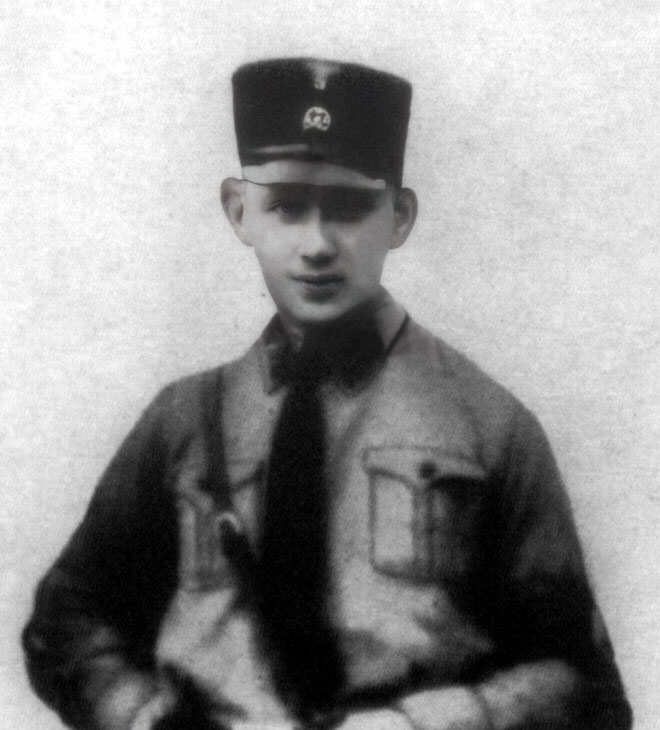
August Pfaff was a resistance fighter against the Weimar Republic and a Blood martyr to the National Socialist movement.
On 22 October 1932, the SS man August Pfaff, an electrician from Castrop-Rauxel, is attacked and shot by communists while distributing leaflets. They were distributing campaign leaflets for the Reichstag elections on 6 November. The small group is accompanied by a police patrol for protection. Suddenly they are fired upon. Then about 80 communists attack. The police were able to arrest eight communists, but the main perpetrator escaped.
His comrades wrote the following memorial:
„SA marches across the street. Tight, brown boys, and they sing songs of a Germany that will rise again glorious and magnificent. School friends, comrades of his are there and wave and greet him with their eyes. They tell him about Adolf Hitler and in the gleam of their familiar eyes he reads the wake-up call of a new era. His heart goes over with waving flags to Hitler’s freedom fights and when he wears the brown shirt himself, his eyes have their old and joyful shine again. He becomes the best comrade, the most loyal friend, modest and always ready to help. He is cut from the wood that makes Hitler’s brown army so respectful and insurmountable. He becomes a drummer among drummers. And how he can drum! - At stamp posts, at factory gates and in dark suburban alleys he canvasses for the good cause in faithful and eloquent words, and his greatest pride is to have won another one for Hitler’s idea. The red mob rages in the streets, election campaigns rage. August Pfaff is always in the front rank. The sacred flame blazes in his heart, and his honour is his people’s honour. Day after day and night after night he stands at his post, where he has placed himself in sacrificial devotion. To his enemies he is a serious enemy, to his friends he is a dear friend. Devoted loyalty is in his nature, and all is outshone by a sunny humour which cheers and refreshes his comrades as if they were taking a cleansing bath. He is the favourite of all the children, and Uncle Boston is often jokingly called him by his friends. In hours of rest, he is drawn to the German forest. Birdsong and forest murmurs cleanse unclear thoughts, and when, lying on his back, he looks through the tangle of leaves, when he lets the sublime solemnity of the forest affect him, he gathers strength and confidence for new deeds.“
The current Hellkampstraße in Gelsenkirchen bore his honorary name.
Helmut Barm
(* 1 July 1913, † 23 October 1932 in Bochum-Langendreer)

Helmut Barm was a resistance fighter against the Weimar Republic and a Blood martyr to the National Socialist movement.
Helmut Barm joined the NSDAP and the SA in August 1931.
Once, when communists wanted to storm an SA home, he rushed to the aid of his comrades from his workplace. On 22 October 1932, too, it was a matter of coming to the aid of harassed SA comrades. They had to turn back and when they later tried to go to their SA home in Langendreer, they were shot at from ambush. The Barm is hit by a bullet from a Marxist police officer who had already mobbed and beaten other SA men.
„I want to see my mother once more! I want to go to the SA home one more time!“
With these words, the SA man Helmut Barm dies for Adolf Hitler on 23 October 1932 at the age of nineteen.
The murderer, however, is arrested and has to „atone“ for the murder with two years and one month in prison.
In Bochum, Helmut Barm Square bore his name.
Richard Harwik
(* 2 April 1883, † 27 October 1932 in Berlin)
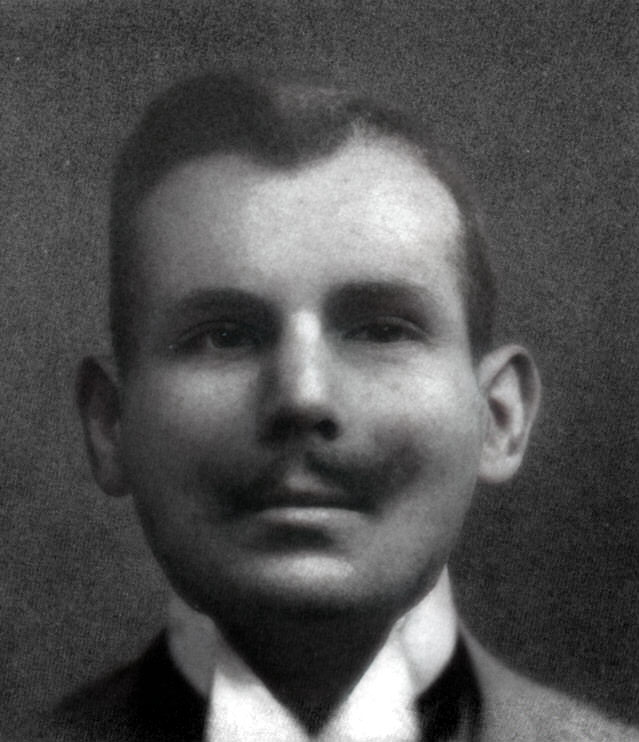
Richard Harwik was a resistance fighter against the Weimar Republic and a Blood martyr to the National Socialist movement.
On 27 October 1932, the SA Scharführer Richard Harwick was attacked and murdered by Jews and communists. Around 3 o’clock he went home with a comrade. The night before, they had hall protection in the Germania halls. There they were ambushed and beaten up. The forty-nine-year-old carpenter from Berlin, a father of four minor children, died hours later of cranial injuries.
The murderer is dragged to the police station by the victim’s comrades - but the Weimar system police release him.
The newspaper Der Angriff wrote about the events:
SA. man Richard Harwik’s last ride
He fell so that Germany might live
Party comrades and SA comrades in Berlin escort him in their thousands to his final resting place.
We have buried a fighter for Germany’s honour and freedom. Through the misty twilight of yesterday’s autumn afternoon we walked behind a coffin containing the mortal remains of our dead SA. comrade Richard Harwik. Knocked to the ground by a brutal Marxist fist, Richard Harwik died a hero’s death like those 400 murdered SA men who remain eternally unforgotten to us as martyrs of the National Socialist struggle for freedom. We buried a soldier. A soldier of the Great World War, a soldier of the self-protection struggle of Upper Silesia and a soldier of our Führer Adolf Hitler.
Once again, National Socialist Berlin gathered on the graveyard of the New Luisenstädt Cemetery in silent mourning. Once again, the banners with the swastika and the flags of mourning waved over the graves. The SA had lined up in endless rows in their brown dress of honour. On both sides of the SA line, standing shoulder to shoulder, black crowds waited in reverent silence. In the small chapel in front of the altar steps stands the coffin, wrapped in the red flag cloth with the swastika on a white background. On top, at the head of the coffin, the brown cap of the dead SA. man. It was not a new cap that lay there. Worn and weathered, it seemed to want to tell of days gone by, of hours of joy and sorrow, of rain and sunshine. Around the coffin, a green wall of beautiful wreaths and fragrant bouquets of flowers arched. Comrades of Storm 65, to which Richard Harwik belonged in life, form the guard of honour on both sides of the coffin. In deep sorrow, a German mother and her four underage children weep silently and introspectively. We all know about this pain. A German woman’s husband and her children’s father were slain. Now they sit at his coffin and weep. The quiet room is filled with soft organ music. Then the Protestant priest Wenzel speaks, although the dead man had always been an upright Catholic. The Catholic priest in charge had refused to give the dead man a church funeral under the banners of the swastika. Father Wenzel based his speech on God’s word: „Be faithful unto death, and I will give you the crown of eternal life.“ Once again the life of the murdered man passes before us, a life of work and struggle, the life and death of a simple German worker. After the end of the ceremony in the cemetery chapel, the funeral procession forms up to the narrow, cool earthen grave. The arms of the masses rise up in a last martial salute to their dead comrades. The flags are lowered. The song of the good comrade resounds. After a short commemorative speech by the priest at the open grave, the Obergruppenführer Pg. Graf Helldorf takes the floor in grateful remembrance of the last blood sacrifice of our movement. On behalf of the Führer Adolf Hitler, who unfortunately could not attend, the Obergruppenführer lays flowers and gives the Führer’s last greeting. Then the Berlin Gauleiter Pg. Dr. Goebbels spoke. In warm words, Pg. Dr. Goebbels commemorates the heroic death of Richard Harwik and vows to continue the struggle in the spirit of the dead until the last, victorious end.
The Berlin Gauleiter deplored the shameful behaviour of the Catholic clergyman who refused to give Richard Harwik his last rites as a representative of the Catholic Church: „Those who are commissioned by your church to stand here are not here, that is why they are called pastors. In their place, however, the German people stand at your grave, for whom you fought and suffered so often, and for whom you ultimately died.“
The Horst Wessel song resounds. The flags and standards are lowered. A forest of lofty arms rises into the grey twilight. It resounds far and wide like a pledge of allegiance by the masses of the Berlin people: „Comrades who shot the Red Front and reaction, march in spirit in our ranks!“ The Berlin SA. and the Berlin party comrades of the murdered man carried their murdered comrade to the grave like a king, he who was only a simple worker and unknown SA. man. At his open grave, however, the true German national community proved itself, for which the National Socialist fighter and hero Richard Harwik shed his blood.
In his spirit: over graves forward!
A commemorative plaque, inaugurated on 27 October 1936, was placed at the murder site, at 92 Oranienburger Strasse (Mitte district):
It was on this spot that Richard Harwik, SA Scharführer in Sturm 2/6, was murdered by Marxists on 27.10.1932.“
The Berlin SA storm 2/6 was named after him.
Erika Jordan
(*10.1.1915 - † 28.10.1932)
District Berlin
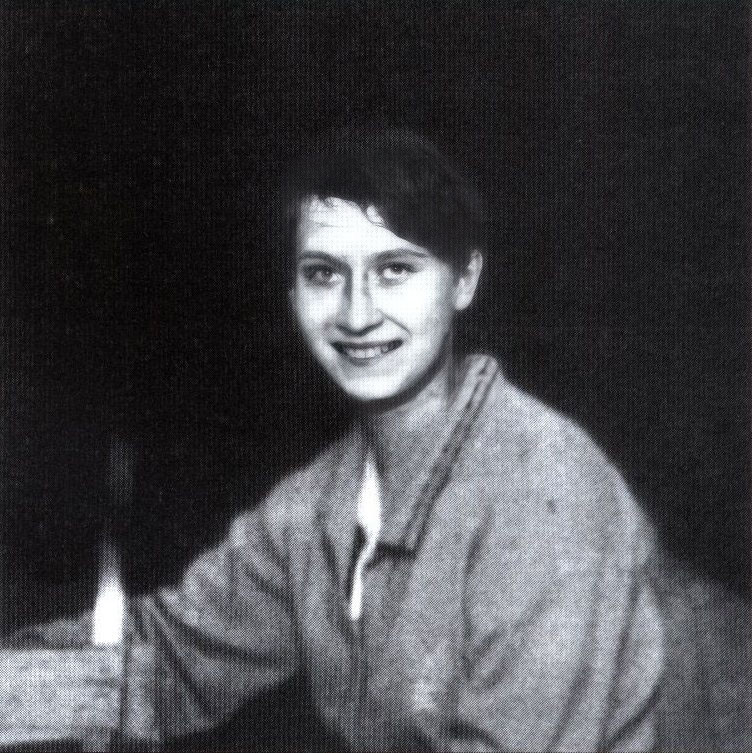
A single source writes about the sixteen-year-old:
„Erika Jordan, expediter, born 10 January 1915, member of the BDM in Berlin, attacked by members of the ‘Communist Youth of Germany’ on her way home in September 1932. She died of her severe injuries on 28 October 1932.“
The girl’s death appears neither in the National Socialist press nor in the bourgeois newspapers. Contemporary books and lists mention the name only sporadically. The Berlin residents’ register did not list Erika Jordan. However, the young woman did not necessarily live in Berlin. Furthermore, the fact that the injury and death occurred about a month apart means that the liberal press did not report it. Another contemporary reference to this third female Blood martyr is the naming of a BDM home in Berlin-Dahlem.
Independently of this, a letter of 8 November 1932 from the Reich Minister of the Interior’s intelligence collection centre characterises the communists’ street-fighting tactics not only in relation to the right, but also towards the equally hated police:
„In the event of an outbreak of revolutionary action, it is planned to take policemen’s wives and children from their flats and place them in front of the barricades. This is to prevent the officers from making use of their service pistols.“
Heinrich Hammacher
(* 5 June 1914, † 3 November 1932 in Duisburg-Meiderich)

Heinrich Hammacher was a resistance fighter against the Weimar Republic and a Blood martyr to the National Socialist movement.
Heinrich Hammacher, a blacksmith, marches in the ranks of the SA. On the march back from a mass meeting on 2 November 1932, an SA squad was shot at from ambush by communists. Two bullets penetrated Heinrich Hammacher’s head and lungs. The following day, 3 November 1932, he gave his life.
In Duisburg, the „Heinrich Hammacher Sportpark“ bears his honorary name. The Sandstraße, where the murder took place, was also named after him.
Kurt Reppich
(* 24 June 1886, † 4 November 1932 in Berlin)
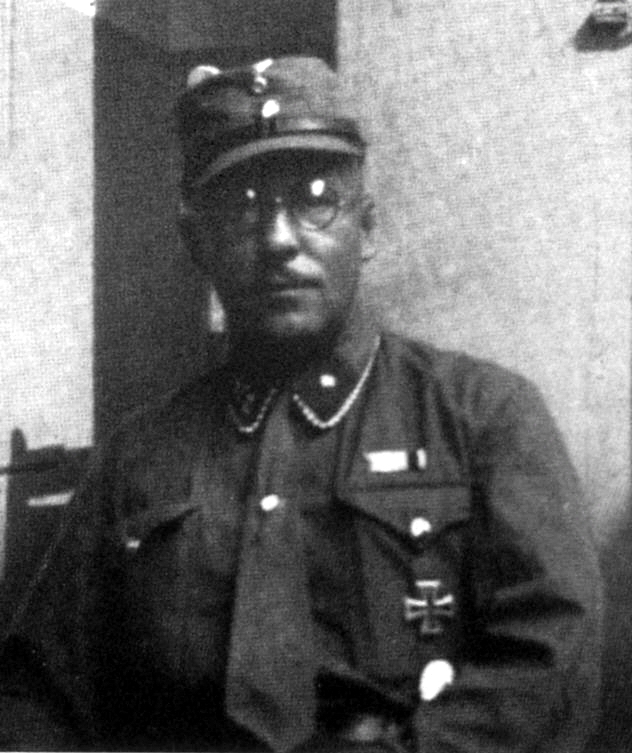
Kurt Reppich was a resistance fighter against the Weimar Republic and a Blood martyr of the National Socialist movement.
The SA Scharführer Kurt Reppich belonged to the „Teut“ troop of SA Storm 13, Schöneberg. He was a first lieutenant in the First World War and worked as a customs commissioner in Berlin until his death.
Early in the morning of 4 November 1932, a peaceful assembly of workers and employees of the BVG takes place in Martin-Luther-Straße. This strike does not have the wild, riotous character of the walkouts of earlier years. Many Germans who do not belong to the BVG show their sympathy to those fighting for their rights, stand with them in these hours and are thus strengthened. SA stands next to the comrades of labour. Kurt Reppich is also there. Even outwardly, he, the customs commissioner, does not belong to the workers of Faust.
Blue uniforms march out of the side street. This is the old guard of a Severing, parading at a hint from Isidor Weiß, kindly taken over by a cabinet of Kurt von Schleicher. Then suddenly: command, carbines at the ready....
Three demonstrators, including the SA man Kurt Reppich, were shot dead and eight others seriously injured. In view of the severe repression, the strike had to be called off after a few days. The wage cut of two pfennigs per hour remained.
Kurt Reppich was forty-six years old. His wife and fifteen-year-old daughter mourned at his bier. Forty thousand people later attended the funeral.
The Berlin Gauleiter Joseph Goebbels wrote about this in his diary on 11 November 1932:
„In Schöneberg we bury the SA man Reppich, who was shot during the strike. Forty thousand people are paying their respects. He is laid to rest like a prince. Planes with swastika pennants flying around them circle the cemetery as if to bid the dead man farewell. The SA people are deeply moved.“
A commemorative plaque for the Scharführer was placed on the house at Martin-Luther-Straße 26:
Here Kurt Reppich, SA-Scharführer in Sturm 13, was shot dead in the BVG strike. The NS labour comrades of the BVG. Station 10
Mühlenstraße in the Schöneberg district was named after Kurt Reppich. In 1947, the „liberators“ temporarily renamed it Dominicusstraße.
Johann [Hans] Cyranka
(* 10 October 1910, † 5 November 1932 in Hamburg)

Johann [Hans] Cyranka was a resistance fighter against the Weimar Republic and a Blood martyr of the National Socialist movement.
The master tailor Johann Cyranka originally came from Upper Silesia.
The fifth fatality of the Hamburg SA and SS in 1932 is SS man Johann Cyranka. On 31 October he was shot up by Reichsbanner men in St. Georg and received a severe shot in the stomach, which he succumbed to a few days later on 5 November. Thus this National Socialist, described as a fine comrade, who himself had formerly belonged to the Reichsbanner, was shot after repeated death threats by his former „comrades“. His grandparents lived directly above the pub from which he was murdered.
A Hamburg Alster ship bore his honorary name.
Oskar Mildner
(* 11 August 1907, † 6 November 1932 in Chemnitz)

Oskar Mildner was a resistance fighter against the Weimar Republic and a Blood martyr to the National Socialist movement.
Of my mountains I must write...
That was his favourite song, the Edelweiss Song, and the young German’s heart rejoiced again and again when he heard it while hiking through his homeland. The confectioner Oskar Mildner did his duty as an SA Scharführer.
On 6 November 1932, election day, which saw a decline in the numbers of the NSDAP, Scharführer Mildner and five comrades listened to the election results in the Schweizerhäuschen on Limbacher Straße in Chemnitz. Like the other party comrades, he was not embittered by the poor election results. They left the pub late at night. A strong horde of communists pursued the six SA men, attacking them in the dark. Mildner does not think of himself, only of his comrades, whom he tells to get to safety while he alone holds off the mob. The mob pounced on him, the individual, mauled him with daggers and, badly injured, the Scharführer sank into the arms of his comrade Füßlein. A few hours later, on 7 November 1932, he succumbed to his wounds.

Scharführer Oskar Mildner
From my mountains I must depart....
Sturm 11 of Standarte 104 lost its best comrade. The battle song of this storm became the Mildner song, which ends like this:
Mildner fought for the Third Reich,
He was not allowed to live to see it.
What he wanted, we have achieved,
Marxists should no longer exist.
We avenge the death of Oskar Mildner,
The 11s of Standard 104 are fighting forever.
In Chemnitz, the current Chancellor Street bore his honorary name.

Memorial of Oskar Mildner
Erwin Jänisch
(* 29 September 1902, † 25 November 1932 in Berlin)
Erwin Jänisch was a resistance fighter against the Weimar Republic and a Blood martyr of the National Socialist movement.
Like Horst Wessel, Erwin Jänisch belonged to the „Olympia“ association until he joined the „black Reichswehr“. As early as 1930, the SA man suffered serious gunshot wounds when he was attacked while marching to a meeting in Berlin-Wilmersdorf.
On 24 November 1932, at 12.30 a.m., Scharführer Erwin Jänisch and his SA comrade Wiethand, returning home from SA duty, enter a pub at 31 Kaiserallee in Berlin. The Reich bannerman Jaksch, known as „Boxer Jonny“, a brutal man known throughout the area as a provocateur, is also staying there. He immediately starts to attack the SA men for no reason. When they refused, he increased his abuse against the SA men. Shortly before the start of the police hour, Scharführer Jänisch and his comrade leave the pub to go home. The Reichsbann man Jaksch and his accomplices follow. On the street, the Reichsbanner men start shouting at the SA men again, whereupon the SA men calmly walk on. The second SA man Wiethand walks a few steps ahead - Jänisch follows. Suddenly he hears the clapping of blows behind him, turns around and wants to rush to Jänisch’s aid, but immediately receives several heavy blows from the Reich bannerman, so that he falls to the ground. A short time later the police arrive, the Reichsbanner men having fled in the meantime. They take the severely wounded Scharführer first to the ambulance station, then to hospital, where the Rohrleger Erwin Jänisch succumbs to his injuries the following day.
With Erwin Jänisch, the „Teut“ troop of the Berlin SA storm 13, Friedenau lost its second Scharführer after Kurt Reppich within a fortnight.
A plaque at the crime scene commemorated the dead man:
„Here Erwin Jänisch, Scharführer of Sturm 13 was slain by the Reichsbanner. 25 November 1932.“
Ernst Bich
(* 23 October 1906, † 9 December 1932 in Barmen)
Ernst Bich was a resistance fighter against the Weimar Republic and a Blood martyr to the National Socialist movement.
On 7 December 1932, an SA squad was attacked by Social Democrats in Wuppertal-Barmen. The police intervened in the fight, they fired and the SA Scharführer Ernst Bich, a twenty-six-year-old waiter from Barmen, lay hit on the ground. The shot in the stomach put an end to his life on 9 November 1932.
In the newly built settlement of Neuss-Reuschenberg, a street was named after him in December 1937.
Vinzenz Szczotok
(* 3 April 1909, † 25 December 1932 in Bottrop)
Vinzenz Szczotok was a resistance fighter against the Weimar Republic and a Blood martyr of the National Socialist movement.
In Bottrop, the small family of Vinzenz Szczotok came together to experience Christmas Eve. Together with his wife and two small children, the SA man wants to celebrate. Suddenly, knocks echoed at the front gate. The miner Vinzenz Szczotok goes out and opens the door to see who wants to come in. Then the bullets start whizzing towards him, and the communist murderers disappear into the darkness of the night. Vinzenz Szczotok is shot in the stomach, arm and shoulder. He dies a few hours later, on 25 December 1932.